Search Result
Results for "
lipid nanoparticle
" in MedChemExpress (MCE) Product Catalog:
117
Biochemical Assay Reagents
4
Isotope-Labeled Compounds
| Cat. No. |
Product Name |
Target |
Research Areas |
Chemical Structure |
-
- HY-148648
-
|
|
Liposome
|
Others
|
|
Lipid 29 is an ionizable amino lipid. Lipid 29 can be used to form lipid nanoparticles .
|
-

-
- HY-46759
-
|
|
Liposome
|
Infection
|
|
Genevant CL1 is an ionizable lipid (lipid 10, pKa=6.3), and it can be used for mRNA lipid nanoparticle (LNP) vaccine delivery [1][2].
|
-

-
- HY-153187
-
|
|
Liposome
|
Others
|
|
LNP Lipid-4 (Compound 8-8) is a lipid compound. LNP Lipid-4 is involved in the synthesis of lipid nanoparticles compositions. LNP Lipid-4 has potential applications in the transportation of biologically active substances .
|
-
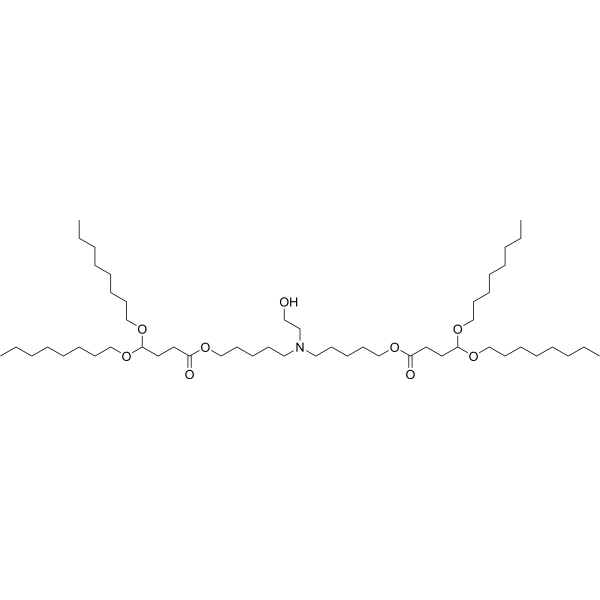
-
- HY-133952
-
|
|
Liposome
|
Cancer
|
|
7-Oxotridecanedioic acid is a biodegradable cationic lipid intermediate compound for lipid nanoparticles formation. 7-Oxotridecanedioic acid can be incorporated into a lipid particle for delivering active agents .
|
-
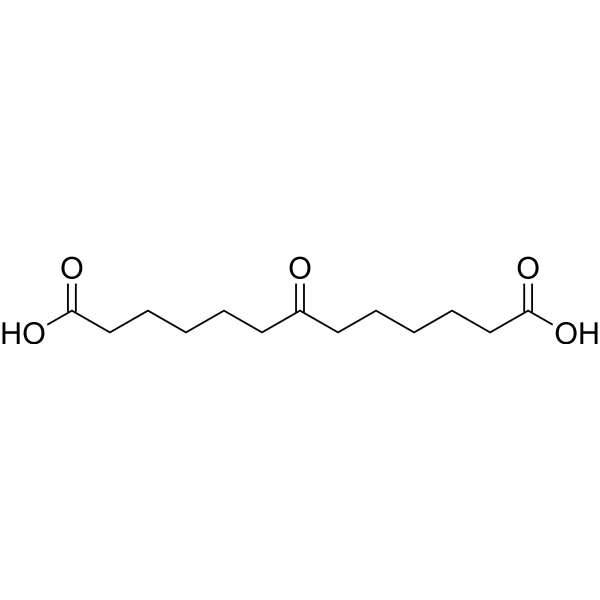
-
- HY-W440779
-
|
|
Liposome
|
Metabolic Disease
|
|
BP Lipid 135 is a cationieally ionizable lipid. BP Lipid 135 can be used to prepare lipid nanoparticles (LNP) (WO2022218503A1) .
|
-
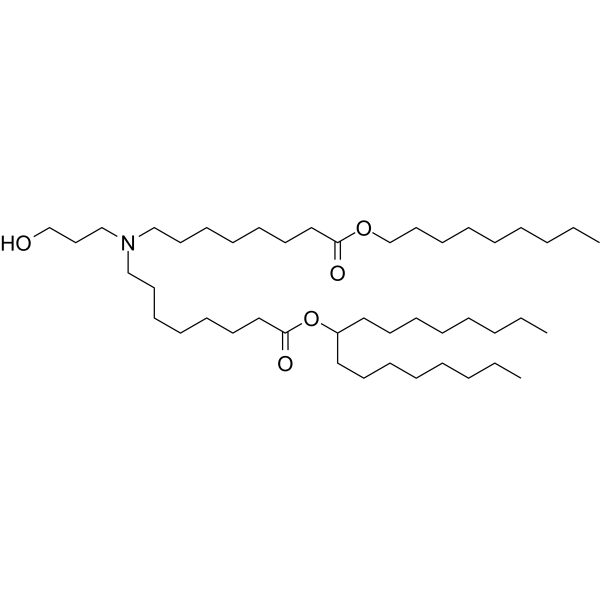
-
- HY-153375
-
|
|
Liposome
|
Others
|
|
LNP Lipid-5 (Compound Lipid 2) is an ionizable lipid (amino lipid). LNP Lipid-5 can be used to prepare lipid nanoparticles (LNP) .
|
-

-
- HY-153376
-
|
|
Liposome
|
Others
|
|
LNP Lipid-6 (Compound Lipid 5) is an ionizable lipid (amino lipid). LNP Lipid-6 can be used to prepare lipid nanoparticles (LNP) .
|
-
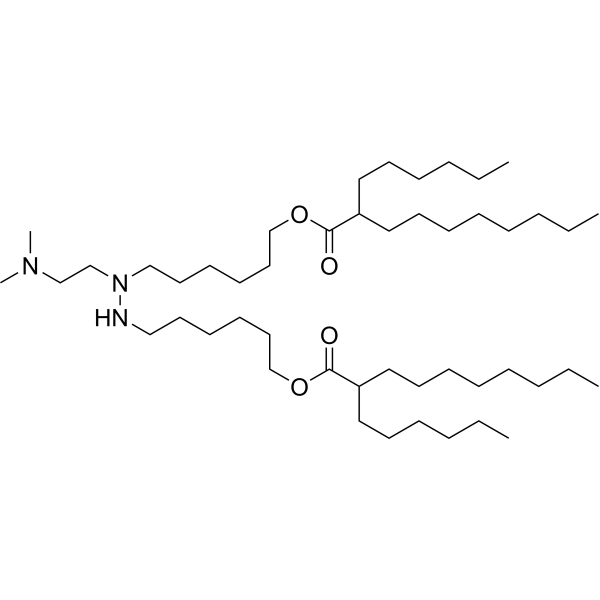
-
- HY-141629
-
|
Sphingomyelin 16:0
|
Liposome
Endogenous Metabolite
|
Others
|
|
N-Palmitoyl-D-sphingomyelin (Sphingomyelin 16:0) (Compound SM-03) can be used for the synthesis of lipid nanoparticles .
|
-
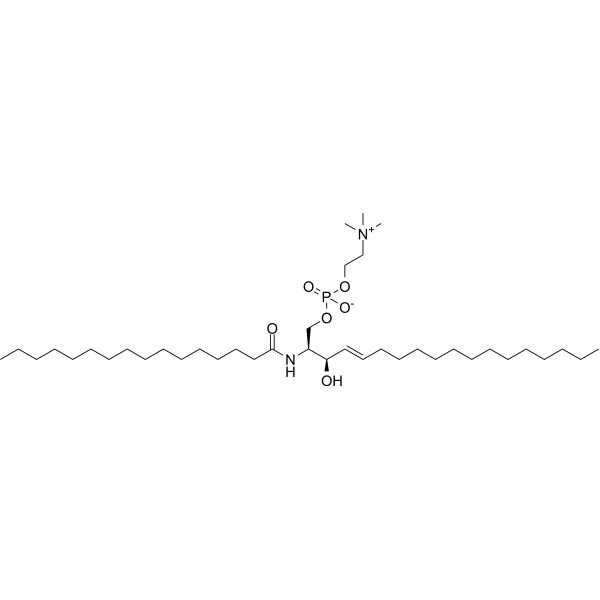
-
- HY-W040193
-
DSPC
2 Publications Verification
1,2-Distearoyl-sn-glycero-3-PC; 1,2-Distearoyl-sn-glycero-3-phosphorylcholine
|
Liposome
|
Others
|
|
DSPC (1,2-Distearoyl-sn-glycero-3-phosphorylcholine) is a cylindrical-shaped lipid. DSPC is used to synthesize liposomes, and is the lipid component in the lipid nanoparticle (LNP) system .
|
-

-
- HY-160439
-
|
|
Liposome
|
Others
|
|
Ionizable lipid-2 (compound 1) is an ionizable lipid used for nucleic acid delivery and construct lipid nanoparticles (LNPs) .
|
-
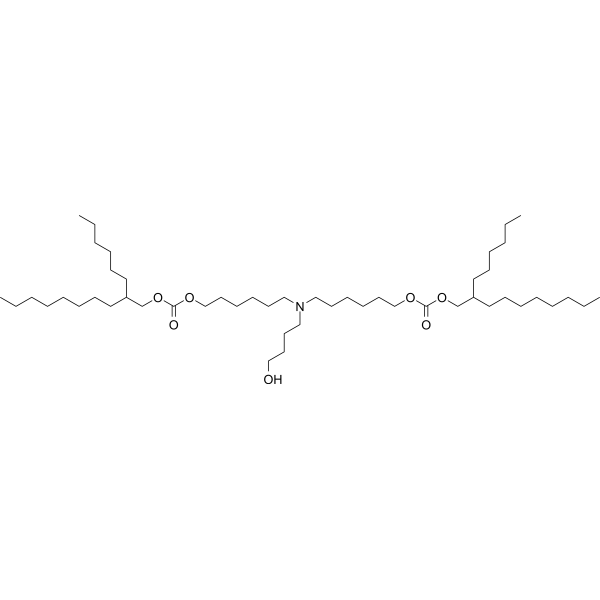
-
- HY-163044
-
|
|
Others
|
Infection
|
|
C12-SPM is a lipid nanoparticle that mediates siRNA delivery. C12-SPM has no significant cytotoxicity and can be used for research on hepatoviral diseases .
|
-
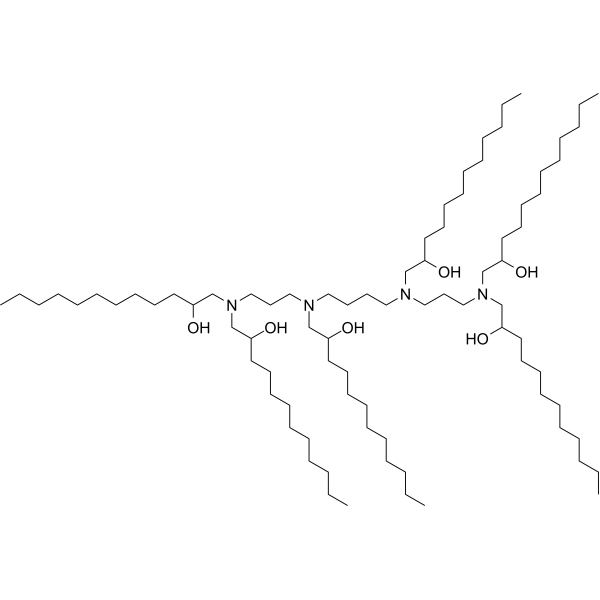
-
- HY-134541
-
SM-102
Maximum Cited Publications
7 Publications Verification
|
Liposome
|
Infection
|
|
SM-102 is an amino cationic lipid useful in the formation of lipid nanoparticles (LNPs). SM-102 has higher transfection efficiency. SM-102 plays an important role in the effectiveness of lipid nanoparticles (LNPs) in delivering mRNA therapeutics and vaccines .
|
-

-
- HY-W441014
-
|
|
Liposome
|
Others
|
|
DSPE-PEG-NHS, MW 2000 is a pegylated phospholipid derivatives which can be used to prepare liposome or lipid nanoparticles for targeted drug delivery system, such as DNA or mRNA vaccine.
|
-
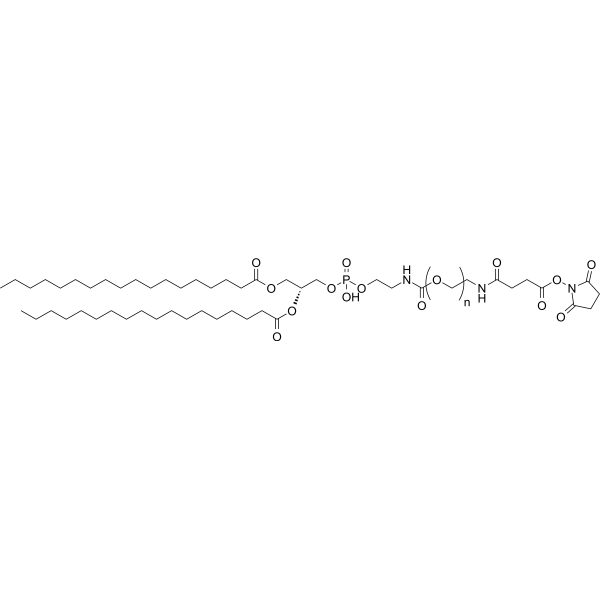
-
- HY-143700
-
-
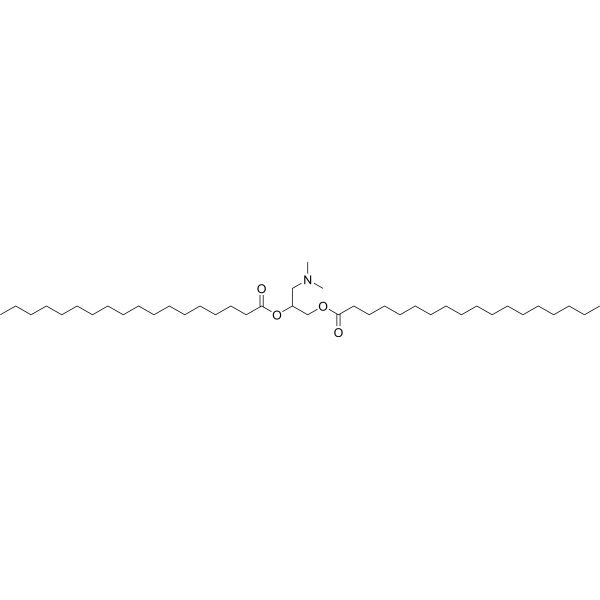
-
- HY-157252
-
|
|
Liposome
|
Cancer
|
|
CL4F8-6 is an ionizable cationic lipid with a pKa of 6.14. CL4F8-6 can be used in lipid nanoparticles (LNPs)-based mRNA therapeutics. CL4F8-6 LNPs carrying Cas9 mRNA and sgRNA could induce CRISPR-mediated gene knockdown in mice .
|
-
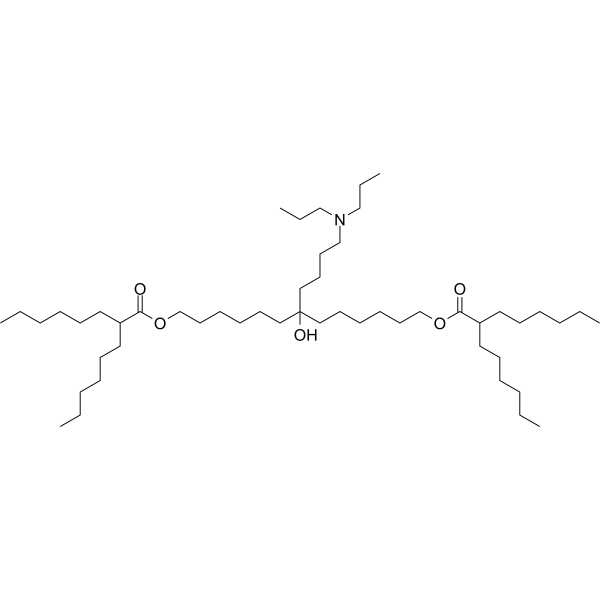
-
- HY-151507
-
|
|
Liposome
|
Others
|
|
306Oi10 is a branched-chain ionizable lipidoid that can be used for constructing lipid nanoparticles (LNPs) for the delivery of messenger RNA .
|
-
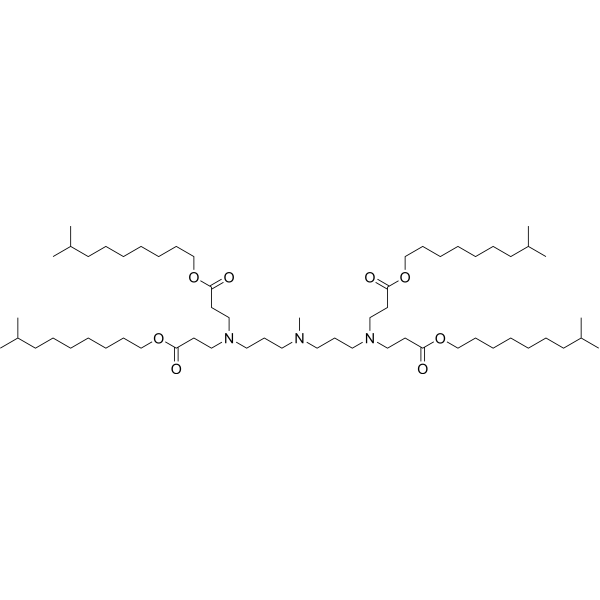
-
- HY-138170
-
ALC-0315
Maximum Cited Publications
7 Publications Verification
|
Liposome
SARS-CoV
|
Infection
|
|
ALC-0315 is an ionisable aminolipid that is responsible for mRNA compaction and aids mRNA cellular delivery and its cytoplasmic release through suspected endosomal destabilization. ALC-0315 can be used to form lipid nanoparticle (LNP) delivery vehicles. Lipid-Nanoparticles have been used in the research of mRNA COVID-19 vaccine .
|
-
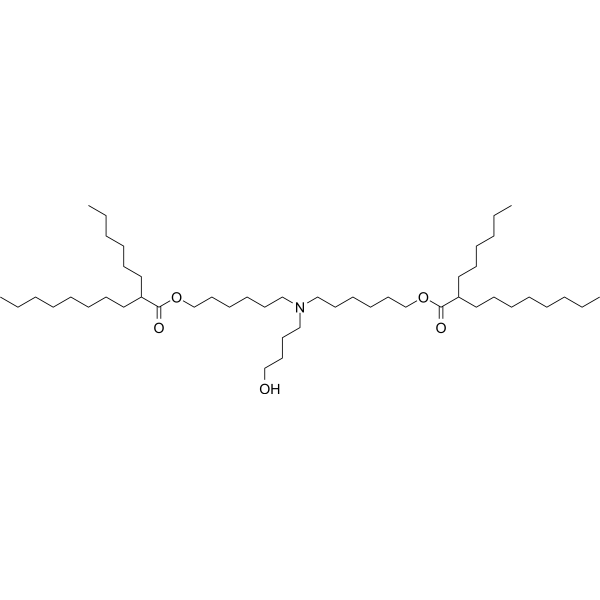
-
- HY-154974
-
|
|
Liposome
|
Cancer
|
|
LNP Lipid-8 (11-A-M) is an ionizable lipid, which can be used for lipid nanoparticles (LNP) to deliver siRNA to T cells without targeting to ligands. LNP LIPs-8 loaded with GFP siRNA (siGFP), and significantly causes GFP gene silencing in mice model .
|
-

-
- HY-151508
-
|
|
Liposome
|
Cancer
|
|
Diamino lipid DAL4 is diamino lipid for the preparation of lipid nanoparticles (LNPs) encapsulated with mRNAs encoding cytokines including IL-12, IL-27 and GM-CSF. Diamino lipid DAL4 delivers mRNA to tumor cells to exert anti-tumor activity .
|
-
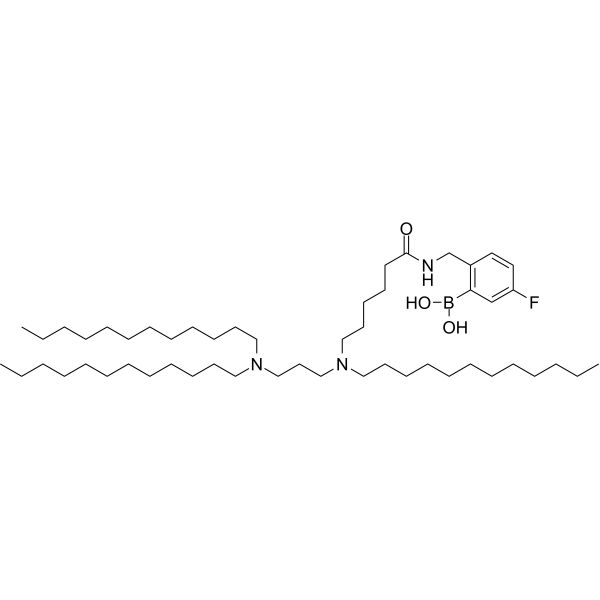
-
- HY-148363
-
|
|
Liposome
|
Inflammation/Immunology
|
|
Heptadecan-9-yl 8-((6-(decyloxy)-6-oxohexyl)(2-hydroxyethyl)amino)octanoate can be used in lipid nanoparticles (LNP) delivery systems for mRNA vaccine delivery .
|
-
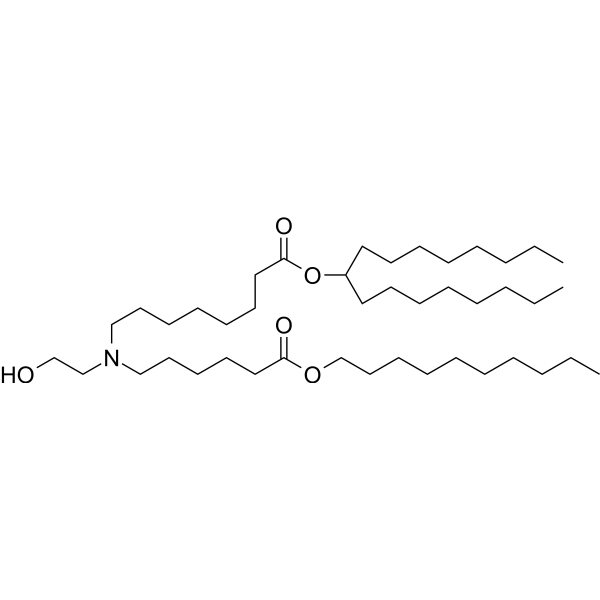
-
- HY-W440835
-
|
|
Liposome
|
Others
|
|
DSPE-PEG-DBCO, MW 2000 is a phospholipid-PEG polymer that can be used to form micelles as lipid nanoparticles for drug delivery . DSPE-PEG-DBCO, MW 2000 is a click chemistry reagent, it contains a DBCO group that can undergo strain-promoted alkyne-azide cycloaddition (SPAAC) with molecules containing Azide groups.
|
-
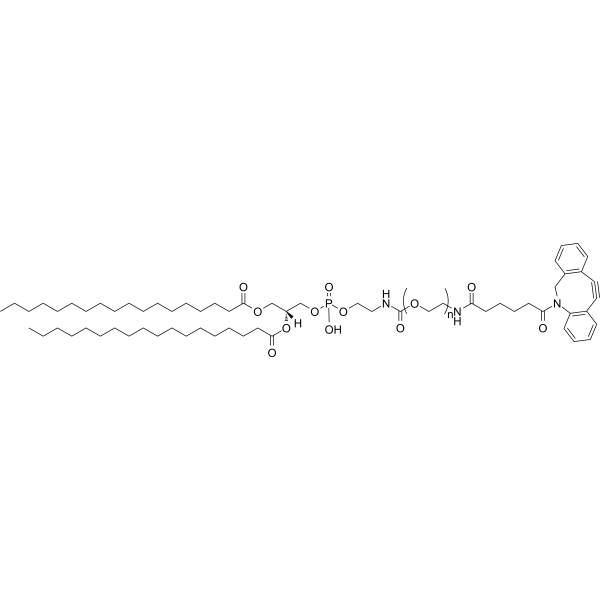
-
- HY-160552
-
|
|
Liposome
|
Others
|
|
244cis, a piperazine-containing ionizable cationic lipid, has been used to generate lipid nanoparticles (LNPs). LNPs containing 244cis and coated with mRNA reporter gene were specifically accumulated in mouse lungs compared with LNPs containing SM-102. Induces a decrease in serum chemokine (C-C motif) ligand 2 (CCL2) levels .
|
-
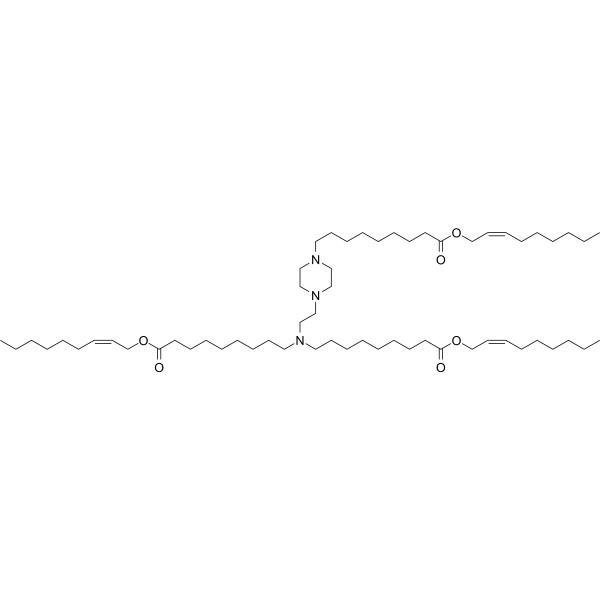
-
- HY-156985
-
|
|
Isotope-Labeled Compounds
Liposome
|
Others
|
|
Lipid AX4 is an ionizable cationic lipid with the pKa of 6.89, and can be used the study for the formation of lipid nanoparticles (LNPs) for the delivery of mRNA in vivo .
|
-
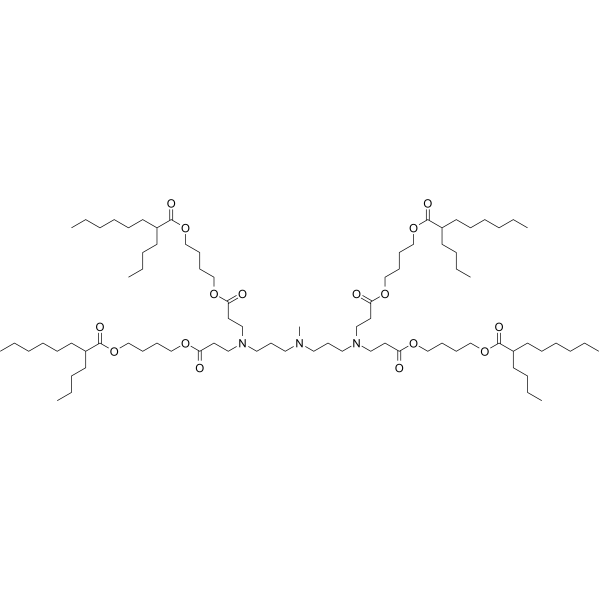
-
- HY-125924
-
|
DSPE-PEG-NH2, MW 2000 ammonium
|
Liposome
|
Others
|
|
DSPE-PEG-Amine, MW 2000 (ammonium), an amine derivative of phospholipid poly ethylene glycol, is used in the synthesis of solid lipid and thermosensitive liposomal nanoparticles for the delivery of anticancer agents .
|
-
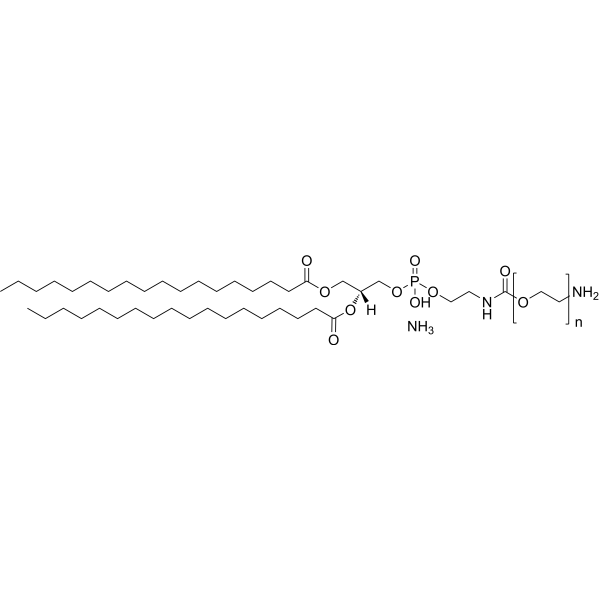
-
- HY-139306
-
|
|
Liposome
|
Inflammation/Immunology
|
|
BAMEAO16B is a lipid nanoparticle. BAMEAO16B integrated with disulfide bonds, can efficiently deliver Cas9 mRNA and sgRNA into cells while releasing RNA in response to the reductive intracellular environment for genome editing. BAMEAO16B can be used for the research of gene editing .
|
-
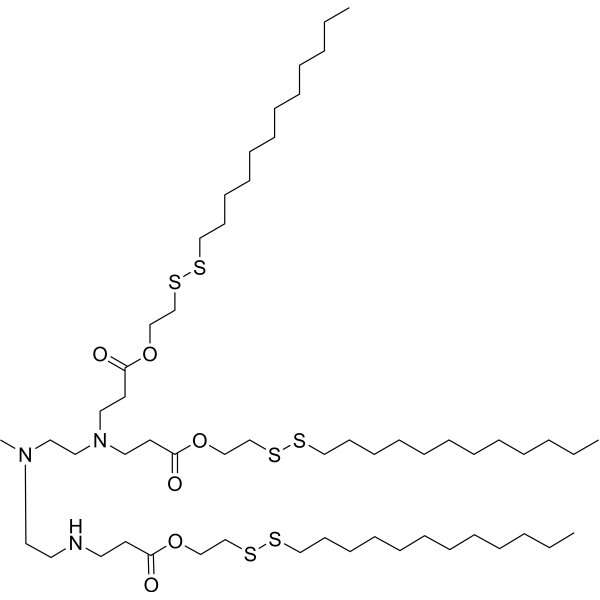
-
- HY-W414069
-
|
|
Endogenous Metabolite
Liposome
|
Others
|
|
Thiocholesterol is a member of the class of cholesteric liquid crystals (CLCs) that can be used to synthesis cationic lipid. Thiocholesterol is a stronger stabilizer of silver nanoparticles (SNPs). Thiocholesterol can be used for plasma membrane research and drug delivery .
|
-

-
- HY-147332
-
|
|
Liposome
|
Neurological Disease
|
|
TCL053 is an ionizable lipid carrier and used to introduce active components, in particular nucleic acids, into cells with excellent efriciency. TCL053, together with DPPC (Dipalmitoylphosphatidylcholine), PEG-DMG (Polyethylene glycoldimyristoyl glycerol), and cholesterol, forms lipid nanoparticle (LNP) which is able to deliver Cas9 mRNA and sgRNA into skeletal muscle .
|
-
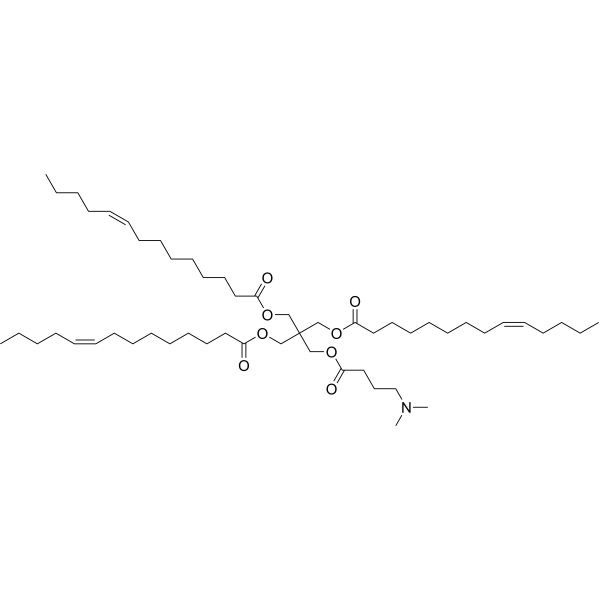
-
- HY-150116
-
|
|
Liposome
|
Others
|
|
Lipid 1 is an ionizable amino lipid used for the generation of Lipid nanoparticles (LNPs).
|
-
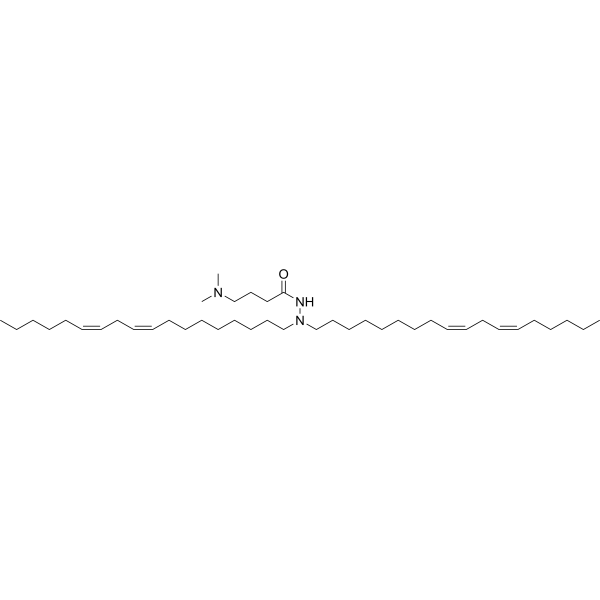
-
- HY-150115
-
|
|
Liposome
|
Others
|
|
Lipid 10 is an ionizable amino lipid used for the generation of Lipid nanoparticles (LNPs).
|
-
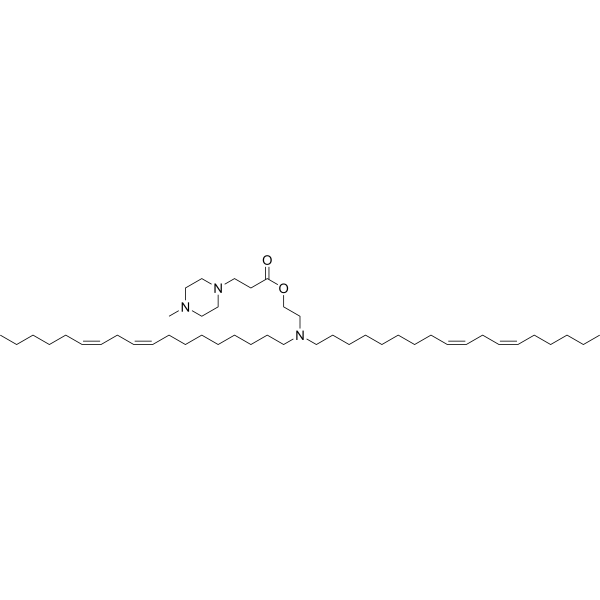
-
- HY-153378
-
|
|
Liposome
|
Others
|
|
Lipid 15 is an ionizable amino lipid used for the generation of Lipid nanoparticles (LNPs).
|
-
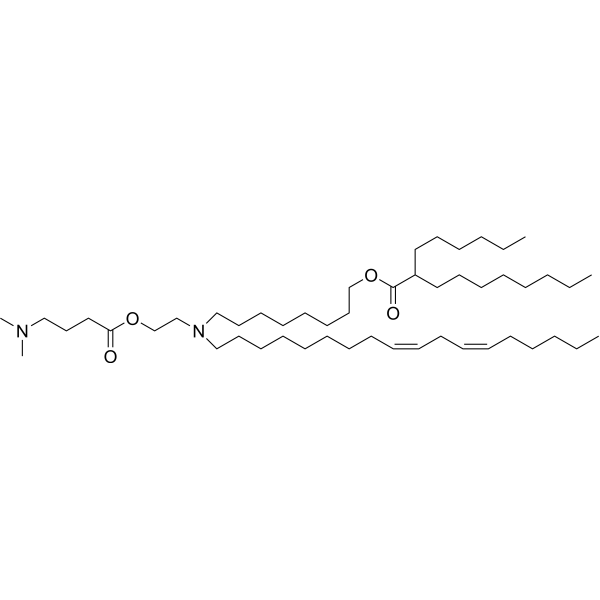
-
- HY-150117
-
|
|
Liposome
|
Others
|
|
Lipid 6 is an ionizable amino lipid used for the generation of Lipid nanoparticles (LNPs).
|
-
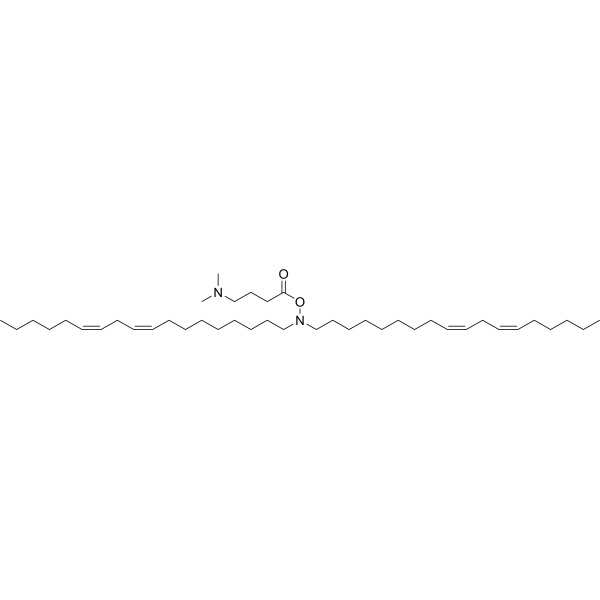
-
- HY-150118
-
|
|
Liposome
|
Others
|
|
Lipid 8 is an ionizable amino lipid used for the generation of Lipid nanoparticles (LNPs).
|
-
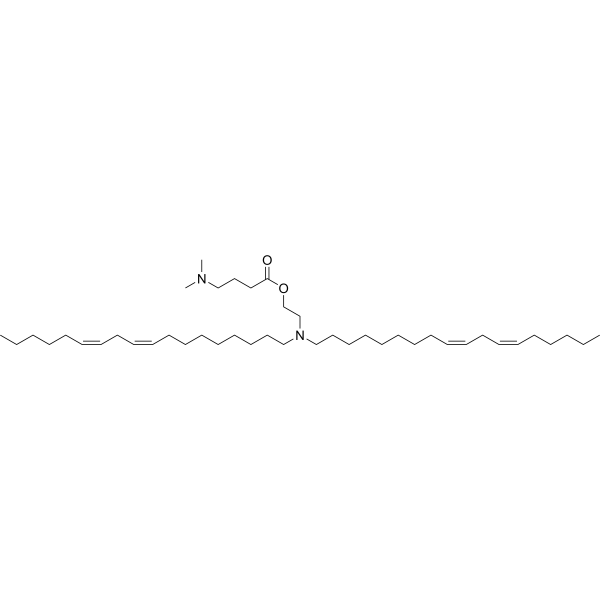
-
- HY-153377
-
-
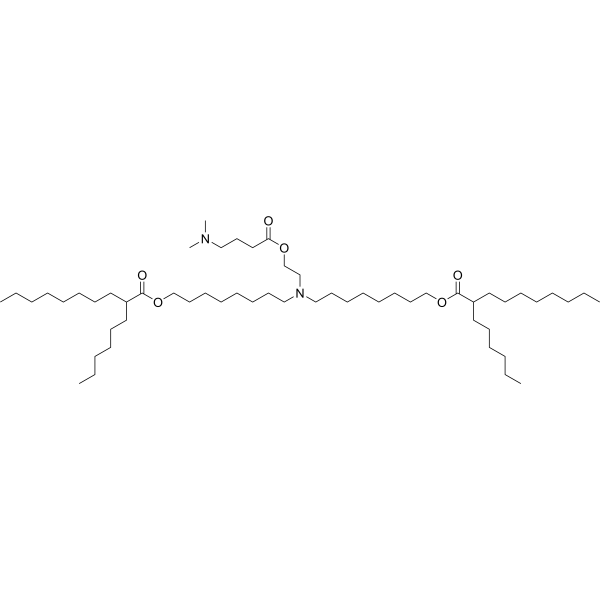
-
- HY-153186
-
|
|
Liposome
|
Others
|
|
LNP Lipid-3 is an ionizable lipid extracted from patent WO2021113777A, and can be used for the generation of Lipid nanoparticles (LNPs).
|
-

-
- HY-134782
-
|
|
Liposome
|
Others
|
|
OF-Deg-Lin is an ionizable amino lipid used for the generation of Lipid nanoparticles (LNPs).
|
-
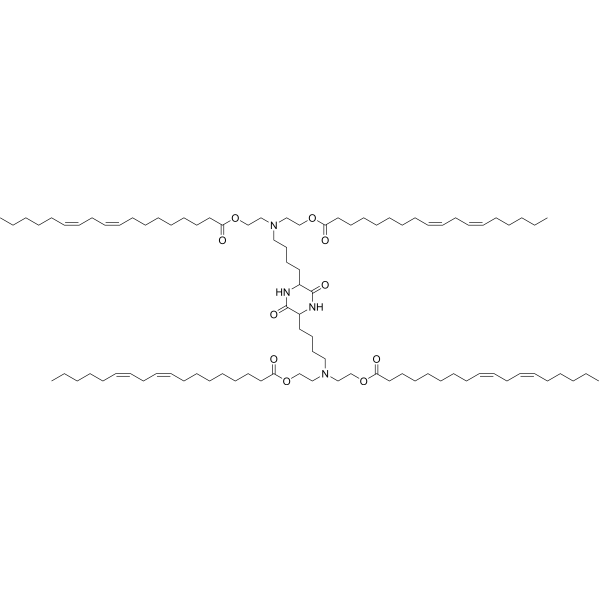
-
- HY-153852
-
|
|
Liposome
|
Others
|
|
1LNP Lipid-7 (Compound 7013) is a lipid. LNP Lipid-6 can be used to prepare lipid nanoparticles (LNP) and for drug delivery .
|
-
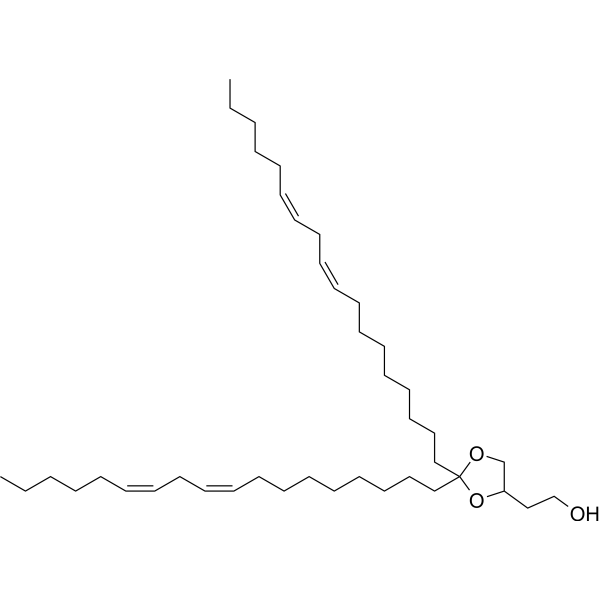
-
- HY-153373
-
|
|
Liposome
|
Others
|
|
4A3-Cit is an ionizable lipid used for the generation of lipid nanoparticles (LNPs).
|
-

-
- HY-160705
-
|
|
Liposome
|
|
|
PNI 132, an ionizable lipid derived from the patent WO2020252589A, is useful in the formulation of lipid nanoparticles.
|
-
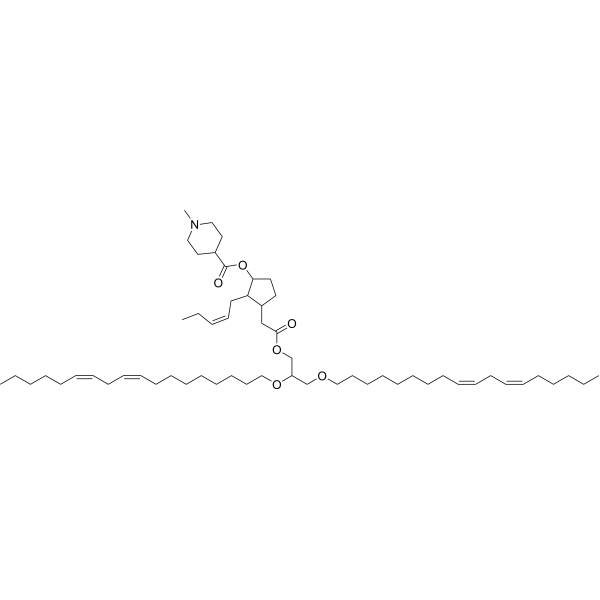
-
- HY-144012A
-
|
DPPE-PEG350; 1,2-Dipalmitoyl-sn-glycero-3-phosphoethanolamine-N-[methoxy(polyethylene glycol)-350] ammonium
|
Liposome
|
Others
|
|
16:0 PEG350 PE is a PEG lipid functional end group used in the synthesis of liposomes (LPs) for the design of conjugated polymer nanoparticles. Through biotin modification and carboxyl terminus, lipid nanoparticles (LNPs) further coupling with other biomolecules can be achieved. Functionalized nanoparticles can be used for targeted labeling of specific cellular proteins. With streptavidin as a linker, biotinylated PEG lipid-conjugated polymer nanoparticles are able to bind to biotinylated antibodies on cell surface receptors, yielding the utility of fluorescence-based imaging and sensing.
|
-
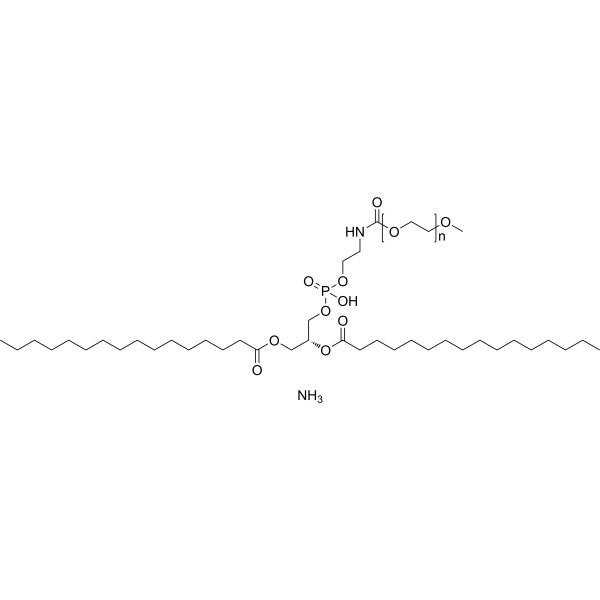
-
- HY-144012B
-
|
DPPE-PEG550; 1,2-Dipalmitoyl-sn-glycero-3-phosphoethanolamine-N-[methoxy(polyethylene glycol)-550] ammonium
|
Biochemical Assay Reagents
Liposome
|
Others
|
|
16:0 PEG550 PE is a PEG lipid functional end group used in the synthesis of liposomes (LPs) for the design of conjugated polymer nanoparticles. Through biotin modification and carboxyl terminus, lipid nanoparticles (LNPs) further coupling with other biomolecules can be achieved. Functionalized nanoparticles can be used for targeted labeling of specific cellular proteins. With streptavidin as a linker, biotinylated PEG lipid-conjugated polymer nanoparticles are able to bind to biotinylated antibodies on cell surface receptors, yielding the utility of fluorescence-based imaging and sensing.
|
-
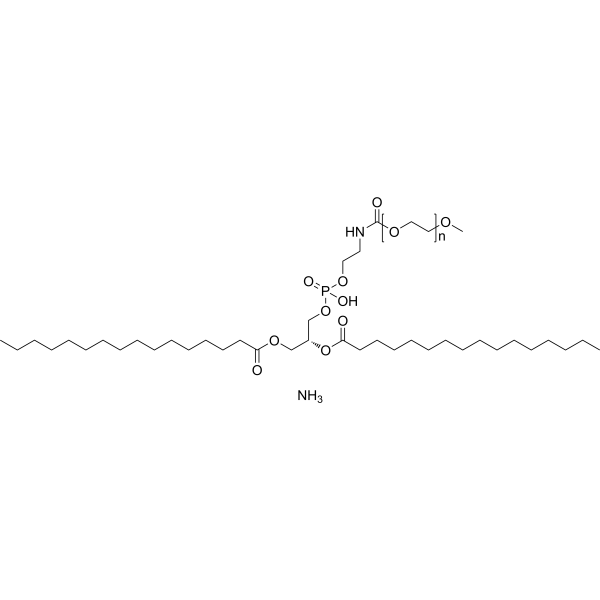
-
- HY-144012C
-
|
DPPE-PEG750; 1,2-Dipalmitoyl-sn-glycero-3-phosphoethanolamine-N-[methoxy(polyethylene glycol)-750] ammonium
|
Biochemical Assay Reagents
Liposome
|
Others
|
|
16:0 PEG750 PE is a PEG lipid functional end group used in the synthesis of liposomes (LPs) for the design of conjugated polymer nanoparticles. Through biotin modification and carboxyl terminus, lipid nanoparticles (LNPs) further coupling with other biomolecules can be achieved. Functionalized nanoparticles can be used for targeted labeling of specific cellular proteins. With streptavidin as a linker, biotinylated PEG lipid-conjugated polymer nanoparticles are able to bind to biotinylated antibodies on cell surface receptors, yielding the utility of fluorescence-based imaging and sensing.
|
-

-
- HY-144013A
-
|
DSPE-mPEG350 ammonium; 1,2-Distearoyl-sn-glycero-3-phosphoethanolamine-N-[methoxy(polyethylene glycol)-350] ammonium
|
Liposome
|
Others
|
|
18:0 mPEG350 PE (ammonium) is a PEG lipid functional end group used in the synthesis of liposomes (LPs) for the design of conjugated polymer nanoparticles. Through biotin modification and carboxyl terminus, lipid nanoparticles (LNPs) further coupling with other biomolecules can be achieved. Functionalized nanoparticles can be used for targeted labeling of specific cellular proteins. With streptavidin as a linker, biotinylated PEG lipid-conjugated polymer nanoparticles are able to bind to biotinylated antibodies on cell surface receptors, yielding the utility of fluorescence-based imaging and sensing.
|
-
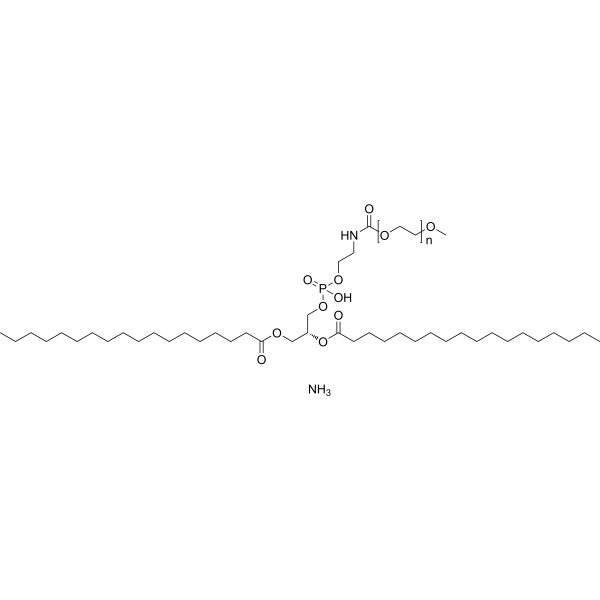
-
- HY-144013B
-
|
DSPE-mPEG550 ammonium; 1,2-Distearoyl-sn-glycero-3-phosphoethanolamine-N-[methoxy(polyethylene glycol)-550] ammonium
|
Biochemical Assay Reagents
Liposome
|
Others
|
|
18:0 mPEG550 PE (ammonium) is a PEG lipid functional end group used in the synthesis of liposomes (LPs) for the design of conjugated polymeric nanoparticles. Through biotin modification and carboxyl terminus, lipid nanoparticles (LNPs) further coupling with other biomolecules can be achieved. Functionalized nanoparticles can be used for targeted labeling of specific cellular proteins. With streptavidin as a linker, biotinylated PEG lipid-conjugated polymer nanoparticles are able to bind to biotinylated antibodies on cell surface receptors, yielding the utility of fluorescence-based imaging and sensing.
|
-

-
- HY-144013C
-
|
DSPE-mPEG750 ammonium; 1,2-Distearoyl-sn-glycero-3-phosphoethanolamine-N-[methoxy(polyethylene glycol)-750] ammonium
|
Biochemical Assay Reagents
Liposome
|
Others
|
|
18:0 mPEG750 PE (ammonium) is a PEG lipid functional end group used in the synthesis of liposomes (LPs) for the design of conjugated polymeric nanoparticles. Through biotin modification and carboxyl terminus, lipid nanoparticles (LNPs) further coupling with other biomolecules can be achieved. Functionalized nanoparticles can be used for targeted labeling of specific cellular proteins. With streptavidin as a linker, biotinylated PEG lipid-conjugated polymer nanoparticles are able to bind to biotinylated antibodies on cell surface receptors, yielding the utility of fluorescence-based imaging and sensing.
|
-
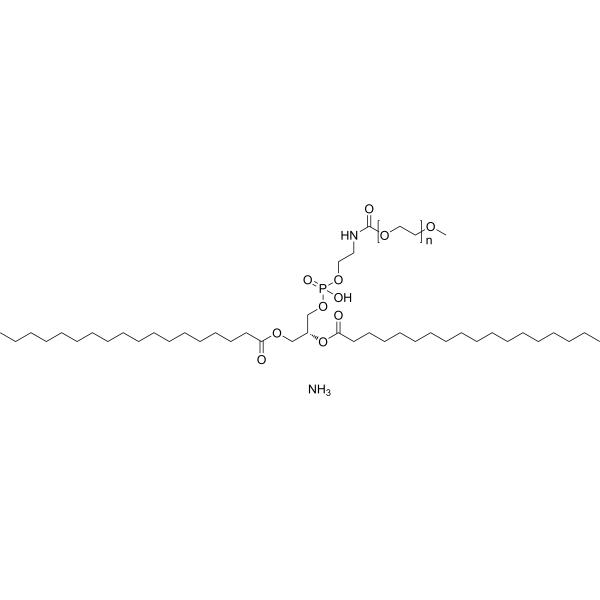
-
- HY-144012D
-
|
DPPE-PEG1000; 1,2-Dipalmitoyl-sn-glycero-3-phosphoethanolamine-N-[methoxy(polyethylene glycol)-1000] ammonium
|
Liposome
|
Others
|
|
16:0 PEG1000 PE is a PEG lipid functional end group used in the synthesis of liposomes (LPs) for the design of conjugated polymer nanoparticles. Through biotin modification and carboxyl terminus, lipid nanoparticles (LNPs) further coupling with other biomolecules can be achieved. Functionalized nanoparticles can be used for targeted labeling of specific cellular proteins. With streptavidin as a linker, biotinylated PEG lipid-conjugated polymer nanoparticles are able to bind to biotinylated antibodies on cell surface receptors, yielding the utility of fluorescence-based imaging and sensing.
|
-

-
- HY-144012E
-
|
DPPE-PEG3000; 1,2-Dipalmitoyl-sn-glycero-3-phosphoethanolamine-N-[methoxy(polyethylene glycol)-3000] ammonium
|
Liposome
|
Others
|
|
16:0 PEG3000 PE is a PEG lipid functional end group used in the synthesis of liposomes (LPs) for the design of conjugated polymer nanoparticles. Through biotin modification and carboxyl terminus, lipid nanoparticles (LNPs) further coupling with other biomolecules can be achieved. Functionalized nanoparticles can be used for targeted labeling of specific cellular proteins. With streptavidin as a linker, biotinylated PEG lipid-conjugated polymer nanoparticles are able to bind to biotinylated antibodies on cell surface receptors, yielding the utility of fluorescence-based imaging and sensing.
|
-
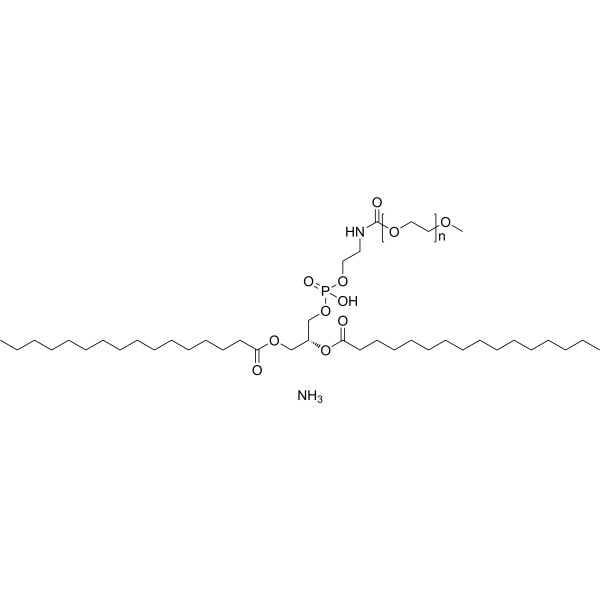
-
- HY-144012H
-
|
DPPE-PEG5000; 1,2-Dipalmitoyl-sn-glycero-3-phosphoethanolamine-N-[methoxy(polyethylene glycol)-5000] ammonium
|
Liposome
|
Others
|
|
16:0 PEG5000 PE is a PEG lipid functional end group used in the synthesis of liposomes (LPs) for the design of conjugated polymer nanoparticles. Through biotin modification and carboxyl terminus, lipid nanoparticles (LNPs) further coupling with other biomolecules can be achieved. Functionalized nanoparticles can be used for targeted labeling of specific cellular proteins. With streptavidin as a linker, biotinylated PEG lipid-conjugated polymer nanoparticles are able to bind to biotinylated antibodies on cell surface receptors, yielding the utility of fluorescence-based imaging and sensing.
|
-
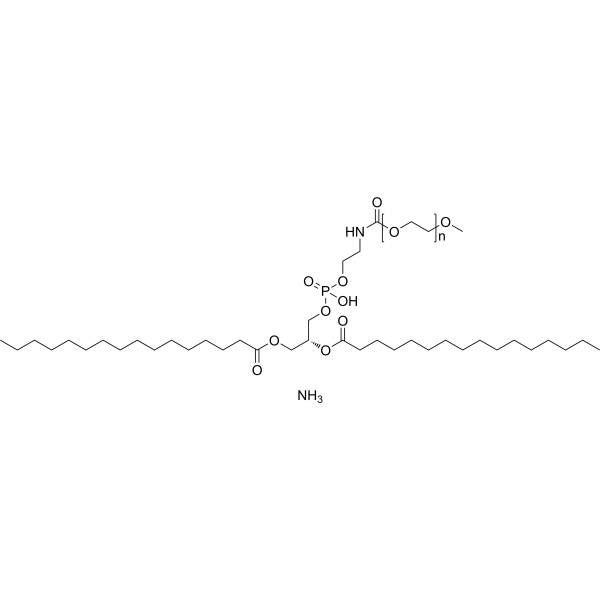
-
- HY-144013D
-
|
DSPE-mPEG1000 ammonium; 1,2-Distearoyl-sn-glycero-3-phosphoethanolamine-N-[methoxy(polyethylene glycol)-1000] ammonium
|
Liposome
|
Others
|
|
18:0 mPEG1000 PE (ammonium) is a PEG lipid functional end group used in the synthesis of liposomes (LPs) for the design of conjugated polymeric nanoparticles. Through biotin modification and carboxyl terminus, lipid nanoparticles (LNPs) further coupling with other biomolecules can be achieved. Functionalized nanoparticles can be used for targeted labeling of specific cellular proteins. With streptavidin as a linker, biotinylated PEG lipid-conjugated polymer nanoparticles are able to bind to biotinylated antibodies on cell surface receptors, yielding the utility of fluorescence-based imaging and sensing.
|
-
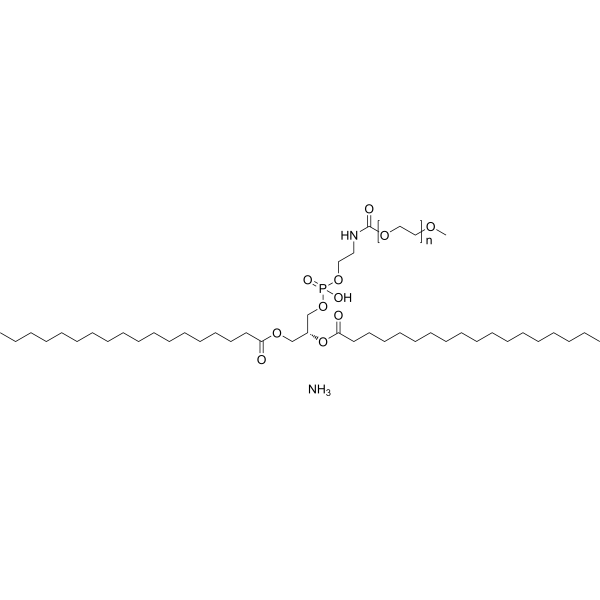
-
- HY-144013E
-
|
DSPE-mPEG3000 ammonium; 1,2-Distearoyl-sn-glycero-3-phosphoethanolamine-N-[methoxy(polyethylene glycol)-3000] ammonium
|
Liposome
|
Others
|
|
18:0 mPEG3000 PE (ammonium) is a PEG lipid functional end group used in the synthesis of liposomes (LPs) for the design of conjugated polymeric nanoparticles. Through biotin modification and carboxyl terminus, lipid nanoparticles (LNPs) further coupling with other biomolecules can be achieved. Functionalized nanoparticles can be used for targeted labeling of specific cellular proteins. With streptavidin as a linker, biotinylated PEG lipid-conjugated polymer nanoparticles are able to bind to biotinylated antibodies on cell surface receptors, yielding the utility of fluorescence-based imaging and sensing.
|
-

-
- HY-144013H
-
|
DSPE-mPEG5000 ammonium; 1,2-Distearoyl-sn-glycero-3-phosphoethanolamine-N-[methoxy(polyethylene glycol)-5000] ammonium
|
Liposome
|
Others
|
|
18:0 mPEG5000 PE (ammonium) is a PEG lipid functional end group used in the synthesis of liposomes (LPs) for the design of conjugated polymeric nanoparticles. Through biotin modification and carboxyl terminus, lipid nanoparticles (LNPs) further coupling with other biomolecules can be achieved. Functionalized nanoparticles can be used for targeted labeling of specific cellular proteins. With streptavidin as a linker, biotinylated PEG lipid-conjugated polymer nanoparticles are able to bind to biotinylated antibodies on cell surface receptors, yielding the utility of fluorescence-based imaging and sensing.
|
-
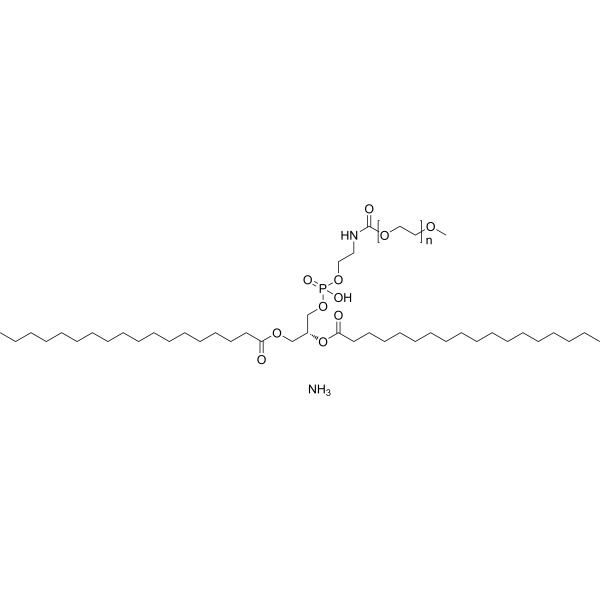
- HY-155924
-
|
DMPE-PEG350; 1,2-Dimyristoyl-sn-glycero-3-phosphoethanolamine-N-[methoxy(polyethylene glycol)-350] ammonium
|
Liposome
|
Others
|
|
14:0 PEG350 PE is a PEG lipid functional end group used in the synthesis of liposomes (LPs) for the design of conjugated polymer nanoparticles. Through biotin modification and carboxyl terminus, lipid nanoparticles (LNPs) further coupling with other biomolecules can be achieved. Functionalized nanoparticles can be used for targeted labeling of specific cellular proteins. With streptavidin as a linker, biotinylated PEG lipid-conjugated polymer nanoparticles are able to bind to biotinylated antibodies on cell surface receptors, yielding the utility of fluorescence-based imaging and sensing.
|
-

- HY-155925
-
|
DMPE-PEG550; 1,2-Dimyristoyl-sn-glycero-3-phosphoethanolamine-N-[methoxy(polyethylene glycol)-550] ammonium
|
Liposome
|
Others
|
|
14:0 PEG550 PE is a PEG lipid functional end group used in the synthesis of liposomes (LPs) for the design of conjugated polymeric nanoparticles. Through biotin modification and carboxyl terminus, lipid nanoparticles (LNPs) further coupling with other biomolecules can be achieved. Functionalized nanoparticles can be used for targeted labeling of specific cellular proteins. With streptavidin as a linker, biotinylated PEG lipid-conjugated polymer nanoparticles are able to bind to biotinylated antibodies on cell surface receptors, yielding the utility of fluorescence-based imaging and sensing.
|
-
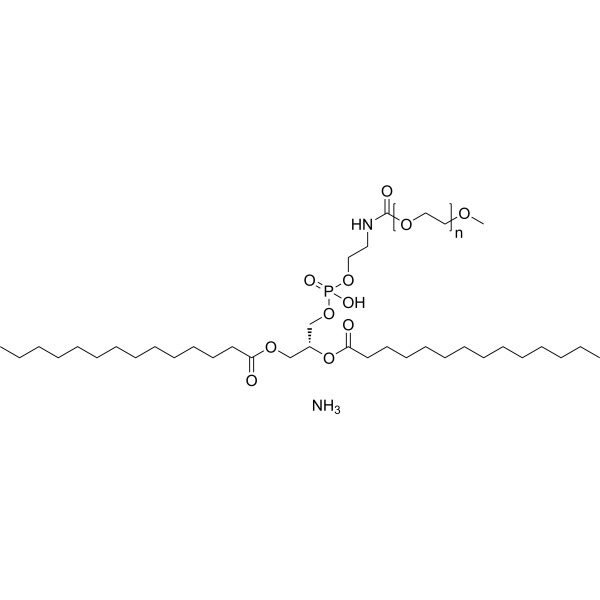
- HY-155926
-
|
DMPE-PEG750; 1,2-Dimyristoyl-sn-glycero-3-phosphoethanolamine-N-[methoxy(polyethylene glycol)-750] ammonium
|
Liposome
|
Others
|
|
14:0 PEG750 PE is a PEG lipid functional end group used in the synthesis of liposomes (LPs) for the design of conjugated polymeric nanoparticles. Through biotin modification and carboxyl terminus, lipid nanoparticles (LNPs) further coupling with other biomolecules can be achieved. Functionalized nanoparticles can be used for targeted labeling of specific cellular proteins. With streptavidin as a linker, biotinylated PEG lipid-conjugated polymer nanoparticles are able to bind to biotinylated antibodies on cell surface receptors, yielding the utility of fluorescence-based imaging and sensing.
|
-
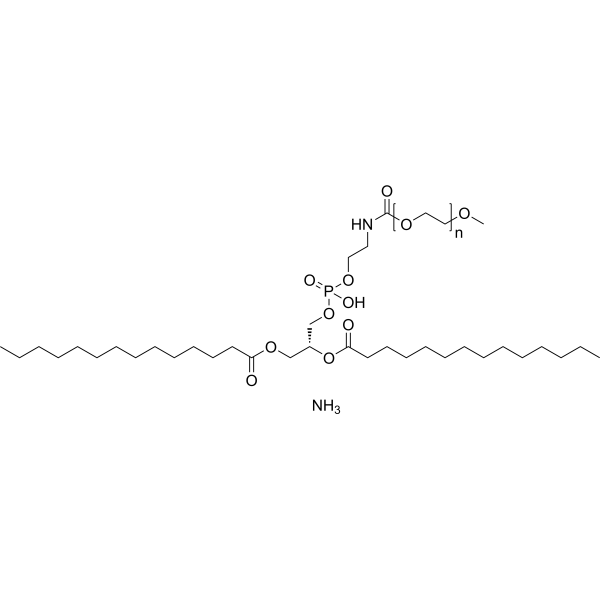
- HY-155927
-
|
DMPE-PEG1000; 1,2-Dimyristoyl-sn-glycero-3-phosphoethanolamine-N-[methoxy(polyethylene glycol)-1000] ammonium
|
Liposome
|
Others
|
|
14:0 PEG1000 PE is a PEG lipid functional end group used in the synthesis of liposomes (LPs) for the design of conjugated polymer nanoparticles. Through biotin modification and carboxyl terminus, lipid nanoparticles (LNPs) further coupling with other biomolecules can be achieved. Functionalized nanoparticles can be used for targeted labeling of specific cellular proteins. With streptavidin as a linker, biotinylated PEG lipid-conjugated polymer nanoparticles are able to bind to biotinylated antibodies on cell surface receptors, yielding the utility of fluorescence-based imaging and sensing.
|
-
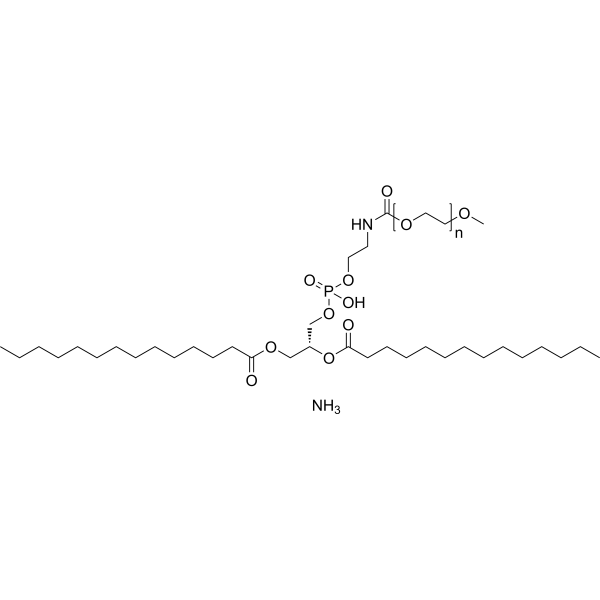
- HY-155928
-
|
DMPE-PEG3000; 1,2-Dimyristoyl-sn-glycero-3-phosphoethanolamine-N-[methoxy(polyethylene glycol)-3000] ammonium
|
Liposome
|
Others
|
|
14:0 PEG3000 PE is a PEG lipid functional end group used in the synthesis of liposomes (LPs) for the design of conjugated polymer nanoparticles. Through biotin modification and carboxyl terminus, lipid nanoparticles (LNPs) further coupling with other biomolecules can be achieved. Functionalized nanoparticles can be used for targeted labeling of specific cellular proteins. With streptavidin as a linker, biotinylated PEG lipid-conjugated polymer nanoparticles are able to bind to biotinylated antibodies on cell surface receptors, yielding the utility of fluorescence-based imaging and sensing.
|
-
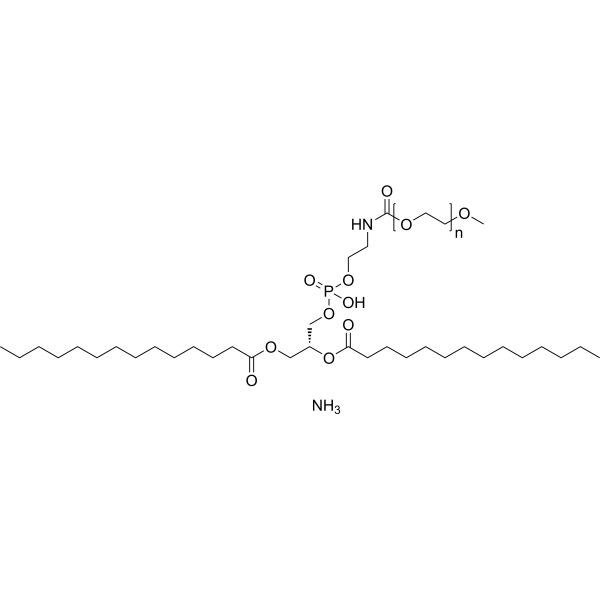
- HY-155929
-
|
DMPE-PEG5000; 1,2-Dimyristoyl-sn-glycero-3-phosphoethanolamine-N-[methoxy(polyethylene glycol)-5000] ammonium
|
Liposome
|
Others
|
|
14:0 PEG5000 PE is a PEG lipid functional end group used in the synthesis of liposomes (LPs) for the design of conjugated polymer nanoparticles. Through biotin modification and carboxyl terminus, lipid nanoparticles (LNPs) further coupling with other biomolecules can be achieved. Functionalized nanoparticles can be used for targeted labeling of specific cellular proteins. With streptavidin as a linker, biotinylated PEG lipid-conjugated polymer nanoparticles are able to bind to biotinylated antibodies on cell surface receptors, yielding the utility of fluorescence-based imaging and sensing.
|
-

- HY-155930
-
|
DOPE-PEG350; 1,2-Dioleoyl-sn-glycero-3-phosphoethanolamine-N-[methoxy(polyethylene glycol)-350] ammonium
|
Liposome
|
Others
|
|
18:1 PEG350 PE is a PEG lipid functional end group used in the synthesis of liposomes (LPs) for the design of conjugated polymer nanoparticles. Through biotin modification and carboxyl terminus, lipid nanoparticles (LNPs) further coupling with other biomolecules can be achieved. Functionalized nanoparticles can be used for targeted labeling of specific cellular proteins. With streptavidin as a linker, biotinylated PEG lipid-conjugated polymer nanoparticles are able to bind to biotinylated antibodies on cell surface receptors, yielding the utility of fluorescence-based imaging and sensing.
|
-

- HY-155931
-
|
DOPE-PEG550; 1,2-Dioleoyl-sn-glycero-3-phosphoethanolamine-N-[methoxy(polyethylene glycol)-550] ammonium
|
Liposome
|
Others
|
|
18:1 PEG550 PE is a PEG lipid functional end group used in the synthesis of liposomes (LPs) for the design of conjugated polymer nanoparticles. Through biotin modification and carboxyl terminus, lipid nanoparticles (LNPs) further coupling with other biomolecules can be achieved. Functionalized nanoparticles can be used for targeted labeling of specific cellular proteins. With streptavidin as a linker, biotinylated PEG lipid-conjugated polymer nanoparticles are able to bind to biotinylated antibodies on cell surface receptors, yielding the utility of fluorescence-based imaging and sensing.
|
-

- HY-155932
-
|
DOPE-PEG1000; 1,2-Dioleoyl-sn-glycero-3-phosphoethanolamine-N-[methoxy(polyethylene glycol)-1000] ammonium
|
Liposome
|
Others
|
|
18:1 PEG1000 PE is a PEG lipid functional end group used in the synthesis of liposomes (LPs) for the design of conjugated polymer nanoparticles. Through biotin modification and carboxyl terminus, lipid nanoparticles (LNPs) further coupling with other biomolecules can be achieved. Functionalized nanoparticles can be used for targeted labeling of specific cellular proteins. With streptavidin as a linker, biotinylated PEG lipid-conjugated polymer nanoparticles are able to bind to biotinylated antibodies on cell surface receptors, yielding the utility of fluorescence-based imaging and sensing.
|
-

- HY-155933
-
|
DOPE-PEG3000; 1,2-Dioleoyl-sn-glycero-3-phosphoethanolamine-N-[methoxy(polyethylene glycol)-3000] ammonium
|
Liposome
|
Others
|
|
18:1 PEG3000 PE is a PEG lipid functional end group used in the synthesis of liposomes (LPs) for the design of conjugated polymer nanoparticles. Through biotin modification and carboxyl terminus, lipid nanoparticles (LNPs) further coupling with other biomolecules can be achieved. Functionalized nanoparticles can be used for targeted labeling of specific cellular proteins. With streptavidin as a linker, biotinylated PEG lipid-conjugated polymer nanoparticles are able to bind to biotinylated antibodies on cell surface receptors, yielding the utility of fluorescence-based imaging and sensing.
|
-

- HY-155934
-
|
DOPE-PEG5000; 1,2-Dioleoyl-sn-glycero-3-phosphoethanolamine-N-[methoxy(polyethylene glycol)-5000] ammonium
|
Liposome
|
Others
|
|
18:1 PEG5000 PE is a PEG lipid functional end group used in the synthesis of liposomes (LPs) for the design of conjugated polymer nanoparticles. Through biotin modification and carboxyl terminus, lipid nanoparticles (LNPs) further coupling with other biomolecules can be achieved. Functionalized nanoparticles can be used for targeted labeling of specific cellular proteins. With streptavidin as a linker, biotinylated PEG lipid-conjugated polymer nanoparticles are able to bind to biotinylated antibodies on cell surface receptors, yielding the utility of fluorescence-based imaging and sensing.
|
-

- HY-149156
-
|
|
Liposome
|
Cancer
|
|
Lipid C24 is a cationic ionizable lipid, and can be used in the formation of lipid nanoparticles (LNPs). Lipid C24 can be used for research of delivery of nucleic acids .
|
-
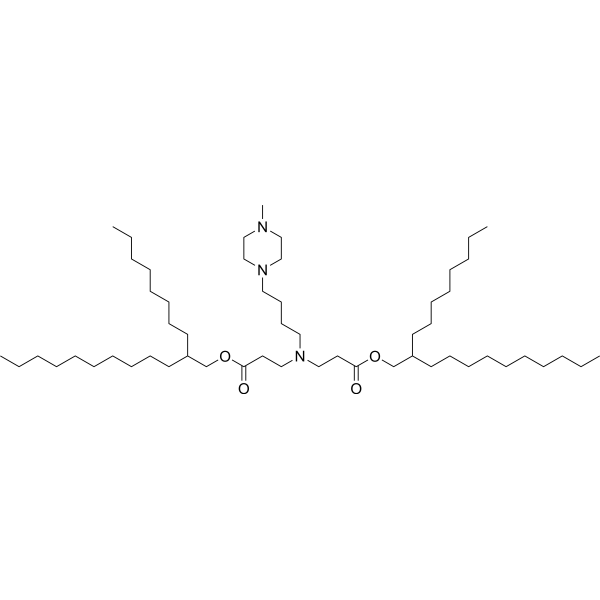
- HY-W590532
-
|
|
Liposome
|
Others
|
|
306-O12B is an ionizable cationic lipid used for the generation of lipid nanoparticles (LNPs).
|
-

- HY-W800783
-
|
CDESA
|
Liposome
|
Others
|
|
DSTAP chloride (CDESA) is a cationic lipid that used in the formation of lipid nanoparticles (LNPs). DORI chloride has high transfection efficiency .
|
-

- HY-160576
-
|
|
Liposome
|
Cancer
|
|
DNCA is a neutral lipid that can be used in the generation of lipid nanoparticles (LNPs). DNCA can be used in nucleic acid delivery .
|
-

- HY-156630
-
|
|
Liposome
|
Others
|
|
Ionizable lipid-1 (compound II-10) is an ionizable lipid (pKa=6.16) that can be used to prepare lipid nanoparticles (LNP) with bilayer structure .
|
-
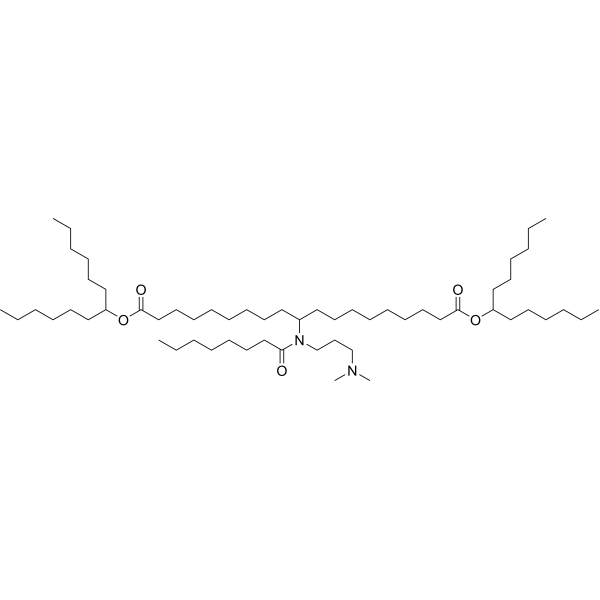
- HY-156630A
-
|
|
Liposome
|
Others
|
|
Ionizable lipid-1 (compound II-10) is an ionizable lipid (pKa=6.16) that can be used to prepare lipid nanoparticles (LNP) with bilayer structure .
|
-
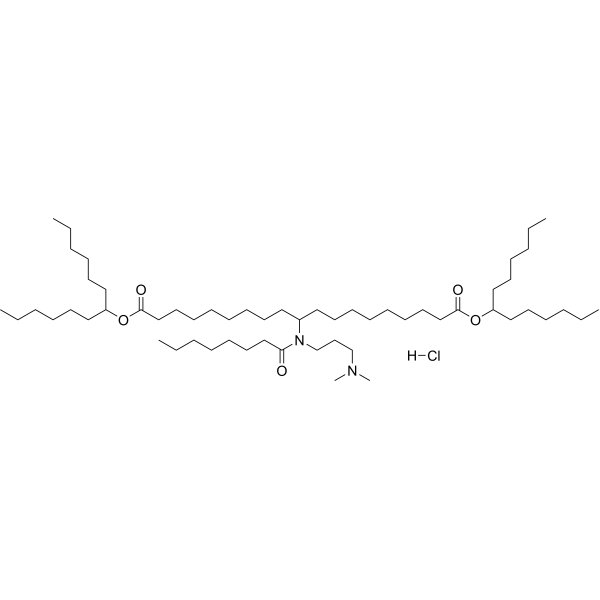
- HY-W440810
-
|
|
Liposome
|
Others
|
|
Undecyl 6-bromohexanoate can be useful for the preparation of lipid nanoparticles.
|
-
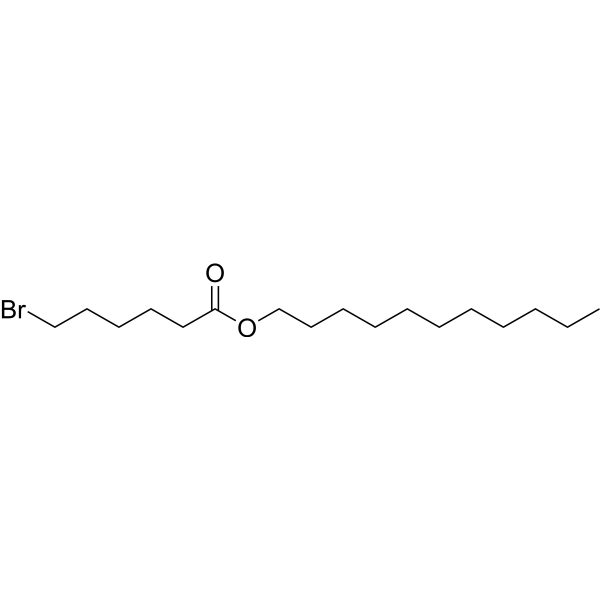
- HY-149167
-
|
|
Liposome
Biochemical Assay Reagents
|
Others
|
|
mRNA-Encapsulating Lipid Excipient 1 (Compound 2) is a Thiocarbamate-Based Ionizable Lipid. mRNA-Encapsulating Lipid Excipient 1 can be used as an excipient in mRNA-encapsulating lipid nanoparticle .
|
-

- HY-153372
-
|
|
Liposome
|
Others
|
|
93-O17S is a chalcogen-containing ionizable cationic lipid used for making lipid nanoparticles (LNPs).
|
-
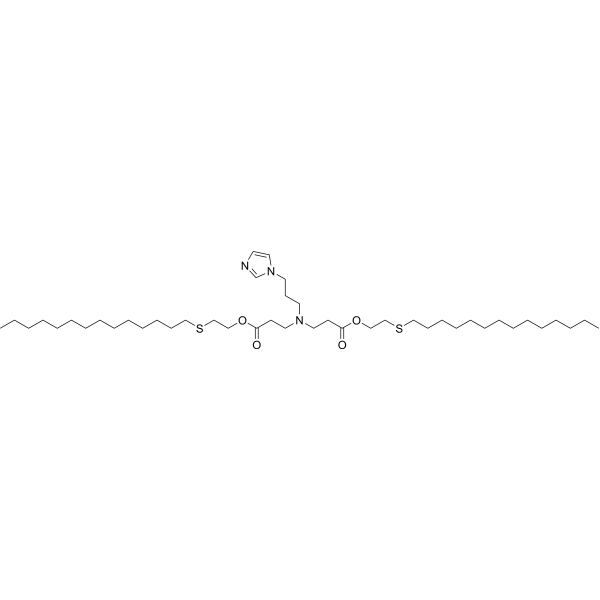
- HY-160578
-
|
N-Cholesteryl succinyl glucosamine
|
Liposome
|
Others
|
|
Glucosamine Cholesterol (N-Cholesteryl succinyl glucosamine) is a glucosamine-based lipid conjugate, and can be used in the formation of lipid nanoparticles (LNPs) .
|
-
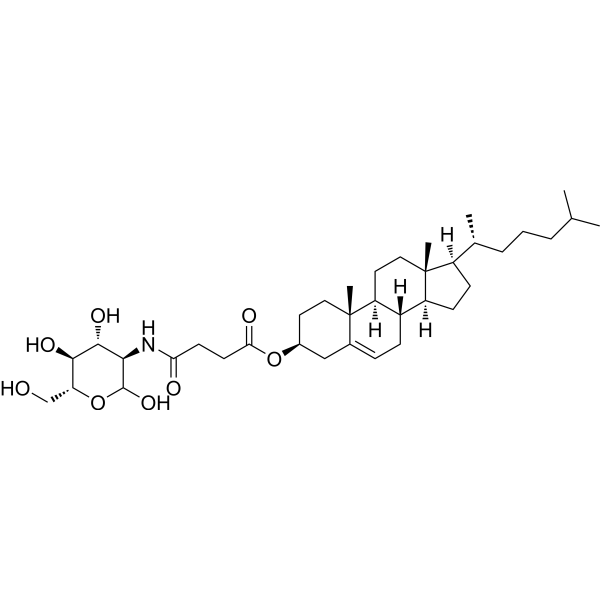
- HY-46759A
-
|
|
Liposome
|
Infection
|
|
Genevant CL1 monohydrochloride is an ionizable lipid (lipid 10, pKa=6.3), and it can be used for mRNA lipid nanoparticle (LNP) vaccine delivery .
|
-
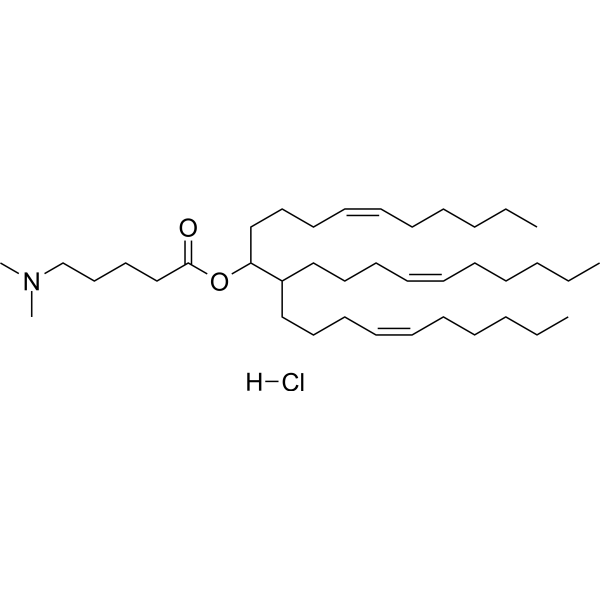
- HY-113217
-
|
|
Liposome
Endogenous Metabolite
|
Others
|
|
Cholesteryl oleate is an esterified form of Cholesterol. Cholesteryl oleate can be used in the generation of solid lipid nanoparticle (SLN, a nanoparticle-based method for gene therapy) .
|
-
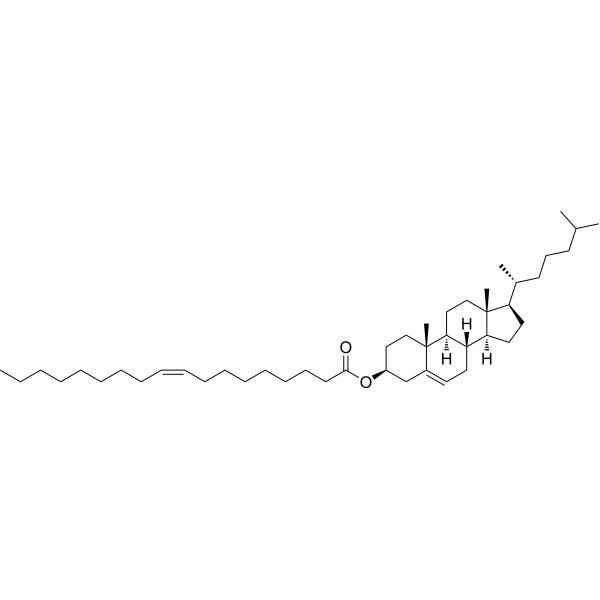
- HY-W590548
-
|
|
Liposome
|
Others
|
|
ATX-001 is an ionizable cationic lipid. ATX-001 can be used in the formation of lipid nanoparticles (LNPs) for the delivery mRNA .
|
-
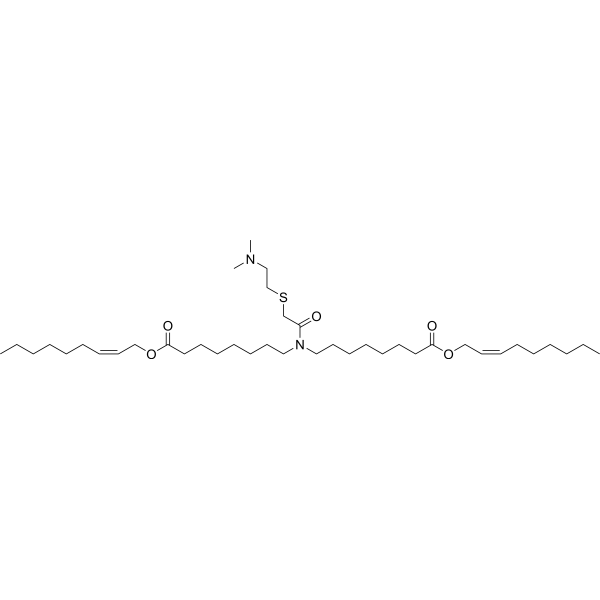
- HY-153136
-
|
|
Liposome
|
Others
|
|
LNP Lipid-1 (Method B) is a lipid compound. LNP Lipid-1 is involved in the synthesis of lipid nanoparticles compositions. LNP Lipid-1 has potential applications in the transport of biologically active substances such as small molecule agents, proteins, and nucleic acids .
|
-
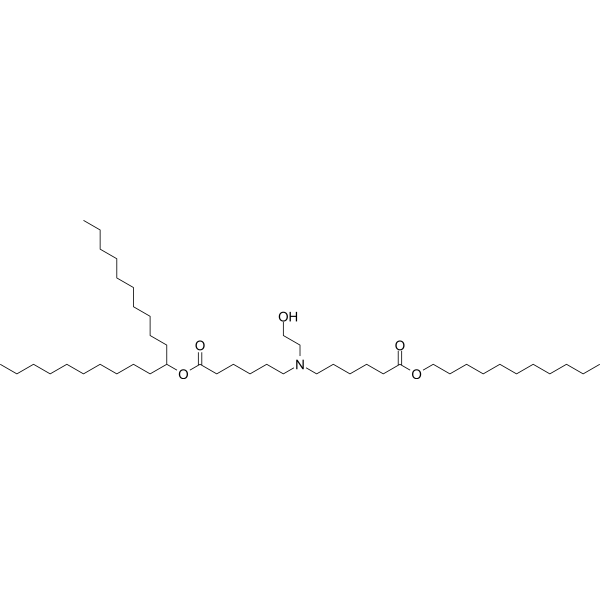
- HY-157524
-
|
|
Others
|
Others
|
|
1,2-O-Dioctadecyl-sn-glycerol (Compound 7b) is a lipid molecule that can be used to synthesize thermostable lipid nanoparticle .
|
-

- HY-W440811
-
|
|
Liposome
|
Others
|
|
6-Bromohexyl 2-hexyldecanoate is a lipid. 6-Bromohexyl 2-hexyldecanoate can be used to build lipid nanoparticles and nanomaterials .
|
-

- HY-148842
-
|
|
Liposome
|
Others
|
|
C14-4 is an ionizable lipid for lipid nanoparticles (LNPs) formulation. C14-4 was identified for its potent transfection and low cytotoxicity.
|
-

- HY-W590531
-
-
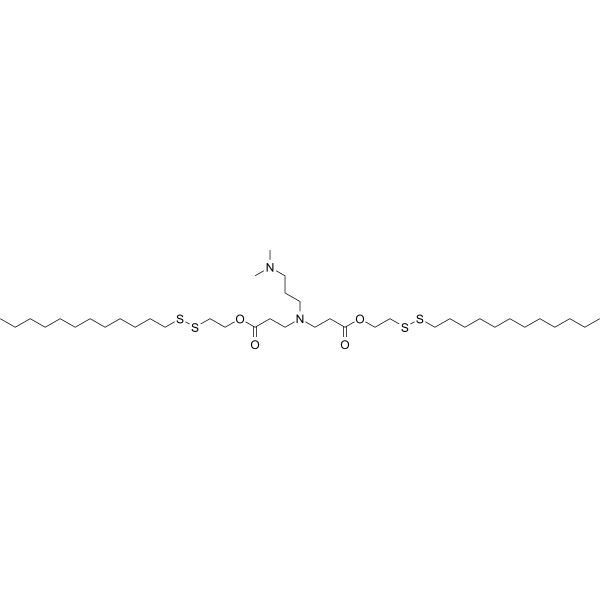
- HY-W590680
-
|
|
Liposome
|
Others
|
|
ssPalmM is a SS-cleavable proton-activated lipid-like materials. ssPalmM can be used to form lipid nanoparticles (LNPs) for nuclear targeting of plasmid DNA .
|
-

- HY-112756
-
|
|
Liposome
|
Others
|
|
PEG2000-DGG is a synthetic lipid. PEG2000-DGG can be used in lipid-based nanoparticle (LNP) delivery systems .
|
-
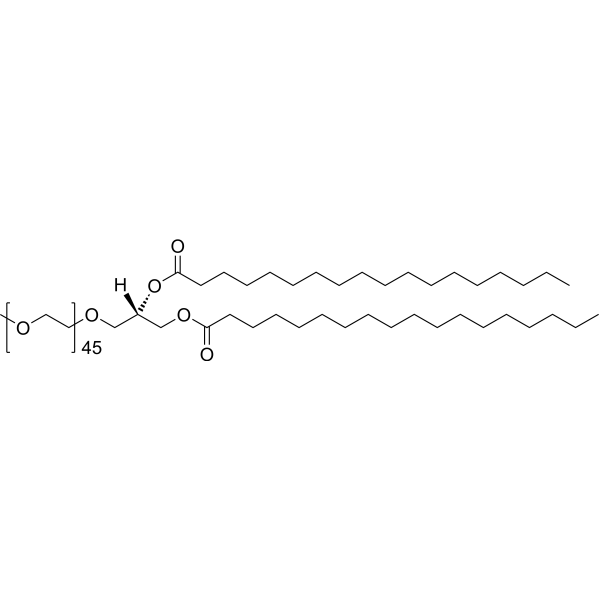
- HY-W590678
-
|
|
Liposome
|
Others
|
|
SSPalmO-Phe is an ionizable cationic self-degradable disulfide-cleavable (SS-cleavable) proton-activated lipid-like material. It has been used in combination with other lipids in the formation of lipid nanoparticles (LNPs) for drug delivery.
|
-
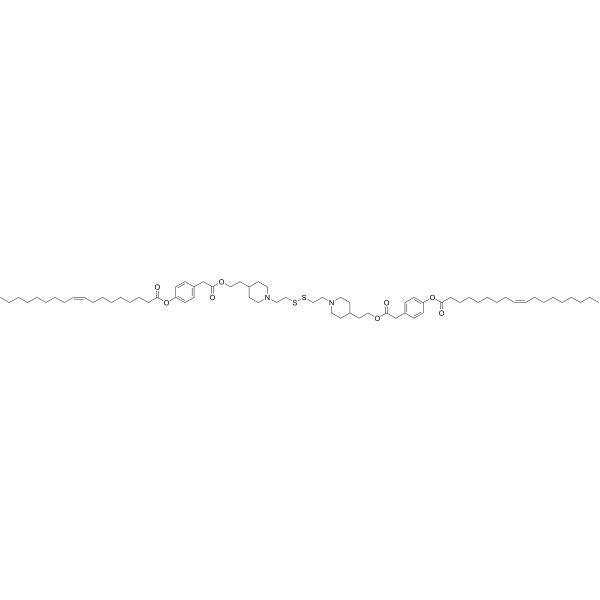
- HY-142979
-
|
|
Liposome
|
Others
|
|
DSPE-PEG 2000 is a PEG-lipid that can be used to form micelles as nanoparticles for drug delivery .
|
-
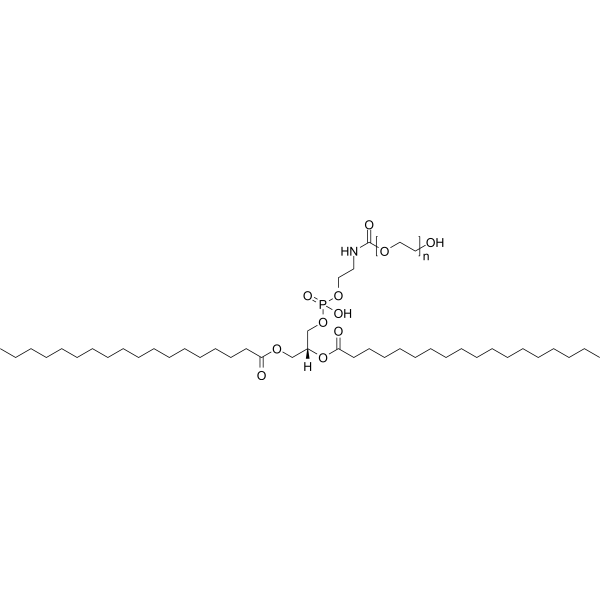
- HY-153138
-
-
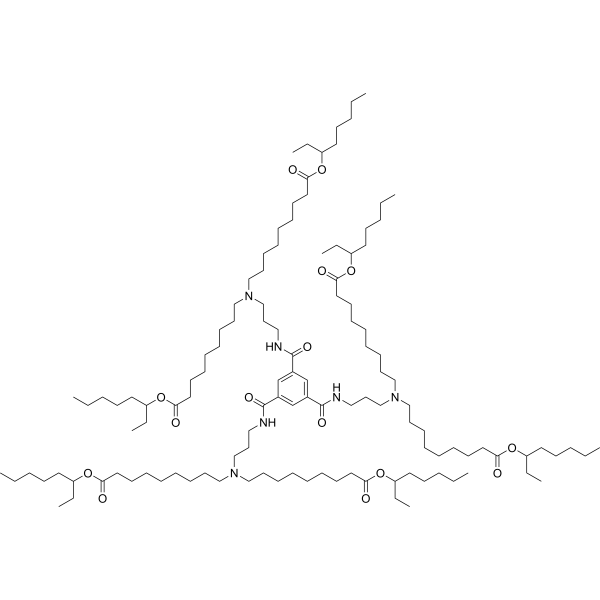
- HY-W440813
-
|
|
Liposome
|
Others
|
|
Heptadecan-9-yl 8-bromooctanoate can be useful for the building or modification of lipid nanoparticles.
|
-
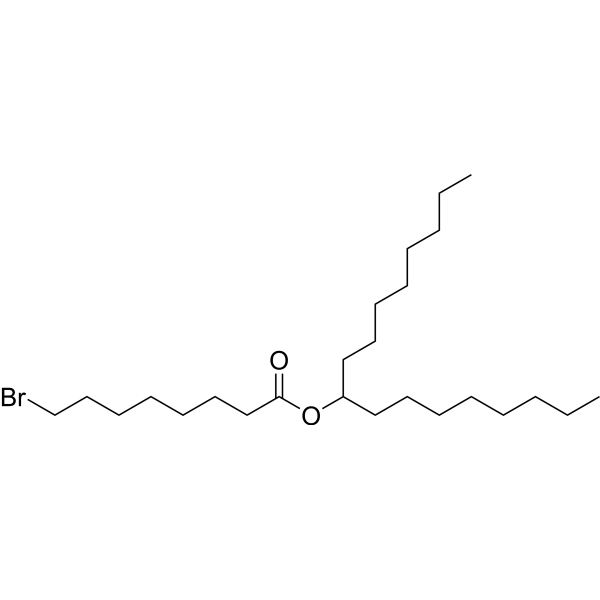
- HY-145794
-
|
|
Liposome
|
Others
|
|
ZA3-Ep10 is a zwitterionic lipid used in lipid nanoparticles formulation for in vivo RNA delivery and non-viral CRISPR/Cas gene editing.
|
-

- HY-148830
-
|
|
Liposome
|
Others
|
|
Piperazine-bis(ethyl octadeca-9,12-dienoate) is a cationic lipid extracted from patent WO2023036148A1, and can be used for the generation of Lipid nanoparticles (LNPs).
|
-
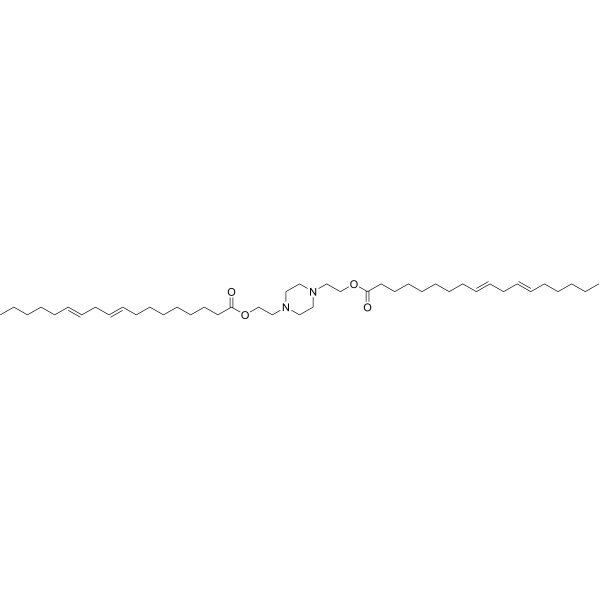
- HY-134781
-
CKK-E12
1 Publications Verification
|
Liposome
|
Others
|
|
CKK-E12 is a ionizable lipid in combination with other lipids make up the lipid nanoparticles which are used to deliver RNA-based research. CKK-E12 is highly selective toward liver parenchymal cell in vivo,
|
-
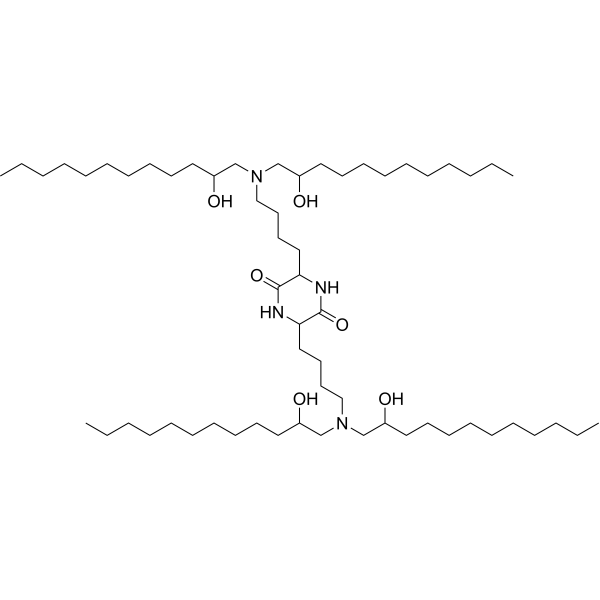
- HY-160580
-
|
|
Liposome
|
Others
|
|
G1-OC2-K3-E10 is an ionizable lipid, and can be used for delivery of mRNA in lipid nanoparticles (LNPs) .
|
-

- HY-113217S1
-
|
|
Isotope-Labeled Compounds
Endogenous Metabolite
|
Others
|
|
Cholesteryl oleate-d7-1 is deuterium labeled Cholesteryl oleate. Cholesteryl oleate is an esterified form of Cholesterol. Cholesteryl oleate can be used in the generation of solid lipid nanoparticle (SLN, a nanoparticle-based method for gene therapy)
|
-

- HY-113217S
-
|
|
Endogenous Metabolite
|
Others
|
|
Cholesteryl oleate-d7 is deuterium labeled Cholesteryl oleate. Cholesteryl oleate is an esterified form of Cholesterol. Cholesteryl oleate can be used in the generation of solid lipid nanoparticle (SLN, a nanoparticle-based method for gene therapy)[1
|
-
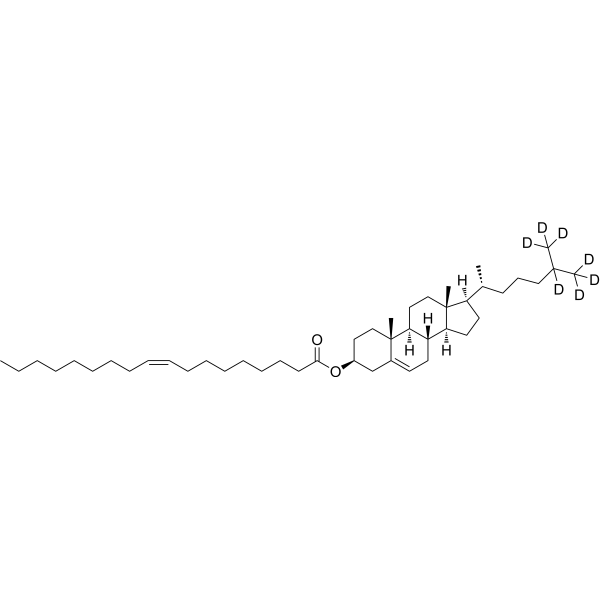
- HY-112773
-
|
|
Liposome
|
Others
|
|
1,1′,1′′,1′′′-[1,4-Piperazinediylbis(2,1-ethanediylnitrilo)]tetrakis[2-dodecanol] is a lipid/lipidoid used in preparation of lipid-based or lipidoid nanoparticles .
|
-
![1,1′,1′′,1′′′-[1,4-Piperazinediylbis(2,1-ethanediylnitrilo)]tetrakis[2-dodecanol]](//file.medchemexpress.com/product_pic/hy-112773.gif)
- HY-156936
-
|
|
Liposome
|
Others
|
|
RCB-02-4-8 is an ionizable cationic lipid that is used to form lipid nanoparticles (LNPs) to deliver mRNA. RCB-02-4-8 can improve the efficiency of lung transfection in mice .
|
-
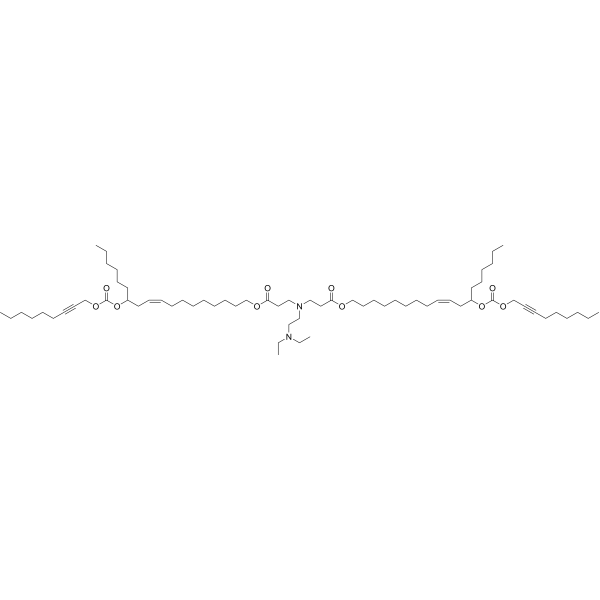
- HY-153737
-
|
|
Liposome
|
Others
|
|
113-N16B is an ionizable cationic lipid used for the generation of lipid nanoparticles (LNPs). 113-N16B delivers mRNA preferentially to pulmonary endothelial cells.
|
-
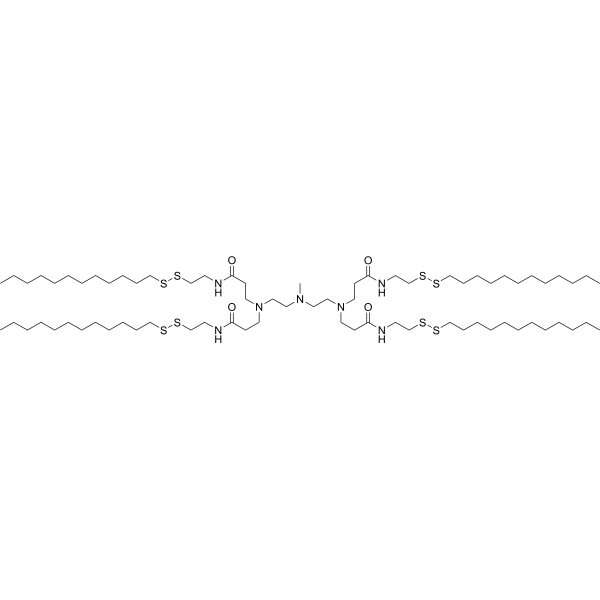
- HY-W598178
-
|
|
Liposome
|
Others
|
|
93-O17O is a chalcogen-containing ionizable cationic lipidoid that used in the formation of lipid nanoparticles (LNPs) .
|
-

- HY-153380
-
|
|
Liposome
|
Others
|
|
ALC-0315 analogue-2 is an analogue of ALC-0315. ALC-0315 is an ionisable aminolipid that is responsible for mRNA compaction and aids mRNA cellular delivery and its cytoplasmic release through suspected endosomal destabilization. ALC-0315 can be used to form lipid nanoparticle (LNP) delivery vehicles. Lipid-Nanoparticles have been used in the research of mRNA COVID-19 vaccine.
|
-
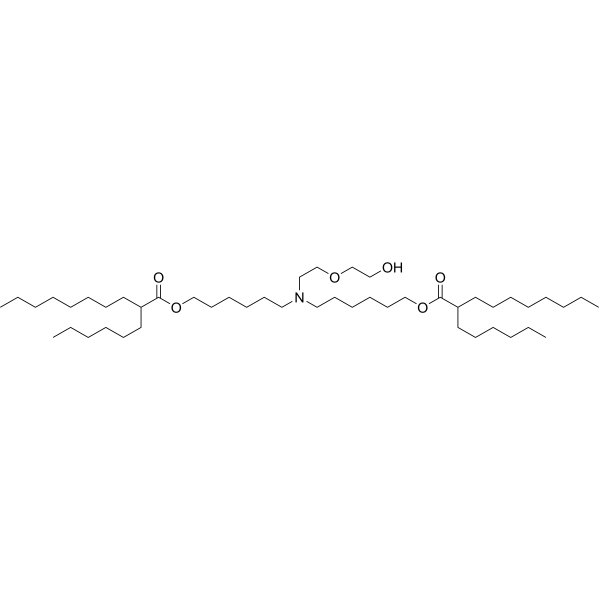
- HY-148855
-
|
|
Liposome
|
Others
|
|
OF-C4-Deg-Lin is an ionizable lipid with varied linker lengths. OF-C4-Deg-Lin can be used in the generation of lipid nanoparticles (LNPs) for the delivery of siRNA and mRNA .
|
-
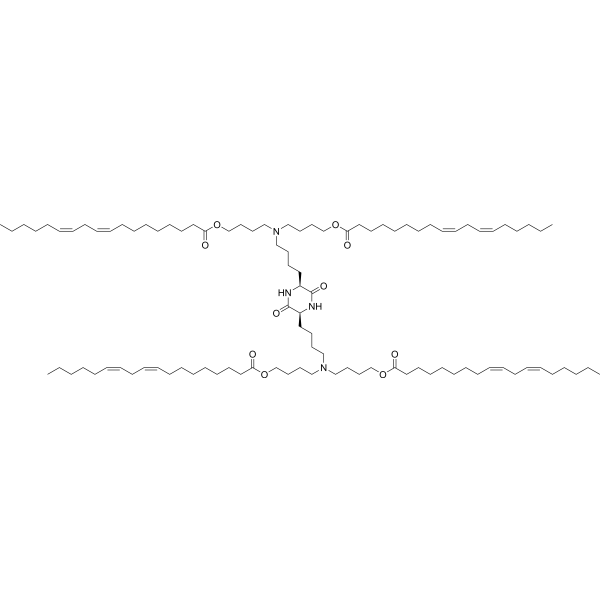
- HY-139305
-
|
|
Liposome
|
Cancer
|
|
CL4H6 is a pH-sensitive cationic lipid. CL4H6 is the main component of lipid nanoparticles (LNPs), which can be used to target and deliver siRNA, and induces a potent gene-silencing response .
|
-
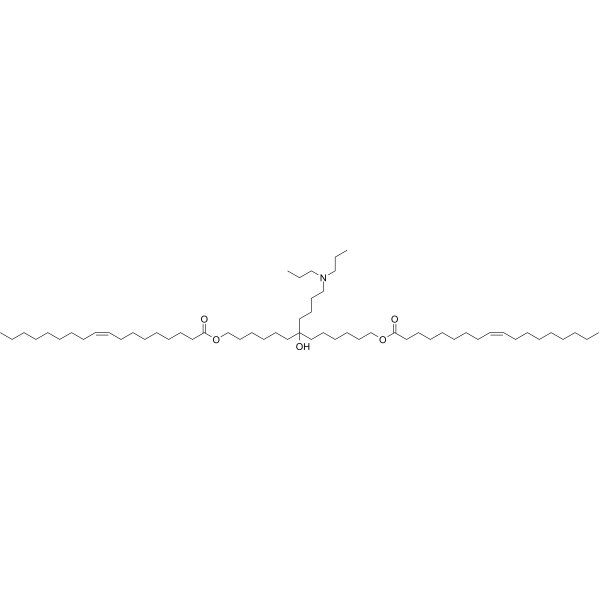
- HY-153235
-
|
|
SARS-CoV
Liposome
|
Infection
|
|
COVID-19 Spike Protein mRNA-LNP is a lipid nanoparticle (LNP) containing COVID-19 Spike Protein, suitable for detection of RNA delivery, translation efficiency, cell viability, etc. COVID-19 Spike Protein is the novel coronavirus pneumonia spike protein located on the membrane surface. COVID-19 Spike Protein undertakes the functions of virus binding to host cell membrane receptors and membrane fusion, thereby mediating the entry of COVID-19 virus into cells. COVID-19 Spike Protein is an important site of action for host neutralizing antibodies and a key target for vaccine design .
|
-

- HY-W591381
-
|
|
Others
|
Others
|
|
DSG-PEG is a type of polyethylene glycol grease. DSG-PEG can be used to prepare liposomes .
|
-
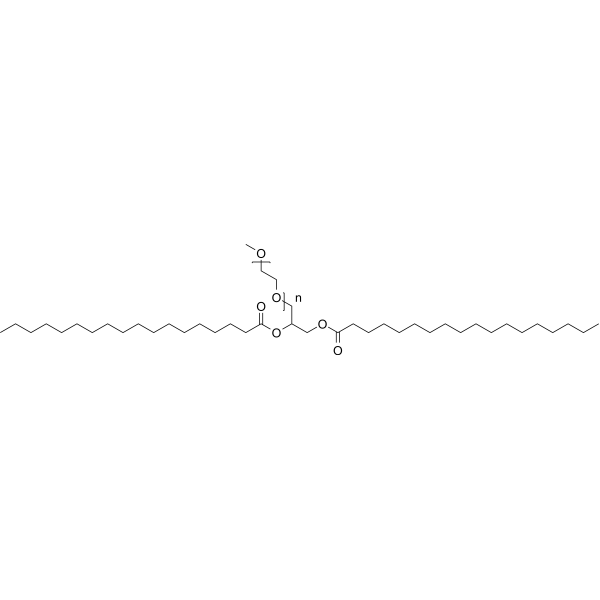
- HY-112764
-
|
|
Liposome
|
Metabolic Disease
|
|
DMG-PEG 2000 is used for the preparation of liposome for siRNA delivery with improved transfection efficiency in vitro. DMG-PEG 2000 is also used for the lipid nanoparticle for an oral plasmid DNA delivery approach in vivo through a facile surface modification to improve the mucus permeability and delivery efficiency of the nanoparticles .
|
-

- HY-W441012
-
|
|
Liposome
|
Others
|
|
DSPE-PEG-NHS, MW 600 is a pegylated phospholipid derivatives which can be used to prepare liposome or lipid nanoparticles for targeted drug delivery system, such as DNA or mRNA vaccine.
|
-
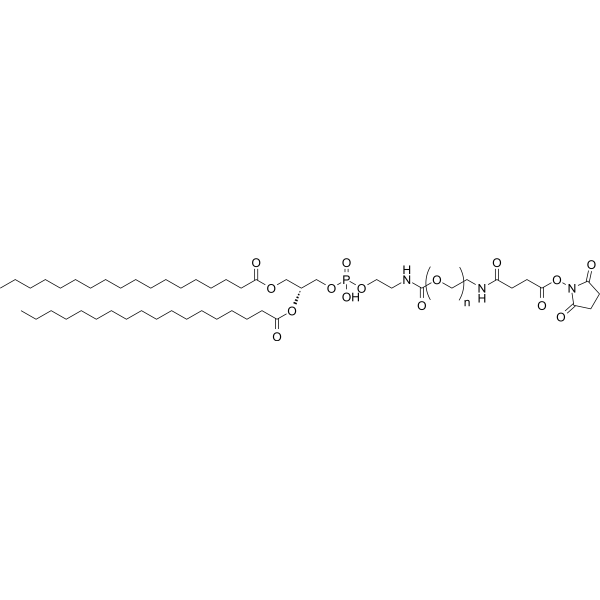
- HY-W441016
-
|
|
Biochemical Assay Reagents
|
Others
|
|
DSPE-PEG-NHS, MW 5000 is a pegylated phospholipid derivatives which can be used to prepare liposome or lipid nanoparticles for targeted drug delivery system, such as DNA or mRNA vaccine .
|
-
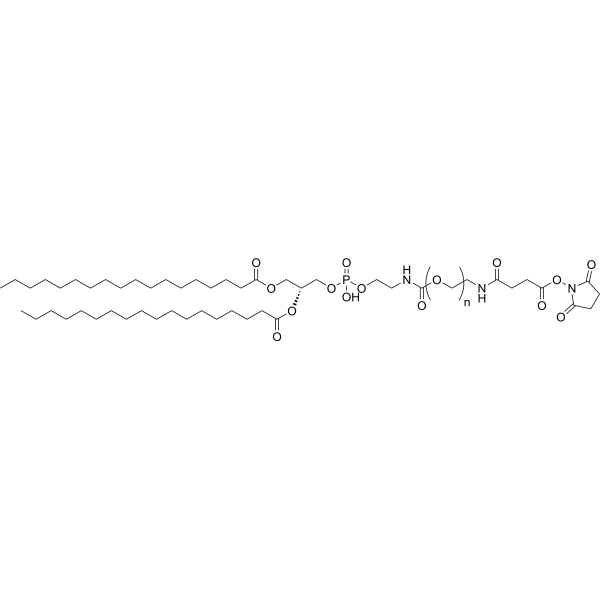
- HY-W441015A
-
|
|
Liposome
|
Others
|
|
DSPE-m-PEG-NHS (MW 3400) is a pegylated phospholipid derivatives which can be used to prepare liposome or lipid nanoparticles for targeted drug delivery system, such as DNA or mRNA vaccine.
|
-
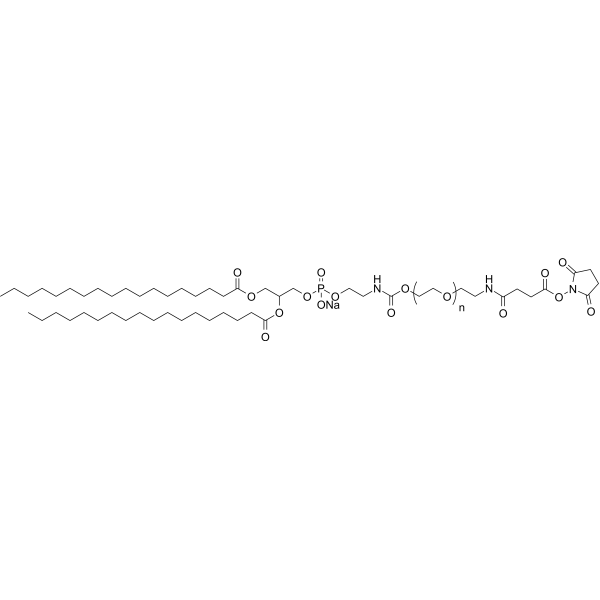
- HY-153371
-
|
|
Liposome
|
Others
|
|
50-C2-C9-4tail has been used in the generation of lipid nanoparticles (LNPs) for the delivery of siRNA and mRNA in vitro and in vivo.
|
-
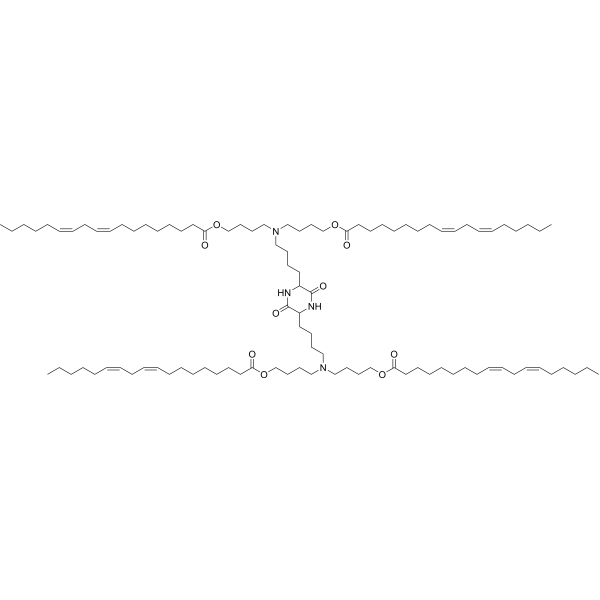
- HY-W440683
-
|
|
Liposome
|
Others
|
|
C13-112-tetra-tail is a cationic lipid-like compound containing a polar amino alcohol head group, four hydrophobic carbon-13 tails, and a PEG2 linker. C13-112-tetra-tail can be formulated into a lipid nanoparticle (LNP).
|
-

- HY-W440681
-
|
|
Liposome
|
Others
|
|
C13-112-tri-tail is a cationic lipid-like compound containing a polar amino alcohol head group, three hydrophobic carbon-13 tails, and a PEG2 linker. C13-112-tri-tail can be formulated into a lipid nanoparticle (LNP).
|
-

- HY-W440684
-
|
|
Liposome
|
Others
|
|
C13-113-tetra tail is a cationic lipid-like compound containing a polar amino alcohol head group, four hydrophobic carbon-13 tails, and a tertiary amine linker. C13-113-tetra tail can be formulated into a lipid nanoparticle (LNP).
|
-
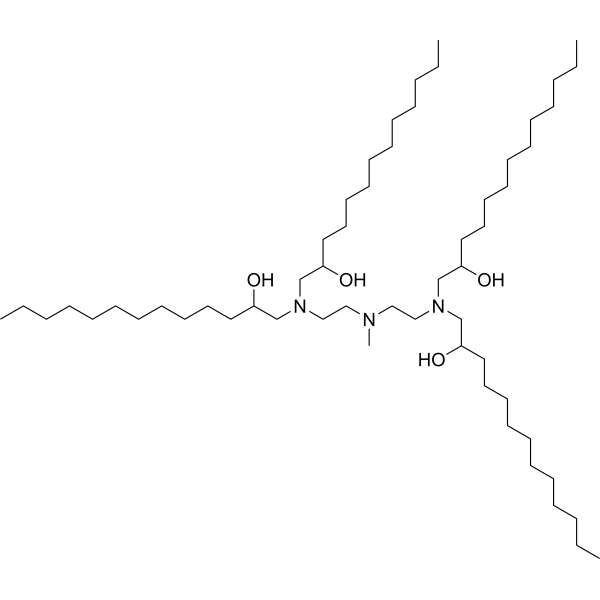
- HY-W440682
-
|
|
Liposome
|
Others
|
|
C13-113-tri tail is a cationic lipid-like compound containing a polar amino alcohol head group, three hydrophobic carbon-13 tails, and a tertiary amine linker. C13-113-tri tail can be formulated into a lipid nanoparticle (LNP).
|
-
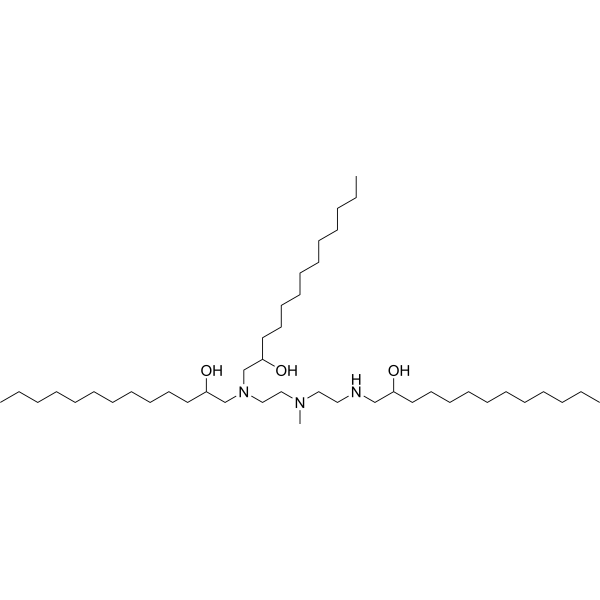
- HY-141892A
-
|
|
Liposome
|
Others
|
|
DSPE-PEG Carboxylic acid (sodium), MW 2000 is a PEG-lipid that can be used to form micelles as nanoparticles for drug delivery. DSPE-PEG Carboxylic acid (sodium), MW 2000 increases the blood circulation time of liposomes .
|
-

- HY-160269
-
|
|
Fluorescent Dye
|
Others
|
|
DSPE-PEG-Fluor 488,MW 2000 is a PEG-dye-lipid conjugate consisting of a DSPE phospholipid and a Fluor 488 dye. DSPE is a phospholipid that spontaneously forms micelles in a water medium, and Fluor 488 is a cyanine dye that is widely used in fluorescence microscopy. Fluor 488 has excitation and emission maxima at 499 nm and 520 nm. Polyethylene glycol lipids are commonly used for the stabilization of lipid nanoparticles .
|
-
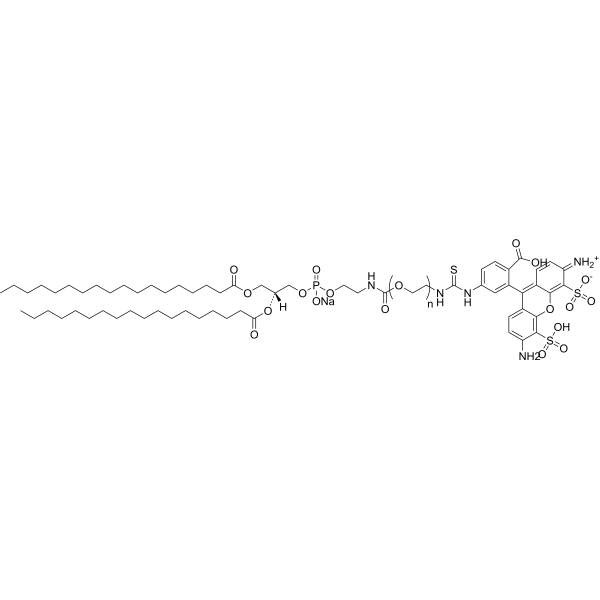
- HY-112760
-
|
DSPE-mPEG2000 sodium; 1,2-Distearoyl-sn-glycero-3-phosphoethanolamine-N-[methoxy(polyethylene glycol)-2000] sodium
|
Liposome
|
Cancer
|
|
18:0 mPEG2000 PE sodium can be used for the preparation of stabilized nucleic acid-lipid particllipid particles (SNALPs). SNALPs represent some of the earliest and best functional siRNA-ABC nanoparticles described .
|
-
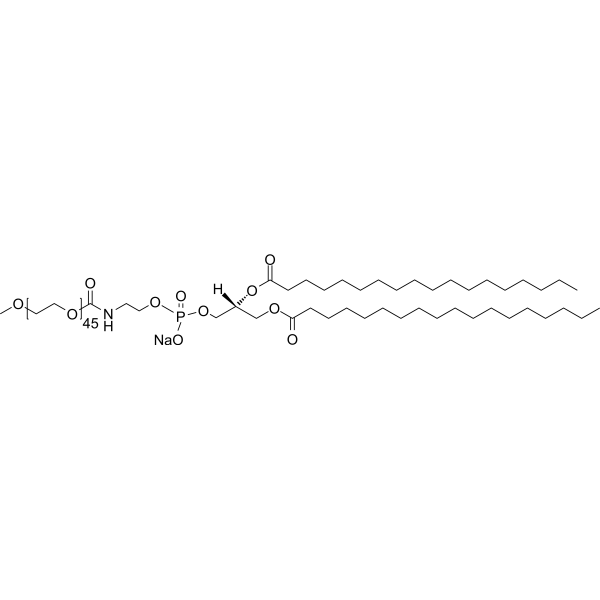
- HY-113736
-
|
|
Amino Acid Derivatives
|
Others
|
|
Glycyllysine is a polypeptide that can be used in the synthesis of antibodies and amino acid type gemini surfactants. Glycyllysine has potential applications in modifying plasmid/gemini/lipid (P/G/L) nanoparticles transport carriers .
|
-
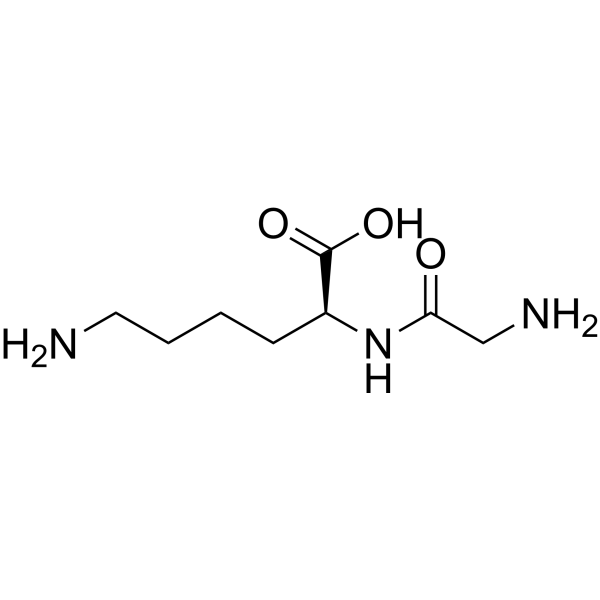
- HY-160554
-
|
|
Others
|
Infection
Inflammation/Immunology
|
|
C12-113 is a lipidoid delivery agent that can be used to transfect siRNA into cells. C12-113 can also be combined with other lipids to form lipid nanoparticles (LNPs) for the delivery of mRNA encoding the spike glycoprotein of severe acute respiratory syndrome coronavirus 2 (SARS-CoV-2) in mice .
|
-
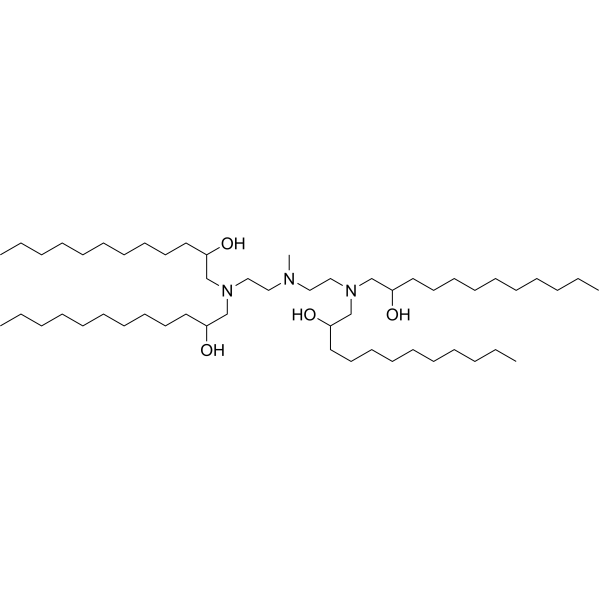
- HY-W590681
-
|
|
Liposome
|
Others
|
|
113-O12B is a disulfide bond-containing ionizable cationic lipidoid. 113-O12B can be used in that generation of lipid nanoparticles (LNPs) for the delivery of mRNA .
|
-
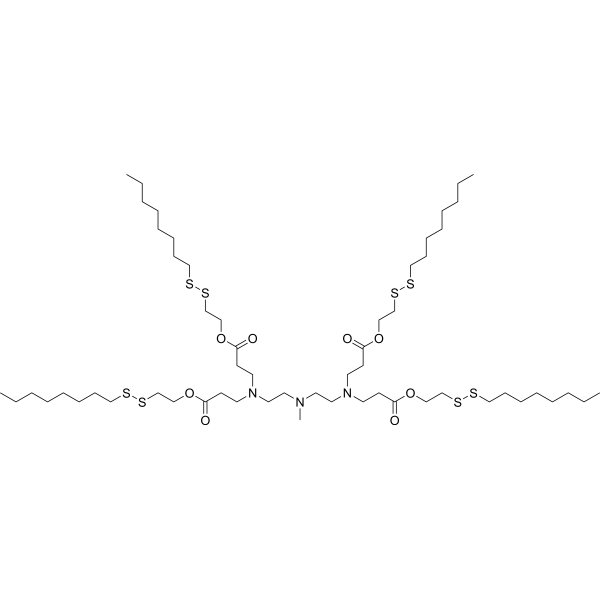
- HY-W590679
-
|
|
Liposome
|
Others
|
|
113-O16B is a disulfide bond-containing ionizable cationic lipidoid. 113-O16B has been used in the generation of lipid nanoparticles (LNPs) for the delivery of mRNA .
|
-
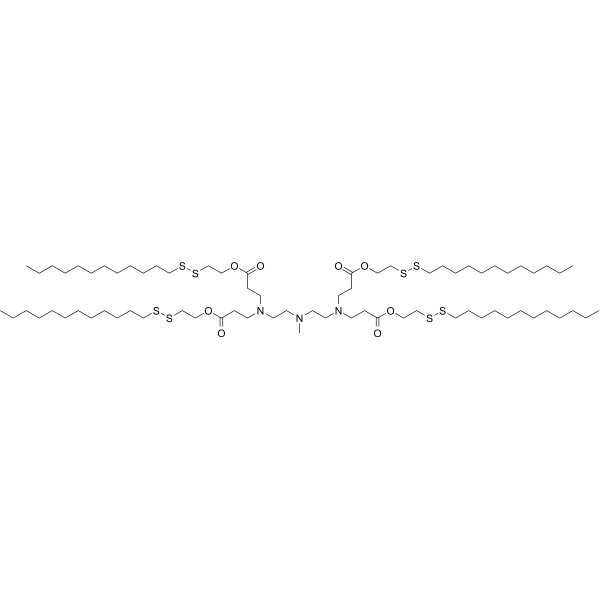
- HY-W590683
-
|
|
Liposome
CRISPR/Cas9
|
Others
|
|
9A1P9 is a multi-tail ionizable cationic phospholipid. 9A1P9 induces membrane destabilization. 9A1P9 can be used for CRISPR-Cas9 gene editing in mice .
|
-
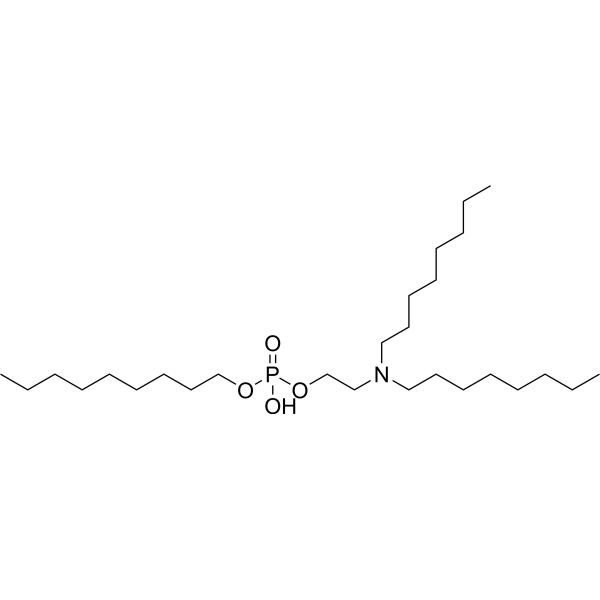
- HY-W440916
-
|
|
Liposome
|
|
|
DSPE-PEG-FITC, MW 3400 is a fluorescein attached PEG lipid. It can be used to prepare liposomes as drug carrier in targeted drug delivery. The polymer is modified with fluorescein (green) dye which can be used for staining cells, tissues, biomarkers, or nanoparticles.
|
-
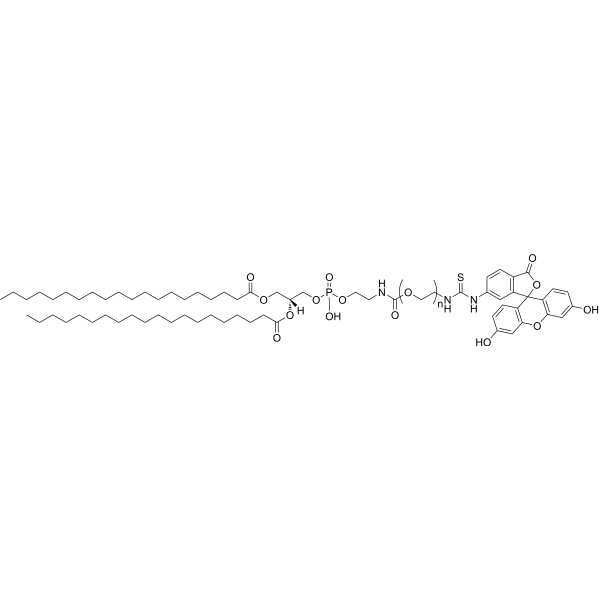
- HY-W440915
-
|
|
Liposome
|
|
|
DSPE-PEG-FITC, MW 2000 is a fluorescein attached PEG lipid. It can be used to prepare liposomes as drug carrier in targeted drug delivery. The polymer is modified with fluorescein (green) dye which can be used for staining cells, tissues, biomarkers, or nanoparticles.
|
-
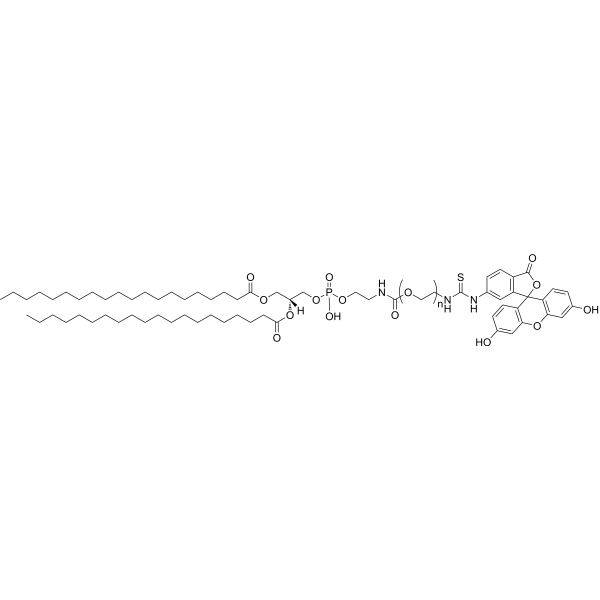
- HY-W440917
-
|
|
Liposome
|
|
|
DSPE-PEG-FITC, MW 5000 is a fluorescein attached PEG lipid. It can be used to prepare liposomes as drug carrier in targeted drug delivery. The polymer is modified with fluorescein (green) dye which can be used for staining cells, tissues, biomarkers, or nanoparticles.
|
-
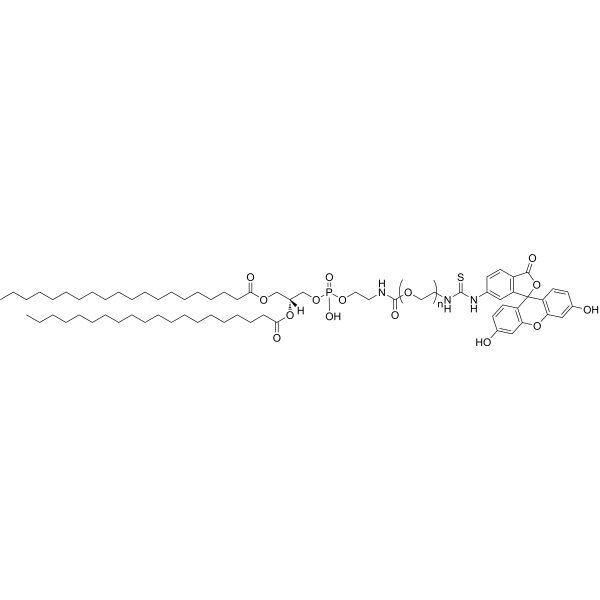
- HY-112758
-
|
|
Liposome
|
Others
|
|
DLin-KC2-DMA is an ionisable cationic lipid (pKa≈6) that is virtually non-toxic to antigen presenting cells (APCs). DLin-KC2-DMA produces significant siRNA-mediated gene silencing of GAPDH, when binds to lipid nanoparticles (LNP). DLin-KC2-DMA can be used in siRNA delivery studies .
|
-

- HY-W440921
-
|
|
Liposome
|
|
|
DSPE-PEG-Rhodamine, MW 5000 is a phospholipid polyPEG with red fluorescent. The polymer can form lipid bilayer and be used to prepare nanoparticles or liposomes for targeted drug delivery. Rhodamine has maximum absorption at 570 nm and emission around 595 nm and can be easily traced using an imaging technique.
|
-
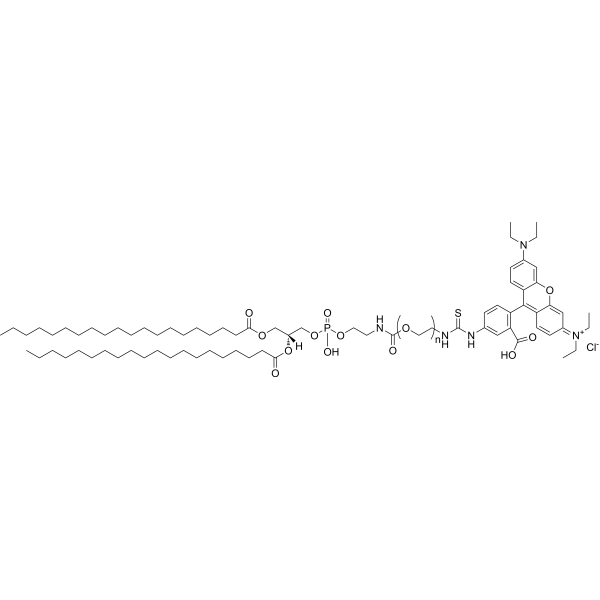
- HY-W440920
-
|
|
Liposome
|
|
|
DSPE-PEG-Rhodamine, MW 3400 is a phospholipid polyPEG with red fluorescent. The polymer can form lipid bilayer and be used to prepare nanoparticles or liposomes for targeted drug delivery. Rhodamine has maximum absorption at 570 nm and emission around 595 nm and can be easily traced using an imaging technique.
|
-

- HY-148701
-
|
|
Liposome
|
Cancer
|
|
mono-Pal-MTO is a palm oil-based lipid produced by combining the anticancer agent mitoxantrone (MTO) with palmitoleic acid. When nanoparticles of mono-Pal-MTO and di-Pal-MTO are combined in a molar ratio of 1:1, they show effective siRNA cell delivery and enhance anticancer activity .
|
-
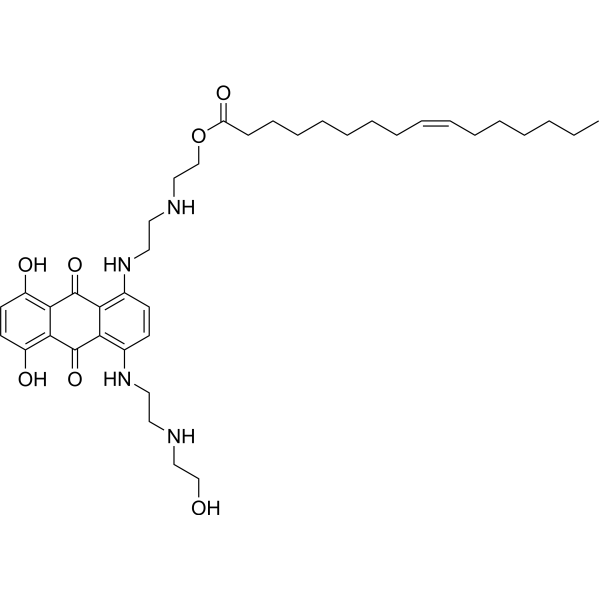
- HY-148702
-
|
|
Liposome
|
Cancer
|
|
di-Pal-MTO is a palm oil-based lipid produced by combining the anticancer agent mitoxantrone (MTO) with palmitoleic acid. When nanoparticles of mono-Pal-MTO and di-Pal-MTO are combined in a molar ratio of 1:1, they show effective siRNA cell delivery and enhance anticancer activity .
|
-
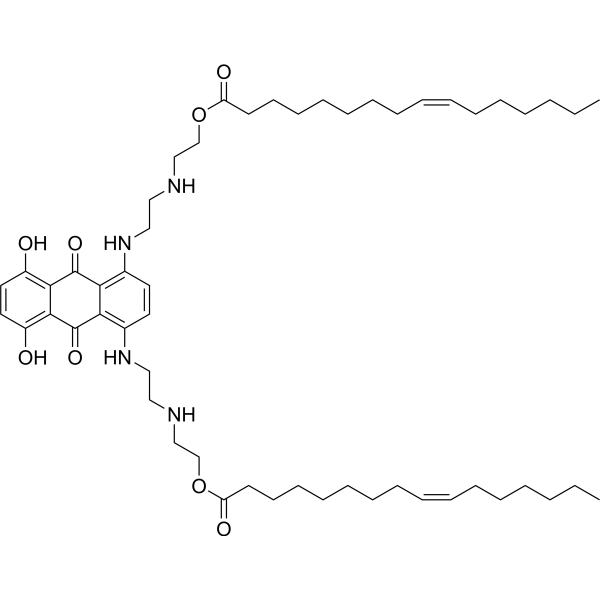
- HY-W440909
-
|
|
Liposome
|
|
|
DSPE-PEG-Cy3, MW 3400 is a phospholipid PEG polymer with Cy3 dye used in labeling and fluorescence microscopy. The polymer can self-assemble in aqueous solution to form micelles/lipid bilayer and used to prepare liposomes or nanoparticles for nutrients delivery such as mRNA or DNA vaccine.
|
-
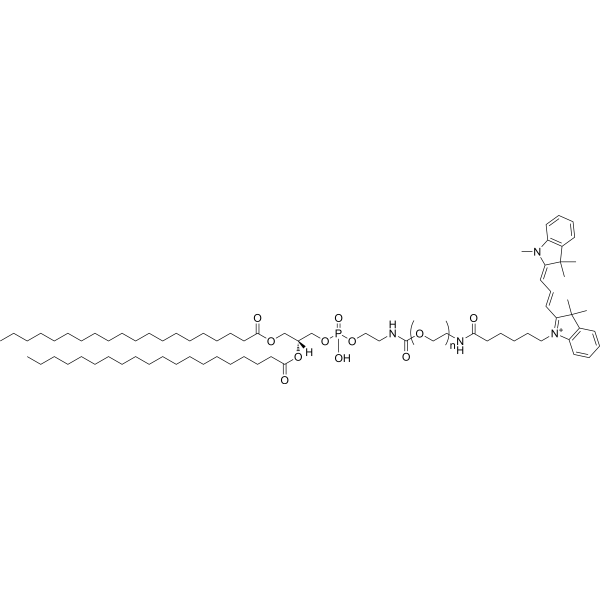
- HY-W440910
-
|
|
Liposome
|
|
|
DSPE-PEG-Cy3, MW 5000 is a phospholipid PEG polymer with Cy3 dye used in labeling and fluorescence microscopy. The polymer can self-assemble in aqueous solution to form micelles/lipid bilayer and used to prepare liposomes or nanoparticles for nutrients delivery such as mRNA or DNA vaccine.
|
-
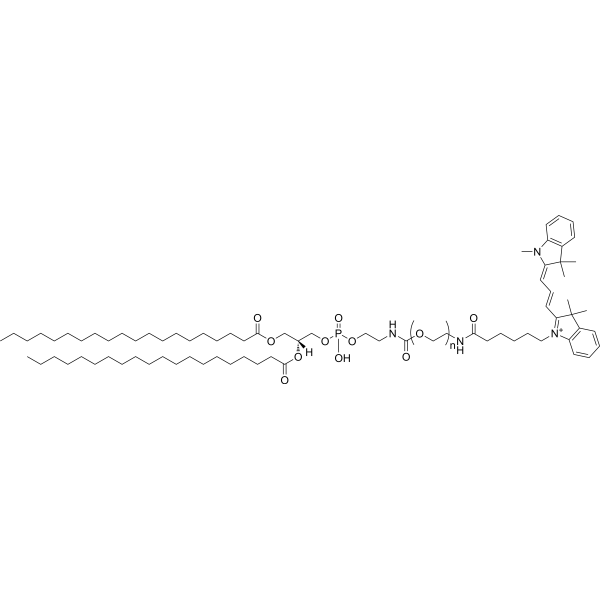
- HY-W440913
-
|
|
Liposome
|
|
|
DSPE-PEG-Cy5, MW 5000 is a PEG phospholipid with Cy5 dye used in protein/nucelic acid labeling and fluorescence microscopy. The polymer can self-assemble in aqueous solution to form micelles/lipid bilayer and used to prepare liposomes or nanoparticles for nutrients delivery such as mRNA or DNA vaccine.
|
-
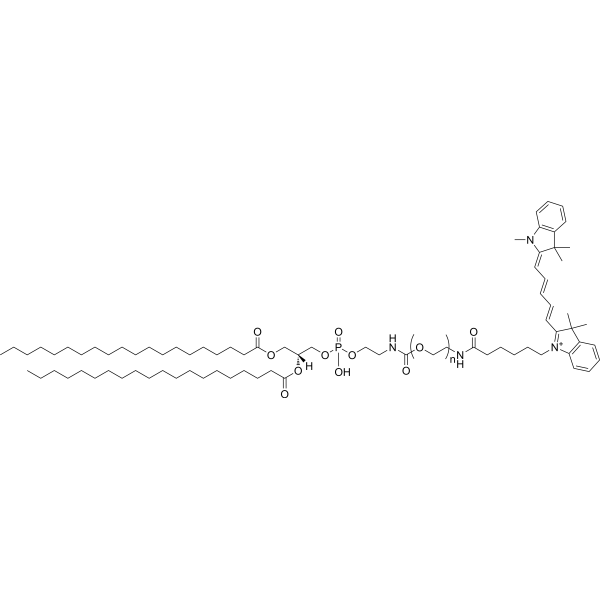
- HY-W440912
-
|
|
Liposome
|
|
|
DSPE-PEG-Cy5, MW 3400 is a PEG phospholipid with Cy5 dye used in protein/nucelic acid labeling and fluorescence microscopy. The polymer can self-assemble in aqueous solution to form micelles/lipid bilayer and used to prepare liposomes or nanoparticles for nutrients delivery such as mRNA or DNA vaccine.
|
-
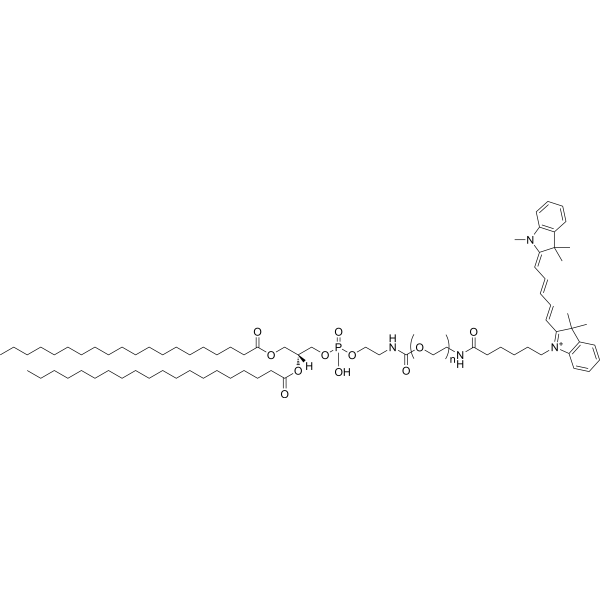
- HY-W040193S
-
|
1,2-Distearoyl-sn-glycero-3-PC-d70; DSPC-d70
|
Isotope-Labeled Compounds
Liposome
|
Others
|
|
1,2-Distearoyl-sn-glycero-3-phosphorylcholine-d70 is the deuterium labeled 1,2-Distearoyl-sn-glycero-3-phosphorylcholine. 1,2-Distearoyl-sn-glycero-3-phosphorylcholine (1,2-Distearoyl-sn-glycero-3-PC; DSPC) is a cylindrical-shaped lipid. 1,2-Distearoyl-sn-glycero-3-phosphorylcholine is used to synthesize liposomes, and is the lipid component in the lipid nanoparticle (LNP) system[1][2].
|
-
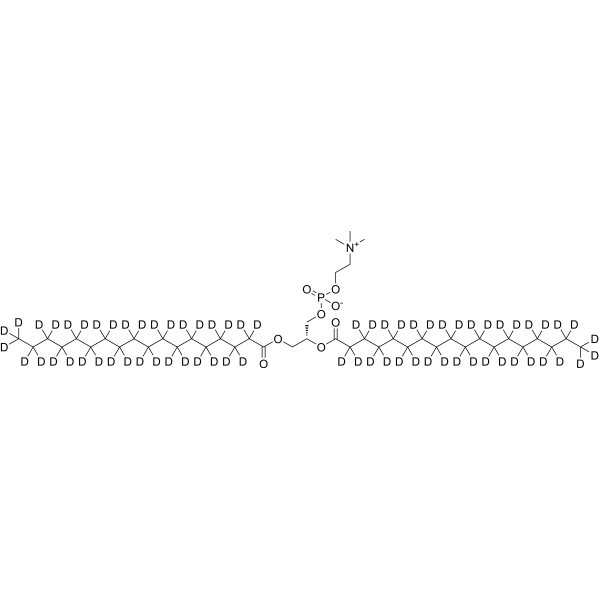
- HY-W040193S3
-
|
1,2-Distearoyl-sn-glycero-3-PC-d83; DSPC-d83
|
Isotope-Labeled Compounds
Liposome
|
Others
|
|
1,2-Distearoyl-sn-glycero-3-phosphorylcholine-d83 is deuterium labeled 1,2-Distearoyl-sn-glycero-3-phosphorylcholine. 1,2-Distearoyl-sn-glycero-3-phosphorylcholine (1,2-Distearoyl-sn-glycero-3-PC; DSPC) is a cylindrical-shaped lipid. 1,2-Distearoyl-sn-glycero-3-phosphorylcholine is used to synthesize liposomes, and is the lipid component in the lipid nanoparticle (LNP) system[1][2].
|
-

- HY-152229
-
|
|
Liposome
|
Cancer
|
|
G0-C14 is a cationic lipid-like compound alkyl-modified polyamidoamine (PAMAM) dendrimer. G0-C14 involves in the preparation of a series of macrophage-targeted nanoparticles (NPs). NPs can be used for agent and vaccine delivery .
|
-
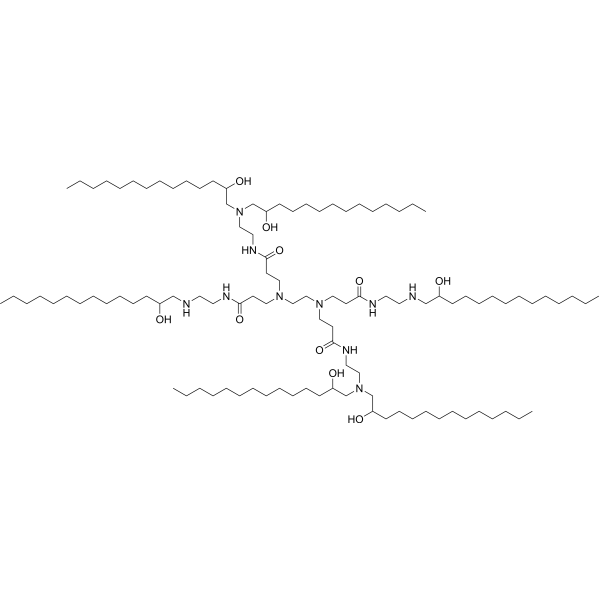
- HY-112752
-
|
|
Liposome
|
Others
|
|
Gal-C4-Chol is a glycosylated cholesterol derivative. Gal-C4-Chol can be used as a ligand for asialoglycoprotein receptors (ASGPR) to prepare Galactosylated (Gal) liposomes. Gal-C4-Chol can be used to prepare simple lipid-based nanoparticles .
|
-
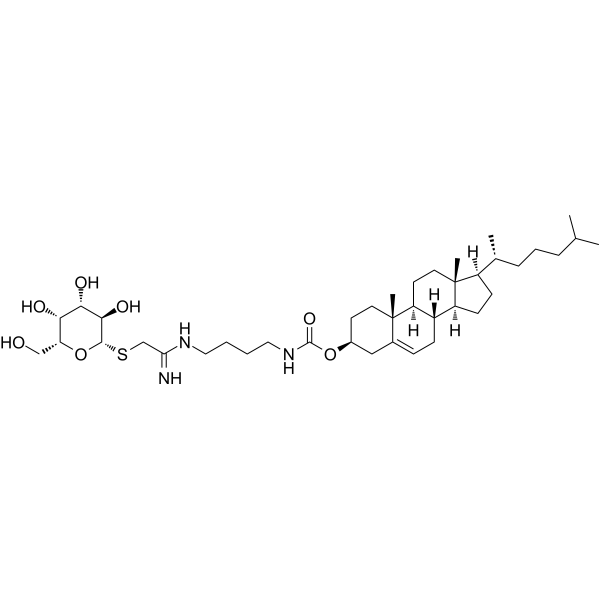
- HY-131119
-
|
Dioctadecyldimethylammonium bromide; DODAB
|
Liposome
|
Others
|
|
Dimethyldioctadecylammonium bromide is a synthetic cationic lipid commonly used in gene delivery and vaccine development. Also known as DODAB or DDAB, it consists of a positively charged ammonium head group and two long hydrophobic tails. These properties make it useful for forming liposomes and other lipid-based nanoparticles that can efficiently deliver genetic material into cells. In addition to its applications in biotechnology, DDAB is also used in surfactants, emulsifiers and fabric softeners. However, due to its potential toxicity and irritation, extreme care should be taken when handling DDAB.
|
-
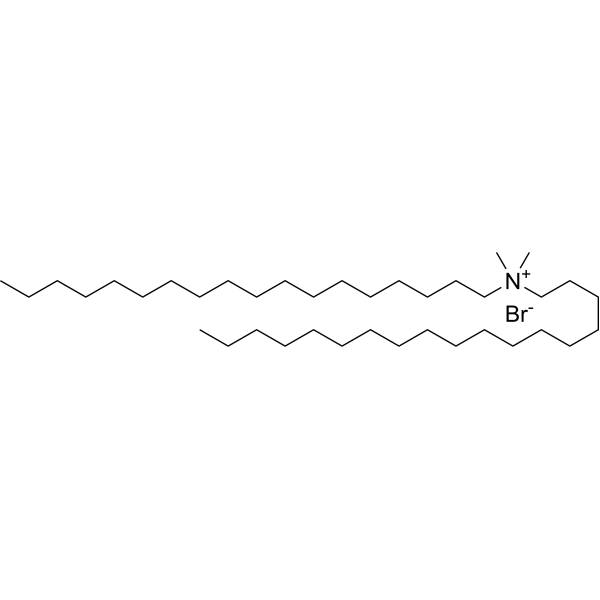
- HY-W440940
-
|
|
Liposome
|
|
|
Stearic acid-PEG-FITC, MW 5000 is a PEG lipid which forms micelles in water and can be used for drug delivery applications. The FITC fluorescent can be easily traced by miscroscopy. FITC is a green dye with peak absorption at 494 nm and maximum emission at 520 nm and can be used for staining biological samples or nanoparticles. FITC can be easily traced by fluorescence microscopy.
|
-

- HY-W440939
-
|
|
Liposome
|
|
|
Stearic acid-PEG-FITC, MW 3400 is a PEG lipid which forms micelles in water and can be used for drug delivery applications. The FITC fluorescent can be easily traced by miscroscopy. FITC is a green dye with peak absorption at 494 nm and maximum emission at 520 nm and can be used for staining biological samples or nanoparticles. FITC can be easily traced by fluorescence microscopy.
|
-
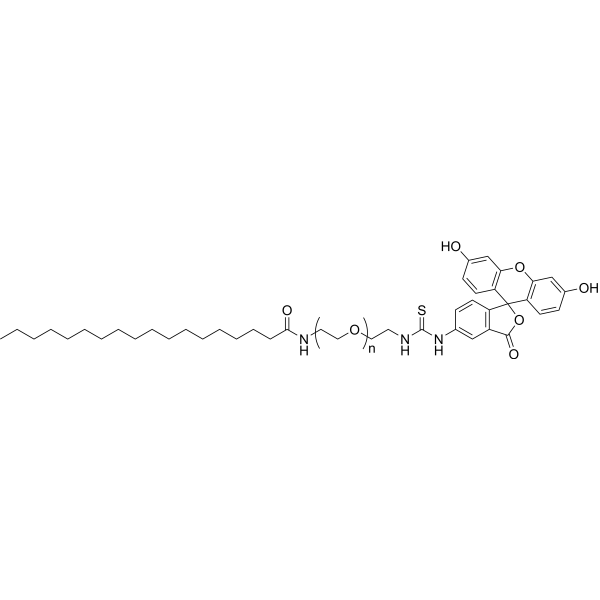
- HY-137500
-
|
|
Liposome
|
Neurological Disease
|
|
NT1-014B is a potent NT1-lipidoid encapsulated AmB (amphotericin B). NT1-014B dopes the NT-lipidoids into BBB-impermeable lipid nanoparticles (LNPs) gave the LNPs the ability to cross the BBB. NT1-014B enhances brain delivery through intravenous injection .
|
-
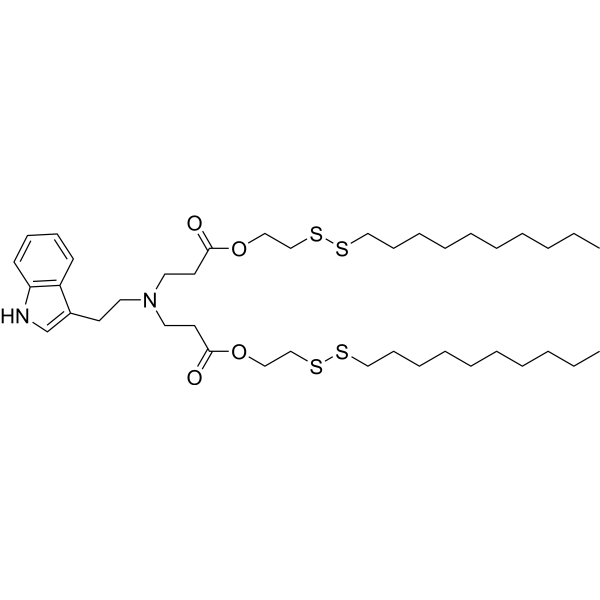
- HY-153231
-
|
|
Fluorescent Dye
Liposome
|
Others
|
|
eGFP mRNA-LNP is a lipid nanoparticle (LNP) containing eGFP mRNA, suitable for assays of RNA delivery, translation efficiency, cell viability, etc. eGFP circRNA carries Enhanced Green Fluorescent Protein (Enhanced Green Fluorescent Protein) eGFP, which will express green fluorescent protein after entering the cell. eGFP is commonly used as a reporter gene detectable by fluorescence microscopy or flow cytometry .
|
-
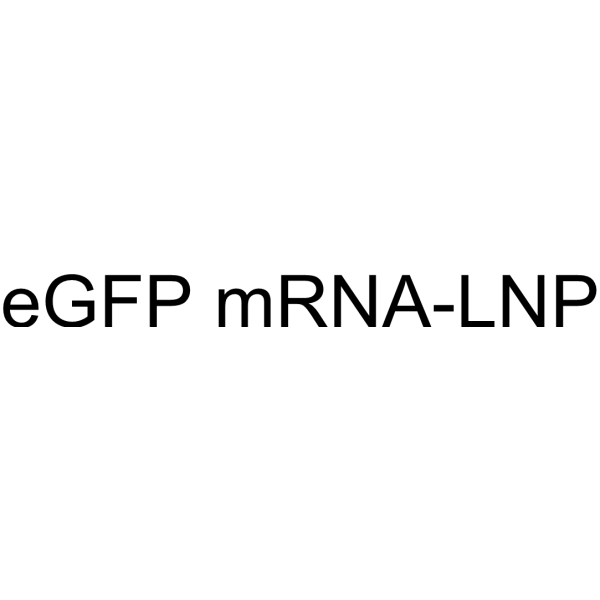
- HY-153232
-
|
|
Fluorescent Dye
Liposome
|
Others
|
|
eGFP circRNA-LNP is a lipid nanoparticle (LNP) containing eGFP circRNA, suitable for assays of RNA delivery, translation efficiency, cell viability, etc. eGFP circRNA carries Enhanced Green Fluorescent Protein (Enhanced Green Fluorescent Protein) eGFP, which will express green fluorescent protein after entering the cell. eGFP is commonly used as a reporter gene detectable by fluorescence microscopy or flow cytometry .
|
-
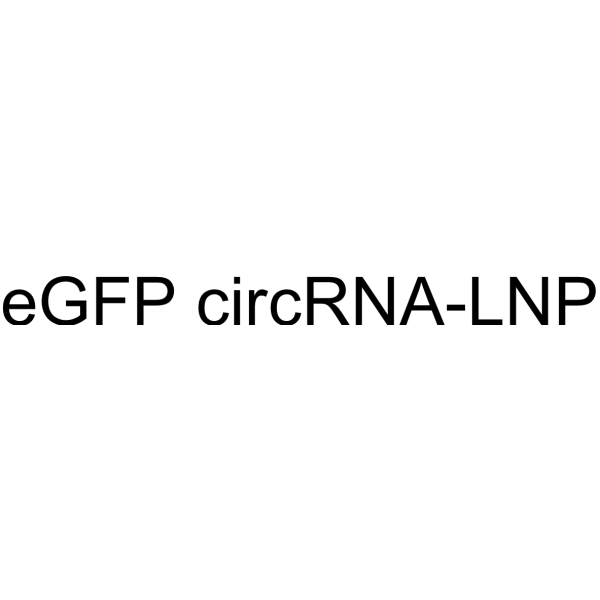
- HY-145405
-
C12-200
5 Publications Verification
|
Liposome
|
Others
|
|
C12-200 is an ionizable cationic lipid and auxiliary lipid. C12-200 is commonly used for mRNA delivery. Administration of human erythropoietin (EPO) mRNA or factor VII siRNA increased and decreased serum factor VII levels, respectively, in LNPs mice containing C12-200 .
|
-
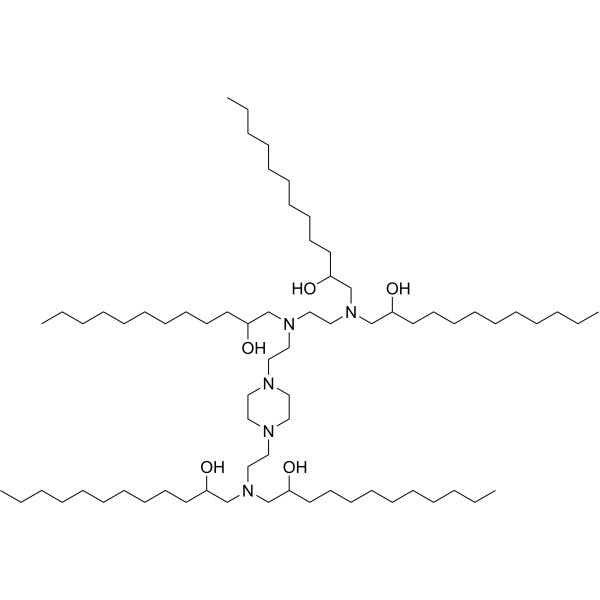
- HY-W440832
-
|
|
Liposome
|
Infection
|
|
DSPE-PEG-Azide, MW 2000 is an azide containing lipid that can be used to form micelles as nanoparticles for drug delivery . DSPE-PEG-Azide, MW 2000 is a click chemistry reagent, it contains an Azide group and can undergo copper-catalyzed azide-alkyne cycloaddition reaction (CuAAc) with molecules containing Alkyne groups. Strain-promoted alkyne-azide cycloaddition (SPAAC) can also occur with molecules containing DBCO or BCN groups.
|
-

- HY-137499
-
|
|
Liposome
Endogenous Metabolite
|
Neurological Disease
|
|
NT1-O12B, an endogenous chemical and a neurotransmitter-derived lipidoid (NT-lipidoid), is an effective carrier for enhanced brain delivery of several blood-brain barrier (BBB)-impermeable cargos. Doping NT1-O12B into BBB-impermeable lipid nanoparticles (LNPs) gives the LNPs the ability to cross the BBB. NT-lipidoids formulation not only facilitate cargo crossing of the BBB, but also delivery of the cargo into neuronal cells for functional gene silencing or gene recombination .
|
-
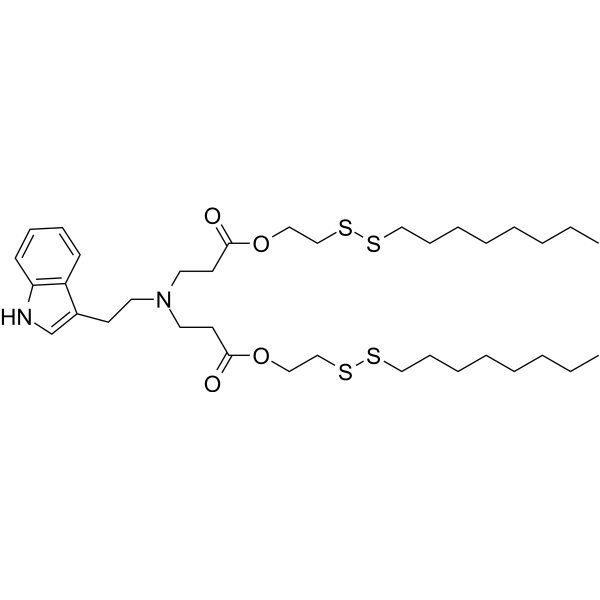
- HY-153234
-
|
|
CD19
Liposome
|
Inflammation/Immunology
Cancer
|
|
CD19 car circRNA-LNP is a lipid nanoparticle (LNP) containing CD19 car circRNA, suitable for detection of RNA delivery, translation efficiency, cell viability, etc. CD19 car circRNA can be used in chimeric antigen receptor T cell immunotherapy (CAR-CD19). The CD19 car is a chimeric antigen receptor. Among them, CD19 is a CD molecule expressed by B cells (i.e. leukocyte differentiation antigen), an important membrane antigen involved in B cell proliferation, differentiation, activation and antibody production, and can also promote BCR signal transduction .
|
-

- HY-153233
-
|
|
CD19
Liposome
|
Inflammation/Immunology
Cancer
|
|
CD19 car mRNA-LNP is a lipid nanoparticle (LNP) containing CD19 car mRNA, suitable for detection of RNA delivery, translation efficiency, cell viability, etc. CD19 car mRNA can be used in chimeric antigen receptor T cell immunotherapy (CAR-CD19). The CD19 car is a chimeric antigen receptor. Among them, CD19 is a CD molecule expressed by B cells (i.e. leukocyte differentiation antigen), an important membrane antigen involved in B cell proliferation, differentiation, activation and antibody production, and can also promote BCR signal transduction .
|
-

| Cat. No. |
Product Name |
Type |
-
- HY-148648
-
|
|
Drug Delivery
|
|
Lipid 29 is an ionizable amino lipid. Lipid 29 can be used to form lipid nanoparticles .
|
-
- HY-46759
-
|
|
Drug Delivery
|
|
Genevant CL1 is an ionizable lipid (lipid 10, pKa=6.3), and it can be used for mRNA lipid nanoparticle (LNP) vaccine delivery [1][2].
|
-
- HY-153187
-
|
|
Drug Delivery
|
|
LNP Lipid-4 (Compound 8-8) is a lipid compound. LNP Lipid-4 is involved in the synthesis of lipid nanoparticles compositions. LNP Lipid-4 has potential applications in the transportation of biologically active substances .
|
-
- HY-133952
-
|
|
Drug Delivery
|
|
7-Oxotridecanedioic acid is a biodegradable cationic lipid intermediate compound for lipid nanoparticles formation. 7-Oxotridecanedioic acid can be incorporated into a lipid particle for delivering active agents .
|
-
- HY-W440779
-
|
|
Drug Delivery
|
|
BP Lipid 135 is a cationieally ionizable lipid. BP Lipid 135 can be used to prepare lipid nanoparticles (LNP) (WO2022218503A1) .
|
-
- HY-153375
-
|
|
Drug Delivery
|
|
LNP Lipid-5 (Compound Lipid 2) is an ionizable lipid (amino lipid). LNP Lipid-5 can be used to prepare lipid nanoparticles (LNP) .
|
-
- HY-153376
-
|
|
Drug Delivery
|
|
LNP Lipid-6 (Compound Lipid 5) is an ionizable lipid (amino lipid). LNP Lipid-6 can be used to prepare lipid nanoparticles (LNP) .
|
-
- HY-141629
-
|
Sphingomyelin 16:0
|
Drug Delivery
|
|
N-Palmitoyl-D-sphingomyelin (Sphingomyelin 16:0) (Compound SM-03) can be used for the synthesis of lipid nanoparticles .
|
-
- HY-W040193
-
DSPC
2 Publications Verification
1,2-Distearoyl-sn-glycero-3-PC; 1,2-Distearoyl-sn-glycero-3-phosphorylcholine
|
Drug Delivery
|
|
DSPC (1,2-Distearoyl-sn-glycero-3-phosphorylcholine) is a cylindrical-shaped lipid. DSPC is used to synthesize liposomes, and is the lipid component in the lipid nanoparticle (LNP) system .
|
-
- HY-134541
-
SM-102
Maximum Cited Publications
7 Publications Verification
|
Drug Delivery
|
|
SM-102 is an amino cationic lipid useful in the formation of lipid nanoparticles (LNPs). SM-102 has higher transfection efficiency. SM-102 plays an important role in the effectiveness of lipid nanoparticles (LNPs) in delivering mRNA therapeutics and vaccines .
|
-
- HY-W441014
-
|
|
Drug Delivery
|
|
DSPE-PEG-NHS, MW 2000 is a pegylated phospholipid derivatives which can be used to prepare liposome or lipid nanoparticles for targeted drug delivery system, such as DNA or mRNA vaccine.
|
-
- HY-143700
-
|
|
Drug Delivery
|
|
18:0 DAP can be used to formulate lipid nanoparticles (LNPs), which mRNA is encapsulated in their core .
|
-
- HY-157252
-
|
|
Drug Delivery
|
|
CL4F8-6 is an ionizable cationic lipid with a pKa of 6.14. CL4F8-6 can be used in lipid nanoparticles (LNPs)-based mRNA therapeutics. CL4F8-6 LNPs carrying Cas9 mRNA and sgRNA could induce CRISPR-mediated gene knockdown in mice .
|
-
- HY-151507
-
|
|
Drug Delivery
|
|
306Oi10 is a branched-chain ionizable lipidoid that can be used for constructing lipid nanoparticles (LNPs) for the delivery of messenger RNA .
|
-
- HY-138170
-
ALC-0315
Maximum Cited Publications
7 Publications Verification
|
Drug Delivery
|
|
ALC-0315 is an ionisable aminolipid that is responsible for mRNA compaction and aids mRNA cellular delivery and its cytoplasmic release through suspected endosomal destabilization. ALC-0315 can be used to form lipid nanoparticle (LNP) delivery vehicles. Lipid-Nanoparticles have been used in the research of mRNA COVID-19 vaccine .
|
-
- HY-151508
-
|
|
Drug Delivery
|
|
Diamino lipid DAL4 is diamino lipid for the preparation of lipid nanoparticles (LNPs) encapsulated with mRNAs encoding cytokines including IL-12, IL-27 and GM-CSF. Diamino lipid DAL4 delivers mRNA to tumor cells to exert anti-tumor activity .
|
-
- HY-148363
-
|
|
Drug Delivery
|
|
Heptadecan-9-yl 8-((6-(decyloxy)-6-oxohexyl)(2-hydroxyethyl)amino)octanoate can be used in lipid nanoparticles (LNP) delivery systems for mRNA vaccine delivery .
|
-
- HY-W440835
-
|
|
Drug Delivery
|
|
DSPE-PEG-DBCO, MW 2000 is a phospholipid-PEG polymer that can be used to form micelles as lipid nanoparticles for drug delivery . DSPE-PEG-DBCO, MW 2000 is a click chemistry reagent, it contains a DBCO group that can undergo strain-promoted alkyne-azide cycloaddition (SPAAC) with molecules containing Azide groups.
|
-
- HY-125924
-
|
DSPE-PEG-NH2, MW 2000 ammonium
|
Drug Delivery
|
|
DSPE-PEG-Amine, MW 2000 (ammonium), an amine derivative of phospholipid poly ethylene glycol, is used in the synthesis of solid lipid and thermosensitive liposomal nanoparticles for the delivery of anticancer agents .
|
-
- HY-139306
-
|
|
Drug Delivery
|
|
BAMEAO16B is a lipid nanoparticle. BAMEAO16B integrated with disulfide bonds, can efficiently deliver Cas9 mRNA and sgRNA into cells while releasing RNA in response to the reductive intracellular environment for genome editing. BAMEAO16B can be used for the research of gene editing .
|
-
- HY-W414069
-
|
|
Drug Delivery
|
|
Thiocholesterol is a member of the class of cholesteric liquid crystals (CLCs) that can be used to synthesis cationic lipid. Thiocholesterol is a stronger stabilizer of silver nanoparticles (SNPs). Thiocholesterol can be used for plasma membrane research and drug delivery .
|
-
- HY-147332
-
|
|
Drug Delivery
|
|
TCL053 is an ionizable lipid carrier and used to introduce active components, in particular nucleic acids, into cells with excellent efriciency. TCL053, together with DPPC (Dipalmitoylphosphatidylcholine), PEG-DMG (Polyethylene glycoldimyristoyl glycerol), and cholesterol, forms lipid nanoparticle (LNP) which is able to deliver Cas9 mRNA and sgRNA into skeletal muscle .
|
-
- HY-150116
-
|
|
Drug Delivery
|
|
Lipid 1 is an ionizable amino lipid used for the generation of Lipid nanoparticles (LNPs).
|
-
- HY-150115
-
|
|
Drug Delivery
|
|
Lipid 10 is an ionizable amino lipid used for the generation of Lipid nanoparticles (LNPs).
|
-
- HY-153378
-
|
|
Drug Delivery
|
|
Lipid 15 is an ionizable amino lipid used for the generation of Lipid nanoparticles (LNPs).
|
-
- HY-150117
-
|
|
Drug Delivery
|
|
Lipid 6 is an ionizable amino lipid used for the generation of Lipid nanoparticles (LNPs).
|
-
- HY-150118
-
|
|
Drug Delivery
|
|
Lipid 8 is an ionizable amino lipid used for the generation of Lipid nanoparticles (LNPs).
|
-
- HY-153377
-
|
|
Drug Delivery
|
|
Lipid 14 is a potent ionizable lipid and can be used to synthesize lipid nanoparticles (LNPs) .
|
-
- HY-153186
-
|
|
Drug Delivery
|
|
LNP Lipid-3 is an ionizable lipid extracted from patent WO2021113777A, and can be used for the generation of Lipid nanoparticles (LNPs).
|
-
- HY-134782
-
|
|
Drug Delivery
|
|
OF-Deg-Lin is an ionizable amino lipid used for the generation of Lipid nanoparticles (LNPs).
|
-
- HY-153852
-
|
|
Drug Delivery
|
|
1LNP Lipid-7 (Compound 7013) is a lipid. LNP Lipid-6 can be used to prepare lipid nanoparticles (LNP) and for drug delivery .
|
-
- HY-153373
-
|
|
Drug Delivery
|
|
4A3-Cit is an ionizable lipid used for the generation of lipid nanoparticles (LNPs).
|
-
- HY-144012A
-
|
DPPE-PEG350; 1,2-Dipalmitoyl-sn-glycero-3-phosphoethanolamine-N-[methoxy(polyethylene glycol)-350] ammonium
|
Drug Delivery
|
|
16:0 PEG350 PE is a PEG lipid functional end group used in the synthesis of liposomes (LPs) for the design of conjugated polymer nanoparticles. Through biotin modification and carboxyl terminus, lipid nanoparticles (LNPs) further coupling with other biomolecules can be achieved. Functionalized nanoparticles can be used for targeted labeling of specific cellular proteins. With streptavidin as a linker, biotinylated PEG lipid-conjugated polymer nanoparticles are able to bind to biotinylated antibodies on cell surface receptors, yielding the utility of fluorescence-based imaging and sensing.
|
-
- HY-144012B
-
|
DPPE-PEG550; 1,2-Dipalmitoyl-sn-glycero-3-phosphoethanolamine-N-[methoxy(polyethylene glycol)-550] ammonium
|
Drug Delivery
|
|
16:0 PEG550 PE is a PEG lipid functional end group used in the synthesis of liposomes (LPs) for the design of conjugated polymer nanoparticles. Through biotin modification and carboxyl terminus, lipid nanoparticles (LNPs) further coupling with other biomolecules can be achieved. Functionalized nanoparticles can be used for targeted labeling of specific cellular proteins. With streptavidin as a linker, biotinylated PEG lipid-conjugated polymer nanoparticles are able to bind to biotinylated antibodies on cell surface receptors, yielding the utility of fluorescence-based imaging and sensing.
|
-
- HY-144012C
-
|
DPPE-PEG750; 1,2-Dipalmitoyl-sn-glycero-3-phosphoethanolamine-N-[methoxy(polyethylene glycol)-750] ammonium
|
Drug Delivery
|
|
16:0 PEG750 PE is a PEG lipid functional end group used in the synthesis of liposomes (LPs) for the design of conjugated polymer nanoparticles. Through biotin modification and carboxyl terminus, lipid nanoparticles (LNPs) further coupling with other biomolecules can be achieved. Functionalized nanoparticles can be used for targeted labeling of specific cellular proteins. With streptavidin as a linker, biotinylated PEG lipid-conjugated polymer nanoparticles are able to bind to biotinylated antibodies on cell surface receptors, yielding the utility of fluorescence-based imaging and sensing.
|
-
- HY-144013A
-
|
DSPE-mPEG350 ammonium; 1,2-Distearoyl-sn-glycero-3-phosphoethanolamine-N-[methoxy(polyethylene glycol)-350] ammonium
|
Drug Delivery
|
|
18:0 mPEG350 PE (ammonium) is a PEG lipid functional end group used in the synthesis of liposomes (LPs) for the design of conjugated polymer nanoparticles. Through biotin modification and carboxyl terminus, lipid nanoparticles (LNPs) further coupling with other biomolecules can be achieved. Functionalized nanoparticles can be used for targeted labeling of specific cellular proteins. With streptavidin as a linker, biotinylated PEG lipid-conjugated polymer nanoparticles are able to bind to biotinylated antibodies on cell surface receptors, yielding the utility of fluorescence-based imaging and sensing.
|
-
- HY-144013B
-
|
DSPE-mPEG550 ammonium; 1,2-Distearoyl-sn-glycero-3-phosphoethanolamine-N-[methoxy(polyethylene glycol)-550] ammonium
|
Drug Delivery
|
|
18:0 mPEG550 PE (ammonium) is a PEG lipid functional end group used in the synthesis of liposomes (LPs) for the design of conjugated polymeric nanoparticles. Through biotin modification and carboxyl terminus, lipid nanoparticles (LNPs) further coupling with other biomolecules can be achieved. Functionalized nanoparticles can be used for targeted labeling of specific cellular proteins. With streptavidin as a linker, biotinylated PEG lipid-conjugated polymer nanoparticles are able to bind to biotinylated antibodies on cell surface receptors, yielding the utility of fluorescence-based imaging and sensing.
|
-
- HY-144013C
-
|
DSPE-mPEG750 ammonium; 1,2-Distearoyl-sn-glycero-3-phosphoethanolamine-N-[methoxy(polyethylene glycol)-750] ammonium
|
Drug Delivery
|
|
18:0 mPEG750 PE (ammonium) is a PEG lipid functional end group used in the synthesis of liposomes (LPs) for the design of conjugated polymeric nanoparticles. Through biotin modification and carboxyl terminus, lipid nanoparticles (LNPs) further coupling with other biomolecules can be achieved. Functionalized nanoparticles can be used for targeted labeling of specific cellular proteins. With streptavidin as a linker, biotinylated PEG lipid-conjugated polymer nanoparticles are able to bind to biotinylated antibodies on cell surface receptors, yielding the utility of fluorescence-based imaging and sensing.
|
-
- HY-144012D
-
|
DPPE-PEG1000; 1,2-Dipalmitoyl-sn-glycero-3-phosphoethanolamine-N-[methoxy(polyethylene glycol)-1000] ammonium
|
Drug Delivery
|
|
16:0 PEG1000 PE is a PEG lipid functional end group used in the synthesis of liposomes (LPs) for the design of conjugated polymer nanoparticles. Through biotin modification and carboxyl terminus, lipid nanoparticles (LNPs) further coupling with other biomolecules can be achieved. Functionalized nanoparticles can be used for targeted labeling of specific cellular proteins. With streptavidin as a linker, biotinylated PEG lipid-conjugated polymer nanoparticles are able to bind to biotinylated antibodies on cell surface receptors, yielding the utility of fluorescence-based imaging and sensing.
|
-
- HY-144012E
-
|
DPPE-PEG3000; 1,2-Dipalmitoyl-sn-glycero-3-phosphoethanolamine-N-[methoxy(polyethylene glycol)-3000] ammonium
|
Drug Delivery
|
|
16:0 PEG3000 PE is a PEG lipid functional end group used in the synthesis of liposomes (LPs) for the design of conjugated polymer nanoparticles. Through biotin modification and carboxyl terminus, lipid nanoparticles (LNPs) further coupling with other biomolecules can be achieved. Functionalized nanoparticles can be used for targeted labeling of specific cellular proteins. With streptavidin as a linker, biotinylated PEG lipid-conjugated polymer nanoparticles are able to bind to biotinylated antibodies on cell surface receptors, yielding the utility of fluorescence-based imaging and sensing.
|
-
- HY-144012H
-
|
DPPE-PEG5000; 1,2-Dipalmitoyl-sn-glycero-3-phosphoethanolamine-N-[methoxy(polyethylene glycol)-5000] ammonium
|
Drug Delivery
|
|
16:0 PEG5000 PE is a PEG lipid functional end group used in the synthesis of liposomes (LPs) for the design of conjugated polymer nanoparticles. Through biotin modification and carboxyl terminus, lipid nanoparticles (LNPs) further coupling with other biomolecules can be achieved. Functionalized nanoparticles can be used for targeted labeling of specific cellular proteins. With streptavidin as a linker, biotinylated PEG lipid-conjugated polymer nanoparticles are able to bind to biotinylated antibodies on cell surface receptors, yielding the utility of fluorescence-based imaging and sensing.
|
-
- HY-144013D
-
|
DSPE-mPEG1000 ammonium; 1,2-Distearoyl-sn-glycero-3-phosphoethanolamine-N-[methoxy(polyethylene glycol)-1000] ammonium
|
Drug Delivery
|
|
18:0 mPEG1000 PE (ammonium) is a PEG lipid functional end group used in the synthesis of liposomes (LPs) for the design of conjugated polymeric nanoparticles. Through biotin modification and carboxyl terminus, lipid nanoparticles (LNPs) further coupling with other biomolecules can be achieved. Functionalized nanoparticles can be used for targeted labeling of specific cellular proteins. With streptavidin as a linker, biotinylated PEG lipid-conjugated polymer nanoparticles are able to bind to biotinylated antibodies on cell surface receptors, yielding the utility of fluorescence-based imaging and sensing.
|
-
- HY-144013E
-
|
DSPE-mPEG3000 ammonium; 1,2-Distearoyl-sn-glycero-3-phosphoethanolamine-N-[methoxy(polyethylene glycol)-3000] ammonium
|
Drug Delivery
|
|
18:0 mPEG3000 PE (ammonium) is a PEG lipid functional end group used in the synthesis of liposomes (LPs) for the design of conjugated polymeric nanoparticles. Through biotin modification and carboxyl terminus, lipid nanoparticles (LNPs) further coupling with other biomolecules can be achieved. Functionalized nanoparticles can be used for targeted labeling of specific cellular proteins. With streptavidin as a linker, biotinylated PEG lipid-conjugated polymer nanoparticles are able to bind to biotinylated antibodies on cell surface receptors, yielding the utility of fluorescence-based imaging and sensing.
|
-
- HY-144013H
-
|
DSPE-mPEG5000 ammonium; 1,2-Distearoyl-sn-glycero-3-phosphoethanolamine-N-[methoxy(polyethylene glycol)-5000] ammonium
|
Drug Delivery
|
|
18:0 mPEG5000 PE (ammonium) is a PEG lipid functional end group used in the synthesis of liposomes (LPs) for the design of conjugated polymeric nanoparticles. Through biotin modification and carboxyl terminus, lipid nanoparticles (LNPs) further coupling with other biomolecules can be achieved. Functionalized nanoparticles can be used for targeted labeling of specific cellular proteins. With streptavidin as a linker, biotinylated PEG lipid-conjugated polymer nanoparticles are able to bind to biotinylated antibodies on cell surface receptors, yielding the utility of fluorescence-based imaging and sensing.
|
-
- HY-155924
-
|
DMPE-PEG350; 1,2-Dimyristoyl-sn-glycero-3-phosphoethanolamine-N-[methoxy(polyethylene glycol)-350] ammonium
|
Drug Delivery
|
|
14:0 PEG350 PE is a PEG lipid functional end group used in the synthesis of liposomes (LPs) for the design of conjugated polymer nanoparticles. Through biotin modification and carboxyl terminus, lipid nanoparticles (LNPs) further coupling with other biomolecules can be achieved. Functionalized nanoparticles can be used for targeted labeling of specific cellular proteins. With streptavidin as a linker, biotinylated PEG lipid-conjugated polymer nanoparticles are able to bind to biotinylated antibodies on cell surface receptors, yielding the utility of fluorescence-based imaging and sensing.
|
-
- HY-155925
-
|
DMPE-PEG550; 1,2-Dimyristoyl-sn-glycero-3-phosphoethanolamine-N-[methoxy(polyethylene glycol)-550] ammonium
|
Drug Delivery
|
|
14:0 PEG550 PE is a PEG lipid functional end group used in the synthesis of liposomes (LPs) for the design of conjugated polymeric nanoparticles. Through biotin modification and carboxyl terminus, lipid nanoparticles (LNPs) further coupling with other biomolecules can be achieved. Functionalized nanoparticles can be used for targeted labeling of specific cellular proteins. With streptavidin as a linker, biotinylated PEG lipid-conjugated polymer nanoparticles are able to bind to biotinylated antibodies on cell surface receptors, yielding the utility of fluorescence-based imaging and sensing.
|
-
- HY-155926
-
|
DMPE-PEG750; 1,2-Dimyristoyl-sn-glycero-3-phosphoethanolamine-N-[methoxy(polyethylene glycol)-750] ammonium
|
Drug Delivery
|
|
14:0 PEG750 PE is a PEG lipid functional end group used in the synthesis of liposomes (LPs) for the design of conjugated polymeric nanoparticles. Through biotin modification and carboxyl terminus, lipid nanoparticles (LNPs) further coupling with other biomolecules can be achieved. Functionalized nanoparticles can be used for targeted labeling of specific cellular proteins. With streptavidin as a linker, biotinylated PEG lipid-conjugated polymer nanoparticles are able to bind to biotinylated antibodies on cell surface receptors, yielding the utility of fluorescence-based imaging and sensing.
|
-
- HY-155927
-
|
DMPE-PEG1000; 1,2-Dimyristoyl-sn-glycero-3-phosphoethanolamine-N-[methoxy(polyethylene glycol)-1000] ammonium
|
Drug Delivery
|
|
14:0 PEG1000 PE is a PEG lipid functional end group used in the synthesis of liposomes (LPs) for the design of conjugated polymer nanoparticles. Through biotin modification and carboxyl terminus, lipid nanoparticles (LNPs) further coupling with other biomolecules can be achieved. Functionalized nanoparticles can be used for targeted labeling of specific cellular proteins. With streptavidin as a linker, biotinylated PEG lipid-conjugated polymer nanoparticles are able to bind to biotinylated antibodies on cell surface receptors, yielding the utility of fluorescence-based imaging and sensing.
|
-
- HY-155928
-
|
DMPE-PEG3000; 1,2-Dimyristoyl-sn-glycero-3-phosphoethanolamine-N-[methoxy(polyethylene glycol)-3000] ammonium
|
Drug Delivery
|
|
14:0 PEG3000 PE is a PEG lipid functional end group used in the synthesis of liposomes (LPs) for the design of conjugated polymer nanoparticles. Through biotin modification and carboxyl terminus, lipid nanoparticles (LNPs) further coupling with other biomolecules can be achieved. Functionalized nanoparticles can be used for targeted labeling of specific cellular proteins. With streptavidin as a linker, biotinylated PEG lipid-conjugated polymer nanoparticles are able to bind to biotinylated antibodies on cell surface receptors, yielding the utility of fluorescence-based imaging and sensing.
|
-
- HY-155929
-
|
DMPE-PEG5000; 1,2-Dimyristoyl-sn-glycero-3-phosphoethanolamine-N-[methoxy(polyethylene glycol)-5000] ammonium
|
Drug Delivery
|
|
14:0 PEG5000 PE is a PEG lipid functional end group used in the synthesis of liposomes (LPs) for the design of conjugated polymer nanoparticles. Through biotin modification and carboxyl terminus, lipid nanoparticles (LNPs) further coupling with other biomolecules can be achieved. Functionalized nanoparticles can be used for targeted labeling of specific cellular proteins. With streptavidin as a linker, biotinylated PEG lipid-conjugated polymer nanoparticles are able to bind to biotinylated antibodies on cell surface receptors, yielding the utility of fluorescence-based imaging and sensing.
|
- HY-155930
-
|
DOPE-PEG350; 1,2-Dioleoyl-sn-glycero-3-phosphoethanolamine-N-[methoxy(polyethylene glycol)-350] ammonium
|
Drug Delivery
|
|
18:1 PEG350 PE is a PEG lipid functional end group used in the synthesis of liposomes (LPs) for the design of conjugated polymer nanoparticles. Through biotin modification and carboxyl terminus, lipid nanoparticles (LNPs) further coupling with other biomolecules can be achieved. Functionalized nanoparticles can be used for targeted labeling of specific cellular proteins. With streptavidin as a linker, biotinylated PEG lipid-conjugated polymer nanoparticles are able to bind to biotinylated antibodies on cell surface receptors, yielding the utility of fluorescence-based imaging and sensing.
|
- HY-155931
-
|
DOPE-PEG550; 1,2-Dioleoyl-sn-glycero-3-phosphoethanolamine-N-[methoxy(polyethylene glycol)-550] ammonium
|
Drug Delivery
|
|
18:1 PEG550 PE is a PEG lipid functional end group used in the synthesis of liposomes (LPs) for the design of conjugated polymer nanoparticles. Through biotin modification and carboxyl terminus, lipid nanoparticles (LNPs) further coupling with other biomolecules can be achieved. Functionalized nanoparticles can be used for targeted labeling of specific cellular proteins. With streptavidin as a linker, biotinylated PEG lipid-conjugated polymer nanoparticles are able to bind to biotinylated antibodies on cell surface receptors, yielding the utility of fluorescence-based imaging and sensing.
|
- HY-155932
-
|
DOPE-PEG1000; 1,2-Dioleoyl-sn-glycero-3-phosphoethanolamine-N-[methoxy(polyethylene glycol)-1000] ammonium
|
Drug Delivery
|
|
18:1 PEG1000 PE is a PEG lipid functional end group used in the synthesis of liposomes (LPs) for the design of conjugated polymer nanoparticles. Through biotin modification and carboxyl terminus, lipid nanoparticles (LNPs) further coupling with other biomolecules can be achieved. Functionalized nanoparticles can be used for targeted labeling of specific cellular proteins. With streptavidin as a linker, biotinylated PEG lipid-conjugated polymer nanoparticles are able to bind to biotinylated antibodies on cell surface receptors, yielding the utility of fluorescence-based imaging and sensing.
|
- HY-155933
-
|
DOPE-PEG3000; 1,2-Dioleoyl-sn-glycero-3-phosphoethanolamine-N-[methoxy(polyethylene glycol)-3000] ammonium
|
Drug Delivery
|
|
18:1 PEG3000 PE is a PEG lipid functional end group used in the synthesis of liposomes (LPs) for the design of conjugated polymer nanoparticles. Through biotin modification and carboxyl terminus, lipid nanoparticles (LNPs) further coupling with other biomolecules can be achieved. Functionalized nanoparticles can be used for targeted labeling of specific cellular proteins. With streptavidin as a linker, biotinylated PEG lipid-conjugated polymer nanoparticles are able to bind to biotinylated antibodies on cell surface receptors, yielding the utility of fluorescence-based imaging and sensing.
|
- HY-155934
-
|
DOPE-PEG5000; 1,2-Dioleoyl-sn-glycero-3-phosphoethanolamine-N-[methoxy(polyethylene glycol)-5000] ammonium
|
Drug Delivery
|
|
18:1 PEG5000 PE is a PEG lipid functional end group used in the synthesis of liposomes (LPs) for the design of conjugated polymer nanoparticles. Through biotin modification and carboxyl terminus, lipid nanoparticles (LNPs) further coupling with other biomolecules can be achieved. Functionalized nanoparticles can be used for targeted labeling of specific cellular proteins. With streptavidin as a linker, biotinylated PEG lipid-conjugated polymer nanoparticles are able to bind to biotinylated antibodies on cell surface receptors, yielding the utility of fluorescence-based imaging and sensing.
|
- HY-149156
-
|
|
Drug Delivery
|
|
Lipid C24 is a cationic ionizable lipid, and can be used in the formation of lipid nanoparticles (LNPs). Lipid C24 can be used for research of delivery of nucleic acids .
|
- HY-W590532
-
|
|
Drug Delivery
|
|
306-O12B is an ionizable cationic lipid used for the generation of lipid nanoparticles (LNPs).
|
- HY-156630
-
|
|
Drug Delivery
|
|
Ionizable lipid-1 (compound II-10) is an ionizable lipid (pKa=6.16) that can be used to prepare lipid nanoparticles (LNP) with bilayer structure .
|
- HY-156630A
-
|
|
Drug Delivery
|
|
Ionizable lipid-1 (compound II-10) is an ionizable lipid (pKa=6.16) that can be used to prepare lipid nanoparticles (LNP) with bilayer structure .
|
- HY-W440810
-
|
|
Drug Delivery
|
|
Undecyl 6-bromohexanoate can be useful for the preparation of lipid nanoparticles.
|
- HY-149167
-
|
|
Drug Delivery
|
|
mRNA-Encapsulating Lipid Excipient 1 (Compound 2) is a Thiocarbamate-Based Ionizable Lipid. mRNA-Encapsulating Lipid Excipient 1 can be used as an excipient in mRNA-encapsulating lipid nanoparticle .
|
- HY-153372
-
|
|
Drug Delivery
|
|
93-O17S is a chalcogen-containing ionizable cationic lipid used for making lipid nanoparticles (LNPs).
|
- HY-46759A
-
|
|
Drug Delivery
|
|
Genevant CL1 monohydrochloride is an ionizable lipid (lipid 10, pKa=6.3), and it can be used for mRNA lipid nanoparticle (LNP) vaccine delivery .
|
- HY-113217
-
|
|
Drug Delivery
|
|
Cholesteryl oleate is an esterified form of Cholesterol. Cholesteryl oleate can be used in the generation of solid lipid nanoparticle (SLN, a nanoparticle-based method for gene therapy) .
|
- HY-153136
-
|
|
Drug Delivery
|
|
LNP Lipid-1 (Method B) is a lipid compound. LNP Lipid-1 is involved in the synthesis of lipid nanoparticles compositions. LNP Lipid-1 has potential applications in the transport of biologically active substances such as small molecule agents, proteins, and nucleic acids .
|
- HY-W440811
-
|
|
Drug Delivery
|
|
6-Bromohexyl 2-hexyldecanoate is a lipid. 6-Bromohexyl 2-hexyldecanoate can be used to build lipid nanoparticles and nanomaterials .
|
- HY-148842
-
|
|
Drug Delivery
|
|
C14-4 is an ionizable lipid for lipid nanoparticles (LNPs) formulation. C14-4 was identified for its potent transfection and low cytotoxicity.
|
- HY-112756
-
|
|
Drug Delivery
|
|
PEG2000-DGG is a synthetic lipid. PEG2000-DGG can be used in lipid-based nanoparticle (LNP) delivery systems .
|
- HY-W590678
-
|
|
Drug Delivery
|
|
SSPalmO-Phe is an ionizable cationic self-degradable disulfide-cleavable (SS-cleavable) proton-activated lipid-like material. It has been used in combination with other lipids in the formation of lipid nanoparticles (LNPs) for drug delivery.
|
- HY-142979
-
|
|
Drug Delivery
|
|
DSPE-PEG 2000 is a PEG-lipid that can be used to form micelles as nanoparticles for drug delivery .
|
- HY-W440813
-
|
|
Drug Delivery
|
|
Heptadecan-9-yl 8-bromooctanoate can be useful for the building or modification of lipid nanoparticles.
|
- HY-145794
-
|
|
Drug Delivery
|
|
ZA3-Ep10 is a zwitterionic lipid used in lipid nanoparticles formulation for in vivo RNA delivery and non-viral CRISPR/Cas gene editing.
|
- HY-148830
-
|
|
Drug Delivery
|
|
Piperazine-bis(ethyl octadeca-9,12-dienoate) is a cationic lipid extracted from patent WO2023036148A1, and can be used for the generation of Lipid nanoparticles (LNPs).
|
- HY-134781
-
CKK-E12
1 Publications Verification
|
Drug Delivery
|
|
CKK-E12 is a ionizable lipid in combination with other lipids make up the lipid nanoparticles which are used to deliver RNA-based research. CKK-E12 is highly selective toward liver parenchymal cell in vivo,
|
- HY-112773
-
|
|
Drug Delivery
|
|
1,1′,1′′,1′′′-[1,4-Piperazinediylbis(2,1-ethanediylnitrilo)]tetrakis[2-dodecanol] is a lipid/lipidoid used in preparation of lipid-based or lipidoid nanoparticles .
|
- HY-153737
-
|
|
Drug Delivery
|
|
113-N16B is an ionizable cationic lipid used for the generation of lipid nanoparticles (LNPs). 113-N16B delivers mRNA preferentially to pulmonary endothelial cells.
|
- HY-153380
-
|
|
Drug Delivery
|
|
ALC-0315 analogue-2 is an analogue of ALC-0315. ALC-0315 is an ionisable aminolipid that is responsible for mRNA compaction and aids mRNA cellular delivery and its cytoplasmic release through suspected endosomal destabilization. ALC-0315 can be used to form lipid nanoparticle (LNP) delivery vehicles. Lipid-Nanoparticles have been used in the research of mRNA COVID-19 vaccine.
|
- HY-148855
-
|
|
Drug Delivery
|
|
OF-C4-Deg-Lin is an ionizable lipid with varied linker lengths. OF-C4-Deg-Lin can be used in the generation of lipid nanoparticles (LNPs) for the delivery of siRNA and mRNA .
|
- HY-W250183B
-
|
Polyethylene glycol octadecyl ether (n~20)
|
Surfactants
|
|
Polyoxyethylene (20) stearyl ether (Polyethylene glycol octadecyl ether) is a polyethylene glycolated lipid surfactant that can be used in the formation and stabilization studies of nanoparticles .
|
- HY-153235
-
|
|
Drug Delivery
|
|
COVID-19 Spike Protein mRNA-LNP is a lipid nanoparticle (LNP) containing COVID-19 Spike Protein, suitable for detection of RNA delivery, translation efficiency, cell viability, etc. COVID-19 Spike Protein is the novel coronavirus pneumonia spike protein located on the membrane surface. COVID-19 Spike Protein undertakes the functions of virus binding to host cell membrane receptors and membrane fusion, thereby mediating the entry of COVID-19 virus into cells. COVID-19 Spike Protein is an important site of action for host neutralizing antibodies and a key target for vaccine design .
|
- HY-112764
-
|
|
Drug Delivery
|
|
DMG-PEG 2000 is used for the preparation of liposome for siRNA delivery with improved transfection efficiency in vitro. DMG-PEG 2000 is also used for the lipid nanoparticle for an oral plasmid DNA delivery approach in vivo through a facile surface modification to improve the mucus permeability and delivery efficiency of the nanoparticles .
|
- HY-W441012
-
|
|
Drug Delivery
|
|
DSPE-PEG-NHS, MW 600 is a pegylated phospholipid derivatives which can be used to prepare liposome or lipid nanoparticles for targeted drug delivery system, such as DNA or mRNA vaccine.
|
- HY-W441015A
-
|
|
Drug Delivery
|
|
DSPE-m-PEG-NHS (MW 3400) is a pegylated phospholipid derivatives which can be used to prepare liposome or lipid nanoparticles for targeted drug delivery system, such as DNA or mRNA vaccine.
|
- HY-153371
-
|
|
Drug Delivery
|
|
50-C2-C9-4tail has been used in the generation of lipid nanoparticles (LNPs) for the delivery of siRNA and mRNA in vitro and in vivo.
|
- HY-W440683
-
|
|
Drug Delivery
|
|
C13-112-tetra-tail is a cationic lipid-like compound containing a polar amino alcohol head group, four hydrophobic carbon-13 tails, and a PEG2 linker. C13-112-tetra-tail can be formulated into a lipid nanoparticle (LNP).
|
- HY-W440681
-
|
|
Drug Delivery
|
|
C13-112-tri-tail is a cationic lipid-like compound containing a polar amino alcohol head group, three hydrophobic carbon-13 tails, and a PEG2 linker. C13-112-tri-tail can be formulated into a lipid nanoparticle (LNP).
|
- HY-W440684
-
|
|
Drug Delivery
|
|
C13-113-tetra tail is a cationic lipid-like compound containing a polar amino alcohol head group, four hydrophobic carbon-13 tails, and a tertiary amine linker. C13-113-tetra tail can be formulated into a lipid nanoparticle (LNP).
|
- HY-W440682
-
|
|
Drug Delivery
|
|
C13-113-tri tail is a cationic lipid-like compound containing a polar amino alcohol head group, three hydrophobic carbon-13 tails, and a tertiary amine linker. C13-113-tri tail can be formulated into a lipid nanoparticle (LNP).
|
- HY-141892A
-
|
|
Drug Delivery
|
|
DSPE-PEG Carboxylic acid (sodium), MW 2000 is a PEG-lipid that can be used to form micelles as nanoparticles for drug delivery. DSPE-PEG Carboxylic acid (sodium), MW 2000 increases the blood circulation time of liposomes .
|
- HY-112760
-
|
DSPE-mPEG2000 sodium; 1,2-Distearoyl-sn-glycero-3-phosphoethanolamine-N-[methoxy(polyethylene glycol)-2000] sodium
|
Drug Delivery
|
|
18:0 mPEG2000 PE sodium can be used for the preparation of stabilized nucleic acid-lipid particllipid particles (SNALPs). SNALPs represent some of the earliest and best functional siRNA-ABC nanoparticles described .
|
- HY-W440916
-
|
|
Drug Delivery
|
|
DSPE-PEG-FITC, MW 3400 is a fluorescein attached PEG lipid. It can be used to prepare liposomes as drug carrier in targeted drug delivery. The polymer is modified with fluorescein (green) dye which can be used for staining cells, tissues, biomarkers, or nanoparticles.
|
- HY-W440915
-
|
|
Drug Delivery
|
|
DSPE-PEG-FITC, MW 2000 is a fluorescein attached PEG lipid. It can be used to prepare liposomes as drug carrier in targeted drug delivery. The polymer is modified with fluorescein (green) dye which can be used for staining cells, tissues, biomarkers, or nanoparticles.
|
- HY-W440917
-
|
|
Drug Delivery
|
|
DSPE-PEG-FITC, MW 5000 is a fluorescein attached PEG lipid. It can be used to prepare liposomes as drug carrier in targeted drug delivery. The polymer is modified with fluorescein (green) dye which can be used for staining cells, tissues, biomarkers, or nanoparticles.
|
- HY-112758
-
|
|
Drug Delivery
|
|
DLin-KC2-DMA is an ionisable cationic lipid (pKa≈6) that is virtually non-toxic to antigen presenting cells (APCs). DLin-KC2-DMA produces significant siRNA-mediated gene silencing of GAPDH, when binds to lipid nanoparticles (LNP). DLin-KC2-DMA can be used in siRNA delivery studies .
|
- HY-W440921
-
|
|
Drug Delivery
|
|
DSPE-PEG-Rhodamine, MW 5000 is a phospholipid polyPEG with red fluorescent. The polymer can form lipid bilayer and be used to prepare nanoparticles or liposomes for targeted drug delivery. Rhodamine has maximum absorption at 570 nm and emission around 595 nm and can be easily traced using an imaging technique.
|
- HY-W440920
-
|
|
Drug Delivery
|
|
DSPE-PEG-Rhodamine, MW 3400 is a phospholipid polyPEG with red fluorescent. The polymer can form lipid bilayer and be used to prepare nanoparticles or liposomes for targeted drug delivery. Rhodamine has maximum absorption at 570 nm and emission around 595 nm and can be easily traced using an imaging technique.
|
- HY-148701
-
|
|
Drug Delivery
|
|
mono-Pal-MTO is a palm oil-based lipid produced by combining the anticancer agent mitoxantrone (MTO) with palmitoleic acid. When nanoparticles of mono-Pal-MTO and di-Pal-MTO are combined in a molar ratio of 1:1, they show effective siRNA cell delivery and enhance anticancer activity .
|
- HY-148702
-
|
|
Drug Delivery
|
|
di-Pal-MTO is a palm oil-based lipid produced by combining the anticancer agent mitoxantrone (MTO) with palmitoleic acid. When nanoparticles of mono-Pal-MTO and di-Pal-MTO are combined in a molar ratio of 1:1, they show effective siRNA cell delivery and enhance anticancer activity .
|
- HY-W440909
-
|
|
Drug Delivery
|
|
DSPE-PEG-Cy3, MW 3400 is a phospholipid PEG polymer with Cy3 dye used in labeling and fluorescence microscopy. The polymer can self-assemble in aqueous solution to form micelles/lipid bilayer and used to prepare liposomes or nanoparticles for nutrients delivery such as mRNA or DNA vaccine.
|
- HY-W440910
-
|
|
Drug Delivery
|
|
DSPE-PEG-Cy3, MW 5000 is a phospholipid PEG polymer with Cy3 dye used in labeling and fluorescence microscopy. The polymer can self-assemble in aqueous solution to form micelles/lipid bilayer and used to prepare liposomes or nanoparticles for nutrients delivery such as mRNA or DNA vaccine.
|
- HY-W440913
-
|
|
Drug Delivery
|
|
DSPE-PEG-Cy5, MW 5000 is a PEG phospholipid with Cy5 dye used in protein/nucelic acid labeling and fluorescence microscopy. The polymer can self-assemble in aqueous solution to form micelles/lipid bilayer and used to prepare liposomes or nanoparticles for nutrients delivery such as mRNA or DNA vaccine.
|
- HY-W440912
-
|
|
Drug Delivery
|
|
DSPE-PEG-Cy5, MW 3400 is a PEG phospholipid with Cy5 dye used in protein/nucelic acid labeling and fluorescence microscopy. The polymer can self-assemble in aqueous solution to form micelles/lipid bilayer and used to prepare liposomes or nanoparticles for nutrients delivery such as mRNA or DNA vaccine.
|
- HY-152229
-
|
|
Drug Delivery
|
|
G0-C14 is a cationic lipid-like compound alkyl-modified polyamidoamine (PAMAM) dendrimer. G0-C14 involves in the preparation of a series of macrophage-targeted nanoparticles (NPs). NPs can be used for agent and vaccine delivery .
|
- HY-112752
-
|
|
Drug Delivery
|
|
Gal-C4-Chol is a glycosylated cholesterol derivative. Gal-C4-Chol can be used as a ligand for asialoglycoprotein receptors (ASGPR) to prepare Galactosylated (Gal) liposomes. Gal-C4-Chol can be used to prepare simple lipid-based nanoparticles .
|
- HY-131119
-
|
Dioctadecyldimethylammonium bromide; DODAB
|
Drug Delivery
|
|
Dimethyldioctadecylammonium bromide is a synthetic cationic lipid commonly used in gene delivery and vaccine development. Also known as DODAB or DDAB, it consists of a positively charged ammonium head group and two long hydrophobic tails. These properties make it useful for forming liposomes and other lipid-based nanoparticles that can efficiently deliver genetic material into cells. In addition to its applications in biotechnology, DDAB is also used in surfactants, emulsifiers and fabric softeners. However, due to its potential toxicity and irritation, extreme care should be taken when handling DDAB.
|
- HY-W440940
-
|
|
Drug Delivery
|
|
Stearic acid-PEG-FITC, MW 5000 is a PEG lipid which forms micelles in water and can be used for drug delivery applications. The FITC fluorescent can be easily traced by miscroscopy. FITC is a green dye with peak absorption at 494 nm and maximum emission at 520 nm and can be used for staining biological samples or nanoparticles. FITC can be easily traced by fluorescence microscopy.
|
- HY-W440939
-
|
|
Drug Delivery
|
|
Stearic acid-PEG-FITC, MW 3400 is a PEG lipid which forms micelles in water and can be used for drug delivery applications. The FITC fluorescent can be easily traced by miscroscopy. FITC is a green dye with peak absorption at 494 nm and maximum emission at 520 nm and can be used for staining biological samples or nanoparticles. FITC can be easily traced by fluorescence microscopy.
|
- HY-137500
-
|
|
Drug Delivery
|
|
NT1-014B is a potent NT1-lipidoid encapsulated AmB (amphotericin B). NT1-014B dopes the NT-lipidoids into BBB-impermeable lipid nanoparticles (LNPs) gave the LNPs the ability to cross the BBB. NT1-014B enhances brain delivery through intravenous injection .
|
- HY-153231
-
|
|
Drug Delivery
|
|
eGFP mRNA-LNP is a lipid nanoparticle (LNP) containing eGFP mRNA, suitable for assays of RNA delivery, translation efficiency, cell viability, etc. eGFP circRNA carries Enhanced Green Fluorescent Protein (Enhanced Green Fluorescent Protein) eGFP, which will express green fluorescent protein after entering the cell. eGFP is commonly used as a reporter gene detectable by fluorescence microscopy or flow cytometry .
|
- HY-153232
-
|
|
Drug Delivery
|
|
eGFP circRNA-LNP is a lipid nanoparticle (LNP) containing eGFP circRNA, suitable for assays of RNA delivery, translation efficiency, cell viability, etc. eGFP circRNA carries Enhanced Green Fluorescent Protein (Enhanced Green Fluorescent Protein) eGFP, which will express green fluorescent protein after entering the cell. eGFP is commonly used as a reporter gene detectable by fluorescence microscopy or flow cytometry .
|
- HY-145405
-
C12-200
5 Publications Verification
|
Drug Delivery
|
|
C12-200 is an ionizable cationic lipid and auxiliary lipid. C12-200 is commonly used for mRNA delivery. Administration of human erythropoietin (EPO) mRNA or factor VII siRNA increased and decreased serum factor VII levels, respectively, in LNPs mice containing C12-200 .
|
- HY-W440832
-
|
|
Drug Delivery
|
|
DSPE-PEG-Azide, MW 2000 is an azide containing lipid that can be used to form micelles as nanoparticles for drug delivery . DSPE-PEG-Azide, MW 2000 is a click chemistry reagent, it contains an Azide group and can undergo copper-catalyzed azide-alkyne cycloaddition reaction (CuAAc) with molecules containing Alkyne groups. Strain-promoted alkyne-azide cycloaddition (SPAAC) can also occur with molecules containing DBCO or BCN groups.
|
- HY-153229
-
|
|
Drug Delivery
|
|
Firefly luciferase mRNA-LNP is a lipid nanoparticle (LNP) containing Firefly luciferase mRNA, suitable for assays of RNA delivery, translation efficiency, cell viability, etc. Luciferase is commonly used as a bioluminescent reporter gene for gene regulation and function studies. Firefly Luciferase mRNA will express firefly luciferase protein after entering the cells, which is often used for promoter activity detection or dual fluorescent molecular complementation experiments. Common luciferase are firefly luciferase and sea kidney luciferase .
|
- HY-153230
-
|
|
Drug Delivery
|
|
Firefly luciferase circRNA-LNP is a lipid nanoparticle (LNP) containing Firefly luciferase circRNA, suitable for assays of RNA delivery, translation efficiency, cell viability, etc. Luciferase is commonly used as a bioluminescent reporter gene for gene regulation and function studies. Firefly Luciferase circRNA will express firefly luciferase protein after entering the cells, which is often used for promoter activity detection or dual fluorescent molecular complementation experiments. Common luciferase are firefly luciferase and sea kidney luciferase .
|
- HY-137499
-
|
|
Drug Delivery
|
|
NT1-O12B, an endogenous chemical and a neurotransmitter-derived lipidoid (NT-lipidoid), is an effective carrier for enhanced brain delivery of several blood-brain barrier (BBB)-impermeable cargos. Doping NT1-O12B into BBB-impermeable lipid nanoparticles (LNPs) gives the LNPs the ability to cross the BBB. NT-lipidoids formulation not only facilitate cargo crossing of the BBB, but also delivery of the cargo into neuronal cells for functional gene silencing or gene recombination .
|
- HY-153234
-
|
|
Drug Delivery
|
|
CD19 car circRNA-LNP is a lipid nanoparticle (LNP) containing CD19 car circRNA, suitable for detection of RNA delivery, translation efficiency, cell viability, etc. CD19 car circRNA can be used in chimeric antigen receptor T cell immunotherapy (CAR-CD19). The CD19 car is a chimeric antigen receptor. Among them, CD19 is a CD molecule expressed by B cells (i.e. leukocyte differentiation antigen), an important membrane antigen involved in B cell proliferation, differentiation, activation and antibody production, and can also promote BCR signal transduction .
|
- HY-153233
-
|
|
Drug Delivery
|
|
CD19 car mRNA-LNP is a lipid nanoparticle (LNP) containing CD19 car mRNA, suitable for detection of RNA delivery, translation efficiency, cell viability, etc. CD19 car mRNA can be used in chimeric antigen receptor T cell immunotherapy (CAR-CD19). The CD19 car is a chimeric antigen receptor. Among them, CD19 is a CD molecule expressed by B cells (i.e. leukocyte differentiation antigen), an important membrane antigen involved in B cell proliferation, differentiation, activation and antibody production, and can also promote BCR signal transduction .
|
| Cat. No. |
Product Name |
Target |
Research Area |
-
- HY-113736
-
|
|
Amino Acid Derivatives
|
Others
|
|
Glycyllysine is a polypeptide that can be used in the synthesis of antibodies and amino acid type gemini surfactants. Glycyllysine has potential applications in modifying plasmid/gemini/lipid (P/G/L) nanoparticles transport carriers .
|
| Cat. No. |
Product Name |
Category |
Target |
Chemical Structure |
| Cat. No. |
Product Name |
Chemical Structure |
-
- HY-W040193S
-
|
|
|
1,2-Distearoyl-sn-glycero-3-phosphorylcholine-d70 is the deuterium labeled 1,2-Distearoyl-sn-glycero-3-phosphorylcholine. 1,2-Distearoyl-sn-glycero-3-phosphorylcholine (1,2-Distearoyl-sn-glycero-3-PC; DSPC) is a cylindrical-shaped lipid. 1,2-Distearoyl-sn-glycero-3-phosphorylcholine is used to synthesize liposomes, and is the lipid component in the lipid nanoparticle (LNP) system[1][2].
|
-

-
- HY-113217S1
-
|
|
|
Cholesteryl oleate-d7-1 is deuterium labeled Cholesteryl oleate. Cholesteryl oleate is an esterified form of Cholesterol. Cholesteryl oleate can be used in the generation of solid lipid nanoparticle (SLN, a nanoparticle-based method for gene therapy)
|
-

-
- HY-113217S
-
|
|
|
Cholesteryl oleate-d7 is deuterium labeled Cholesteryl oleate. Cholesteryl oleate is an esterified form of Cholesterol. Cholesteryl oleate can be used in the generation of solid lipid nanoparticle (SLN, a nanoparticle-based method for gene therapy)[1
|
-

-
- HY-W040193S3
-
|
|
|
1,2-Distearoyl-sn-glycero-3-phosphorylcholine-d83 is deuterium labeled 1,2-Distearoyl-sn-glycero-3-phosphorylcholine. 1,2-Distearoyl-sn-glycero-3-phosphorylcholine (1,2-Distearoyl-sn-glycero-3-PC; DSPC) is a cylindrical-shaped lipid. 1,2-Distearoyl-sn-glycero-3-phosphorylcholine is used to synthesize liposomes, and is the lipid component in the lipid nanoparticle (LNP) system[1][2].
|
-

| Cat. No. |
Product Name |
|
Classification |
-
- HY-W440832
-
|
|
|
Azide
|
|
DSPE-PEG-Azide, MW 2000 is an azide containing lipid that can be used to form micelles as nanoparticles for drug delivery . DSPE-PEG-Azide, MW 2000 is a click chemistry reagent, it contains an Azide group and can undergo copper-catalyzed azide-alkyne cycloaddition reaction (CuAAc) with molecules containing Alkyne groups. Strain-promoted alkyne-azide cycloaddition (SPAAC) can also occur with molecules containing DBCO or BCN groups.
|
-
- HY-W440835
-
|
|
|
DBCO
|
|
DSPE-PEG-DBCO, MW 2000 is a phospholipid-PEG polymer that can be used to form micelles as lipid nanoparticles for drug delivery . DSPE-PEG-DBCO, MW 2000 is a click chemistry reagent, it contains a DBCO group that can undergo strain-promoted alkyne-azide cycloaddition (SPAAC) with molecules containing Azide groups.
|
Your information is safe with us. * Required Fields.
Inquiry Information
- Product Name:
- Cat. No.:
- Quantity:
- MCE Japan Authorized Agent:

































































































![1,1′,1′′,1′′′-[1,4-Piperazinediylbis(2,1-ethanediylnitrilo)]tetrakis[2-dodecanol]](http://file.medchemexpress.com/product_pic/hy-112773.gif)






















































